














Dear Residents,
They say you can tell the health of a community by the condition of its parks. For decades, Amarillo staff have used funds efficiently to keep parks safe, inclusive, enjoyable, and comfortable for our children, families and residents. We’ve worked hard to maintain our parks and recreation facilities – so hard, that few people have recognized the funding challenges we face.
Parks funding has steadily declined over the past decade. Through normal aging, wear and tear, many of our park amenities and facilities are in dire need of repair or replacement. Nearly $50 million of assets are considered “high-risk.” Sadly, these include broken playground structures, sports field lighting, aging picnic tables, benches, and more.
Without additional funding, Amarillo would have to remove or close some park facilities. Which ones? We initiated this Parks and Recreation Master Plan update to identify your priorities to help us decide. The Master Plan included community outreach, advisory group involvement, and a technical analysis of park assets to inform our choices.
In July of 2021, we placed red X’s in many of our parks and on our recreation facilities to alert you about the potential changes. What we heard back – from more than 7,000 residents – is that PARKS MATTER. Parks are so important to our city that 69% of respondents said they support an increased level of investment in parks!
Thank you to all of you who helped prioritize our park assets. Your City Council members and City staff heard you. We are identifying funds to repair and replace key assets, which will require continued community support. By working together, we can sustain our parks now and in the future.
Michael Kashuba Amarillo Parks & Recreation Director

Parks and Recreation Master Plan
Our Parks + Our Community’s Future
FINAL PLAN | SEPTEMBER 2021

Figure
Figure
Figure
Figure
Ginger Nelson, Mayor
Cole Stanley, Councilmember No. 1
Freda Powell, Councilmember No. 2
Eddy Sauer, Councilmember No. 3
Howard Smith, Councilmember No. 4
Elaine Hays, former Councilmember
Parks & Recreation Department
Michael Kashuba, Director of Parks & Recreation
David Wilson, Assistant Director of Parks & Recreation
Kristen Wolbach, Coordinator of Parks, Recreation & Programs
Parks & Recreation Board
Robert Altman
Luke Austin*
Jeff Brain*
Rob Chafin
George DeCoux
Terry Easterling
John Forbis
Jonathan Grammer
Angela Harney*
Elaine Hayes*
Eric Hunter*
John Ingerson*
Gerald Malkuch
Tiffany Podzemny
Terry Price
Matt Sanders
Eddy Sauer
Mubashir Subhani
Jason Tillery
George Veloz II
* Strategic Planning Sub-Committee Members
Jared Miller, City Manager
Laura Storrs, Assistant City Manager
Andrew Freeman, Assistant City Manager
Floyd Hartman, Assistant City Manager
Kevin Starbuck, Former Deputy City Manager
Donny Hooper, Director of Public Works
Sherman Bass, Civic Center Manager
Eric Barry
Jason Boyett
Denise Chesnut
Rhonda Dittfurth
Beth Duke
Angela Knapp Eggers
Stephanie Jung
Sterling McKinney
Eddy Sauer
Andi Wardlaw
Ed Commons
Terri Guengerich
Angela Harney
Tim Ingalls
Joe Chris Rodriguez
Steve Rogers
Howard Smith
Consulting Team
MIG, Inc.
Public Art Services, Inc.
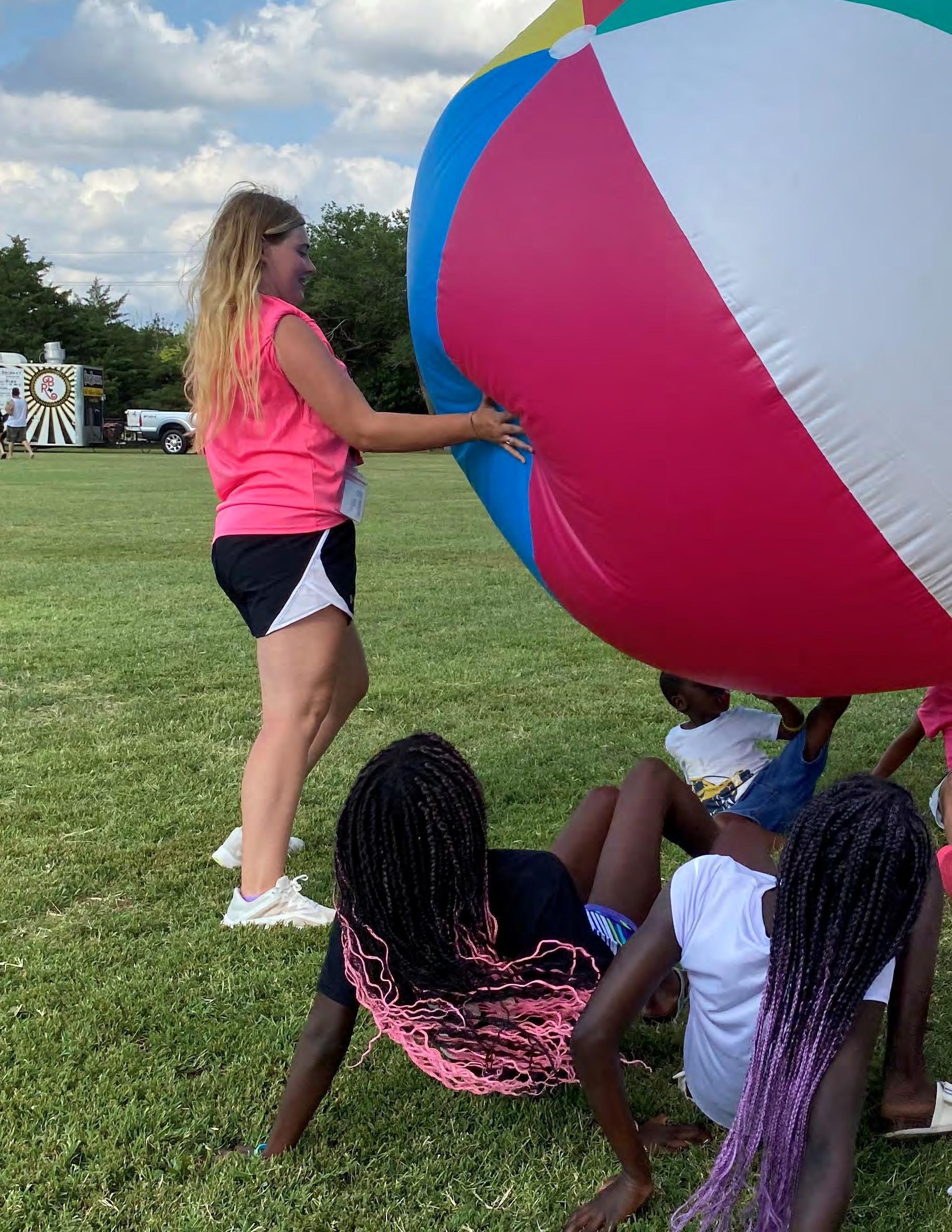

The City of Amarillo has experienced tremendous changes in the last ten years. Shifts in demographics, diversity, recreation, city leadership, development, community health, and economics have placed complex and growing demands on the City’s aging park and recreation system. With a community-driven mandate to renew park infrastructure and ensure all residents have access to the vital benefits of parks, the 2021 Parks and Recreation Master Plan introduces an investment strategy to protect Amarillo’s heritage and infuse vitality into the City’s park and recreation system.
In 2020, Amarillo—known as the City of Open Spaces and Endless Opportunities--found itself at a crossroads. Facing a $3.5 million annual funding deficit to repair and replace aging and worn park infrastructure, the City began evaluating options to “right-size” the park and recreation system. With a desire to continue providing the multi-faceted benefits of parks and recreation, City leaders and staff discussed a variety of options to reduce services to match available funding. Options included:
• Reducing maintenance at school parks, including those in underserved neighborhoods;
• Closing one or more of the City’s municipal golf courses;
• Reducing the City’s support of the beloved Amarillo Zoo;
• Removing restrooms or other comfort features in parks;
• Developing future parks as empty greenspace, without any amenities to maintain;
• Removing or not replacing any dilapidated or broken amenities, including playgrounds and sports field lighting.
Some of these elements were more in line with what seemed to be the core services of Amarillo’s Parks and Recreation Department. Others appeared to be stronger priorities for the community. This led to the question: how should the City of Amarillo prioritize its park investment?
The City of Amarillo began updating its Parks and Recreation Master Plan (Master Plan) to identify community priorities for investing in parks, trails, public art, recreation facilities and programs over the next 10 years. The arrival of COVID-19 in the Spring of 2020 introduced new challenges, but ultimately amplified the importance of this planning effort. More people than ever flocked to Amarillo’s parks, seeking destinations outside the home, respite and opportunities to exercise and gather in safe and healthy ways. At the same time, more people became aware of the challenges facing Amarillo’s park system, and more people demanded a voice in creating a solution.
The Parks and Recreation Master Plan defines community priorities for investing in parks, trails, public art, recreation facilities and programs over the next 10 years.

Amarillo parks support sports and fitness, healthy lifestyles, the beauty of the City, connections to nature, urban cooling/shade, recreation tourism, active transportation, the community’s cultural identity and many other benefits.
The Master Plan process included substantial outreach to community members to identify priorities for the City’s park system. Almost 23,000 participants and social media followers—including residents, park users, stakeholders, partners, advisory board members, and City Council members—were kept informed and involved in the planning process. Residents and advisory groups participated in meetings, workshops, surveys, and prioritization activities. The Parks and Recreation Department’s website, utility bill inserts, signage, social media posts, and email eblasts invited residents to participate and share their priorities.
Meetings and community engagement activities were held through all four phases of the planning process (see Figure 1) to:
• Define the community’s long-term vision for parks, recreation facilities, trails, arts and programs.
• Identify community priorities for park system enhancements and improvements.
• Develop a strategy to manage existing assets and provide new recreation opportunities consistent with community needs and priorities.
• Provide community-driven guidance to strategically invest in the park system over the next 10 years.
Bilingual Park and Recreation Survey: 2,368 participants
Prioritization Challenge: 6,904 participants
Community Solutions Work Session: 270+ participants
Stakeholder Interviews: 6 participants
City Council: 6 members
Parks and Recreation Board: 19 members
Park Board Strategic Planning Sub Committee: 6 members
Beautification and Public Arts Advisory Board: 10 members
Pedestrian and Bicycle Safety Advisory Committee: 7 members
Facebook: 8,270 followers
Parks & Recreation Stakeholder Contacts: 5,142 contacts

The Parks and Recreation Master Plan was underway in 2020 when COVID-19 health restrictions and Black Lives Matter protests across the country called attention to city needs to support community health, diversity, equity and resiliency.
Aligned with Amarillo’s goals to understand and support the needs and priorities of every segment of our community, City leaders slowed down the project to encourage more residents to have a voice in the planning process. Now, the Master Plan moves forward with urgency and purpose in providing policies and strategies to create, implement and maintain a healthy, equitable and inclusive park and recreation system.
Amarillo staff and elected officials recognize that great parks are needed to respond to diverse recreation priorities and preferences across the city. This Master Plan creates a new vision for a great park system. However, when faced with the difficult choices of where to cut, sustain, or enhance parks and recreation opportunities, City staff needed a set of guiding principles to inform decision-making.
The following principles emerged through community outreach and plan development. They provide a foundation for the City’s goals, objectives and actions for the future. These guiding principles also introduce the “evaluation lenses” though which community needs were vetted to ensure equitable opportunities for all and a sustainable park and recreation system.




ensuring the wise use of our assets and resources
creating parks and programs that reflect community culture
providing park benefits and play opportunities for all
enhancing trail connections through the city and beyond
Figure 2: Guiding Principles




supporting healthy lifestyles, including individual and community health
cultivating community through events and activities
regaining park system vitality amidst adversity and challenges
Enrichment
promoting quality park experiences and Amarillo’s identity
All residents should have access to quality parks and relevant recreation activities and programs that meet their current and evolving recreation needs. However, the challenge in implementing this vision is to create a realistic action plan that balances these ideals with a focused investment strategy. This Master Plan describes the new investment strategy and gives the City of Amarillo the direction it needs to apply resources where needed most to support parks and recreation.



With smiles and shrieks of joy, Amarillo residents welcomed the grand opening of Thompson Pool on July 24, 2021. Families, friends, and residents from across the city floated in the lazy river, navigated spiraling slides, and played in the cool blue waters that provided respite from the heat. The pool replaced an 87-year-old facility that had been “loved to death.” The pool’s construction in the midst of the pandemic is a powerful symbol of the City’s resilience and resolve to invest in parks and recreation to support Amarillo’s quality of life.
In the final phase of Master Plan development, City staff initiated a public information campaign throughout the city, using posted signs and red X’s taped on facilities in parks. The red X signified the risk that, without more funding, the City of Amarillo would need to close, remove, or reduce maintenance responsibilities for some types of park amenities and facilities. The intent was to draw attention to the severity of City park needs and to invite residents to help prioritize future park investment.
Recognizing the City would not be able to fund everything, residents were asked to complete a Prioritization Challenge and assign project priorities to various types of park amenities and facilities. The results of this survey were clear: not only did respondents expect the City to maintain and replace old and worn facilities, 69% supported an increased level of investment to fund park enhancements (Figure 2).

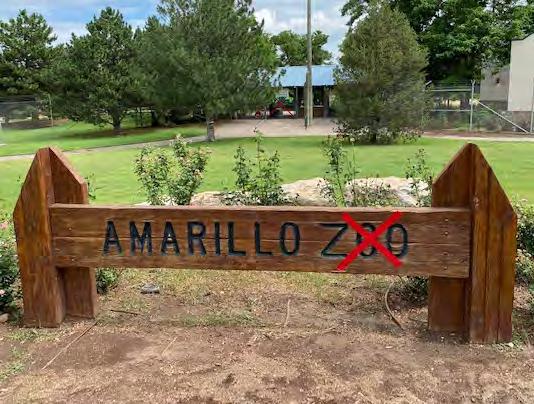
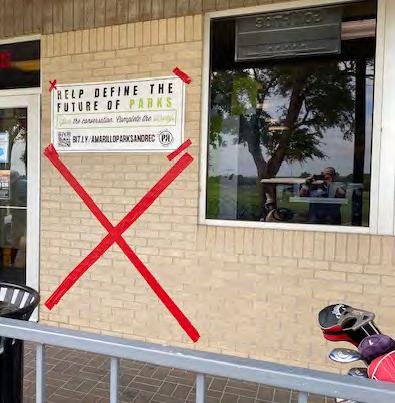
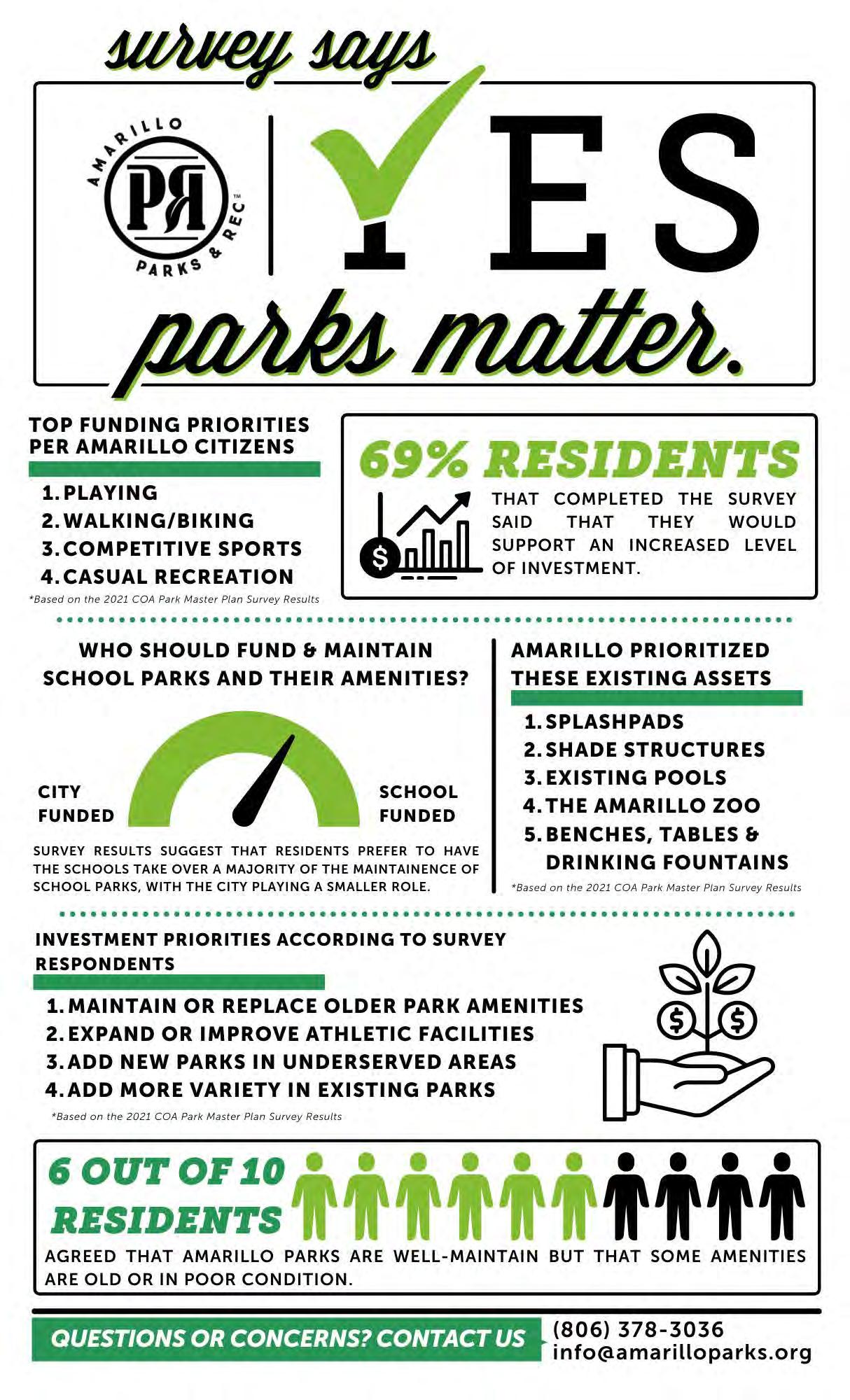

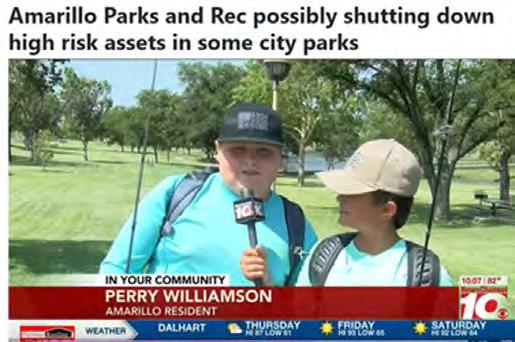
The following strategic plans were completed concurrently with the Master Plan process to be able to coordinate capital projects. These appear under separate covers.
• Amarillo Hike and Bike Plan
• Amarillo Public Arts and Beautification Plan
• Amarillo Zoning Ordinance
Amarillo residents were also invited to a Community Solutions Work Session to talk to City staff and Council members about their park priorities. Hundreds attended and lined up to provide hours of testimony on the elements of the park system they value most.
With such strong support for keeping parks and facilities open and functioning, City staff and Council are already exploring options to invest in the most critical assets, as guided by the priorities in this Master Plan.
As defined in the last two chapters, the Master Plan investment strategy is conservative and strategically built around five key actions:
i. Increase dedicated funding for existing and new parks
ii. Reduce non-core services and subsidies
iii. Increase revenues to reinvest in park operations
iv. Focus on City’s service niche (avoiding high-risk ventures)
v. Continue to communicate and collaborate with key partners
Investment in priority projects, matched by a reduction in non-critical services, will provide resources needed to improve and enhance park opportunities to benefit residents citywide.
CHAPTER 1: Our Park Heritage introduces the planning process and purpose of the Master Plan.

CHAPTER 2: Our People, Our Parks provides an overview of our community, our park system, and the level of service provided by our parks, facilities, and programs.
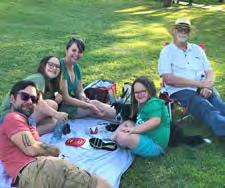
CHAPTER 3: Our Priorities presents the new vision and goals for the park and recreation system, as supported by the key findings that emerged from the public engagement process.

CHAPTER 4: Our Park Investment Strategy defines a new park investment matrix that classifies each City park by type, intent, level of investment, cost recovery expectations, development guidelines, and service tier for park maintenance.

CHAPTER 5: Our Park Action Plan describes the key moves for right-sizing the City’s investment, along with key projects and a prioritization process for implementation.

APPENDIX A: Park and Facility Inventory summarizes assets within all City-owned parks and other school parks maintained by the City Parks and Recreation Department.

APPENDIX B: Facility Condition Assessment presents relevant highlights by site from the Park Asset Management Plan.

APPENDIX C: Equity and Access Analysis presents the mapping analysis of high-need areas that factor in racial diversity, poverty, residential density and park access.

APPENDIX D: 10-Year Goals, Objectives, and Strategies defines a comprehensive set of systemwide goals, objectives and detailed strategies to guide the provision of parks, recreation, and related services for the next ten years and beyond.
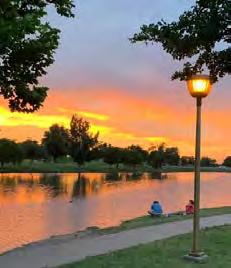
APPENDIX E: Recommended Park Dedication Requirements presents supplemental material to the City’s Zoning Ordinance (currently under review) to guide new park development.

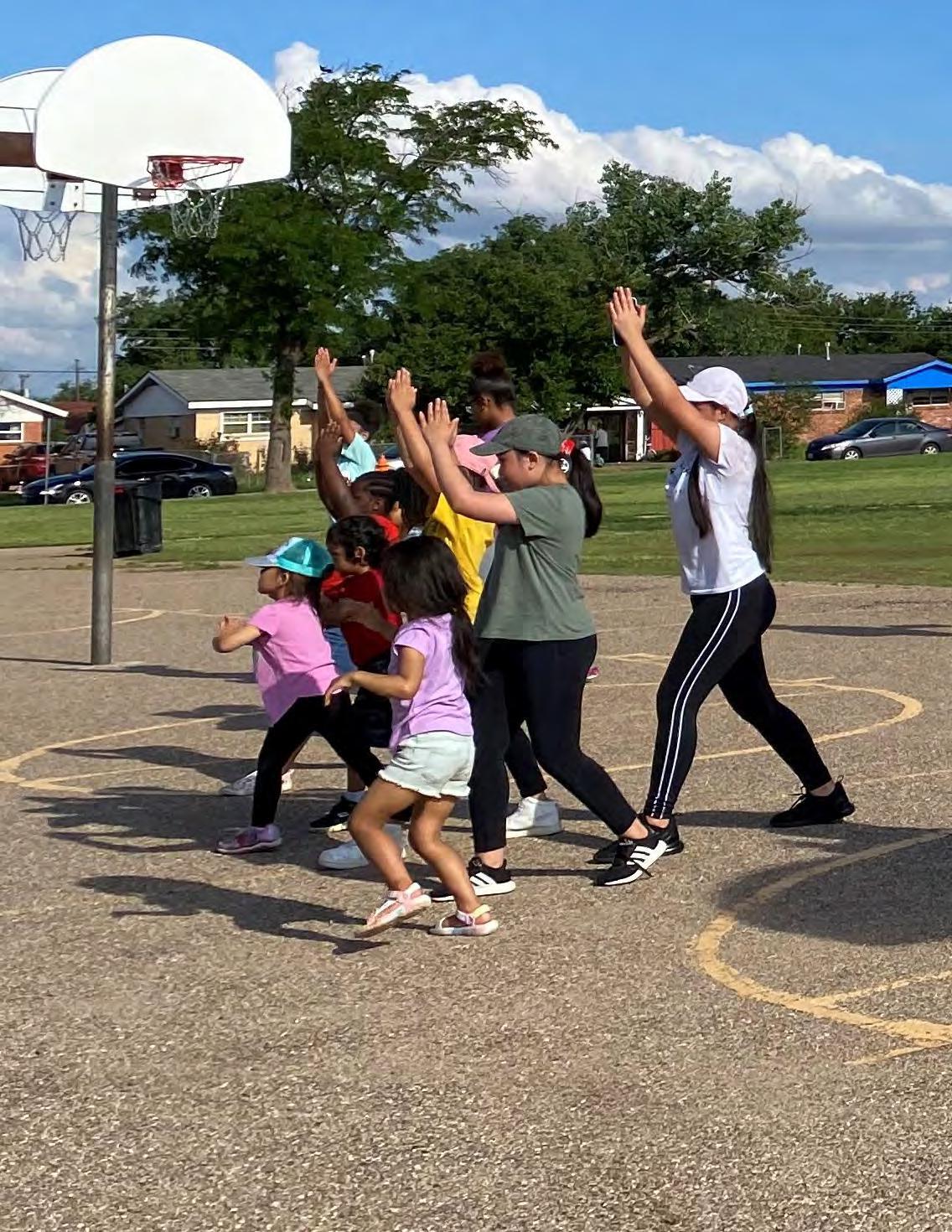
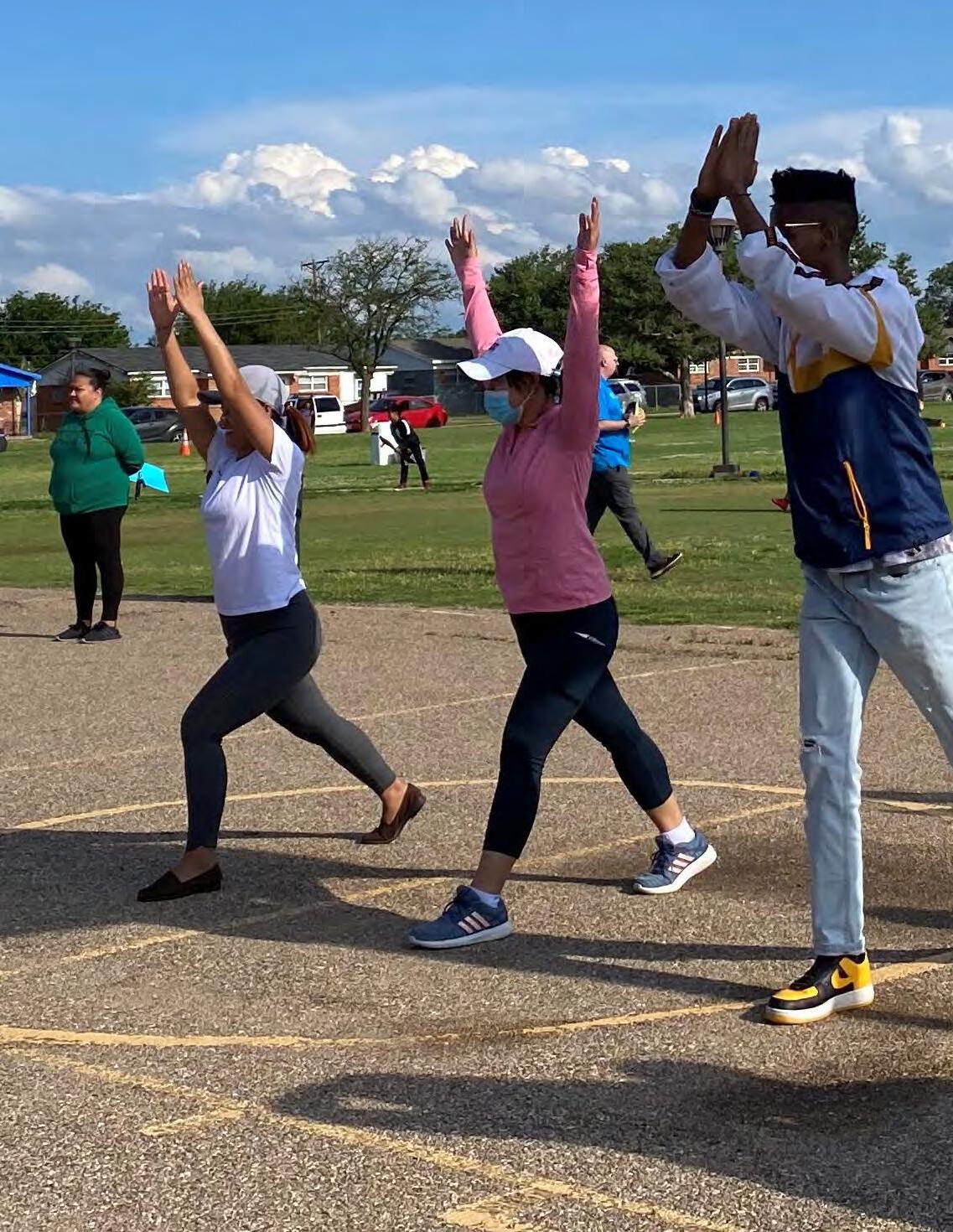
As a sun-washed fusion of old and new West, Amarillo is a diverse, family-friendly community, where playing sports and enjoying barbecues are great ways to spend a day at the park. As the City has grown more diverse, sports and recreation preferences are evolving. From baseball to kickball and soccer to sepak takraw, new amenities and activities are popping up in parks. To understand park needs, this chapter provides an overview of the community and a status report on the park system to provide insights into opportunities and challenges for City parks in the future.
Amarillo is the largest city of the Texas Panhandle, with more than 206,385 residents.1 Home to the iconic Big Texan Steak Ranch, Hoof Prints art display, and the Amarillo Zoo, the former cowtown is also the destination for numerous refugee resettlements. The city’s diverse heritage and demographics affect park and recreation interests as well as participation in recreation activities.
Demographics diversity influence community needs for new and enhanced parks, facilities, trails, active and passive recreation, art, programs and events.
27% of residents are under the age 18
35.8% of households have children
54% is White, not Hispanic or Latino
33% is Hispanic or Latino
7% is Black or African American
8.5% is another race or origin
21.2% of households earn $100,000+ per year
21.9% of households earn $24,000 or less per year
75+ languages are spoken
7.7% residents under 65 have a disability
15% residents live in poverty
4.6% is the rate of slow growth over the last 10 years
Amarillo has more refugees per capita than any other city in Texas (Figure 5)


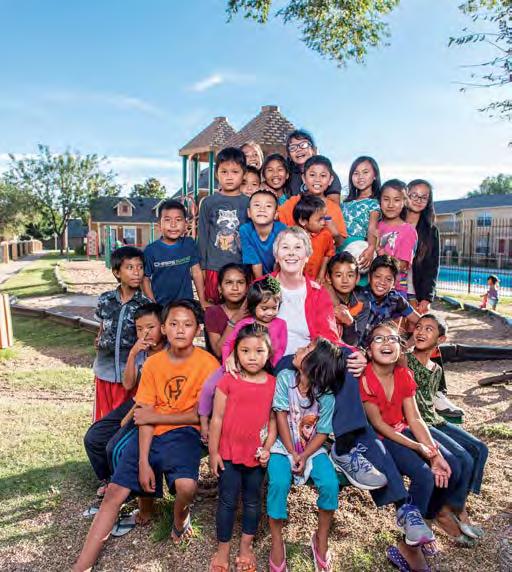
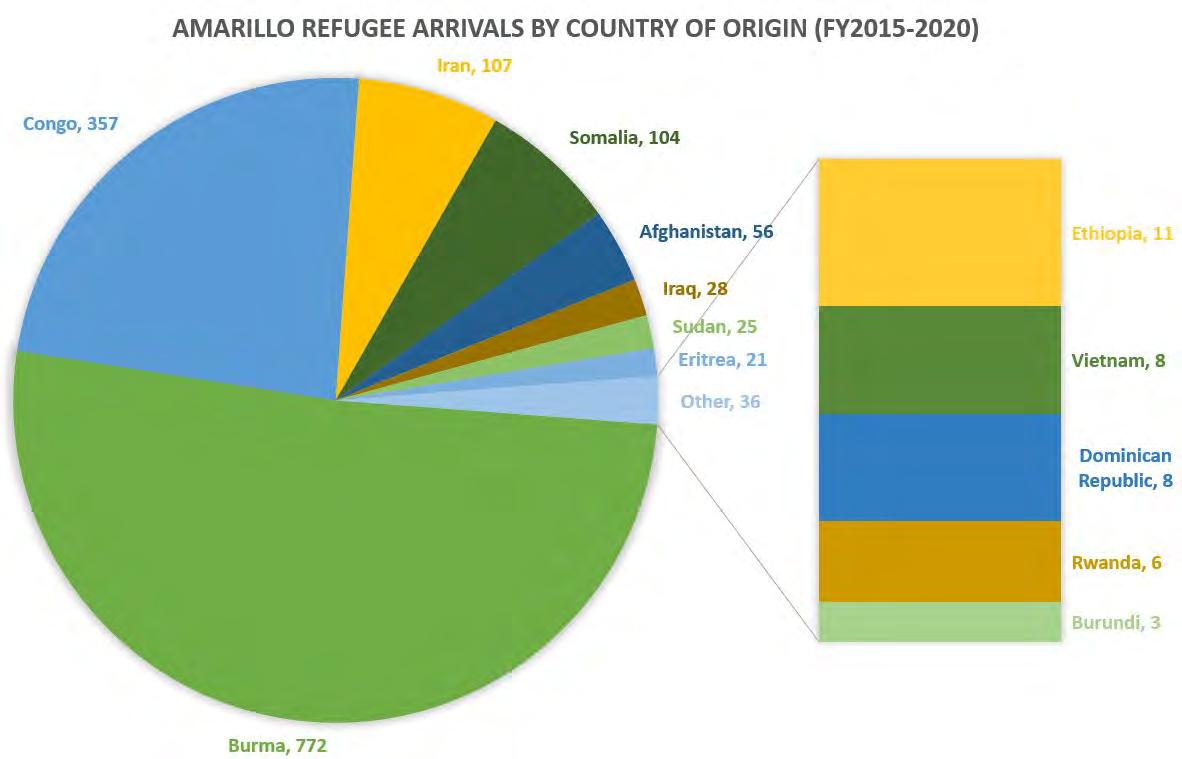
Figure 5: Amarillo Refugee Arrivals by Country of Origin (2015-2020)
Source: Refugee Language Project, https://refugeelanguage.org/about/amarillo/
Amarillo’s racial diversity and varied household socioeconomics affect the community’s recreation spending. This is clearly shown through ESRI’s Tapestry™ Segmentation, which characterizes U.S. neighborhoods and their market preferences by classifying them into 67 unique segments. While recreation spending varies widely across all markets in Amarillo, four of the five most prevalent groups in the city spend well below average in comparison to other U.S. households (Table 1).

1 The Diversity Index summarizes racial and ethnic diversity. The index shows the likelihood that two persons, chosen at random from the same area, belong to different race or ethnic groups. The index ranges from 0 (no diversity) to 100 (complete diversity).
2 The spending index compares the average amount spent in this market to the average amount spent by all U.S. households. An index of 100 is average. An index of 80 shows that average spending by consumers is 20 percent below the national average.

• Programs for children and youth (for young and single-parent households)
• Multi-generational activities and experiences
• Low-cost and no-cost recreation options
• Music, cultural fairs and festivals in the park
• Parks within walking distance
• Trails for commuting
• Trending activities
• Sports such as soccer
Figure 6: Potential Recreation Preferences of Top 5 Market Segment
• Activities for adults and seniors
• After-work activities (lighted facilities)
• Online gaming and app-based activities
• Low to moderate-cost recreation options
• Park events and concerts
• Conveniently accessible parks
• Traditional, annual events

• Activities for younger and older adults

• Activities for younger adults
• Information via social media and smart phone apps
• Low to moderate-cost recreation options
• Conveniently accessible parks
• Outdoor activities, e.g., fishing and visiting the zoo
• Information via social media and smart phone apps
• Moderate-cost recreation options
• Parks within driving distance
• The arts, theater, travel, and lifelong learning opportunities
• Concerts in the park
• Gardening and volunteerism


• Programs for children and youth (for young and single-parent households)
• Activities for younger families
• Parks that reflect ethnically and racially diverse characteristics
• No-cost recreation options
• Parks within walking distance
• Sports such as NASCAR racing, professional wrestling, and basketball
Figure 6 (continued): Potential Recreation Preferences of Top 5 Market Segment
The City of Amarillo owns approximately 2,400 acres of park land at 52 sites. These parks provide a variety of recreation experiences, including close-to-home play space, destination parks, and major facilities that attract people from throughout the city and region. The adjacent map shows the distribution of parks and major facilities.
• Parks include publicly accessible sites managed by the Parks and Recreation Department for recreation, sports, and open space.
• Major Facilities are buildings or recreation complexes within parks that require a greater investment in maintenance, operations, staffing, and programming. The map calls attention to the Community Center, Zoo, swimming pools, Tennis Center, and BMX Raceway. The City’s golf courses and clubhouses are also counted as major facilities.
Amarillo’s existing park system is anchored by six regional parks, which provide the majority of park acreage. The City also provides community parks and facilities, plus neighborhood-serving sites that include City-owned parks and joint use school parks.



The City of Amarillo classifies it parks in four main categories: Regional Parks (RPs), Community Parks (CPs), Neighborhood Parks (NPs), and Other Parks (OP). Several of these have subclassifications that distinguish site function and ownership status. Appendix A provides details on every site by classification, including the types of recreation facilities and amenities present at each site.
Regional Parks: Larger parks that attract visitors from the entire city and surrounding region.
John Stiff Memorial Park, Thompson Memorial Park, Medical Center Park, Rick Klein Athletic Complex
Community Parks: Mid-size parks and special use facilities that serve a portion of the city. Multi-Use Community Parks
El Alamo Park, Memorial Park, Southeast Softball Complex Community Facilities
Centennial Plaza, Ross Rogers Golf Complex, Warford Activity Center, Southeast Pool
Neighborhood Parks: Smaller parks that serve nearby neighbors within walking or biking distance.
Mary Hazelrigg Park, Paramount Park, Sam Houston Park
Belmar School Park, Ridgecrest School Park, Willow Vista School Park Other Parks: Recreation space and/or greenspace reserved for other uses.
Open Space and Sites 3
Wonderland Amusement Park, Vest Pocket Park, NE 17 Avenue Open Space
Julian Parkways, Rock Island Rail Trail
Note: The complete park and facility inventory is located in Appendix A, Table A-1
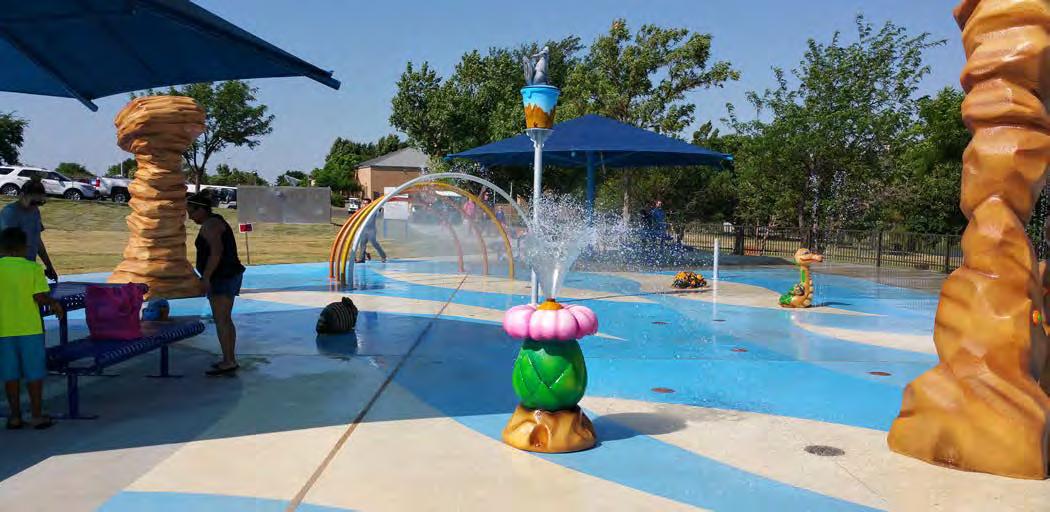
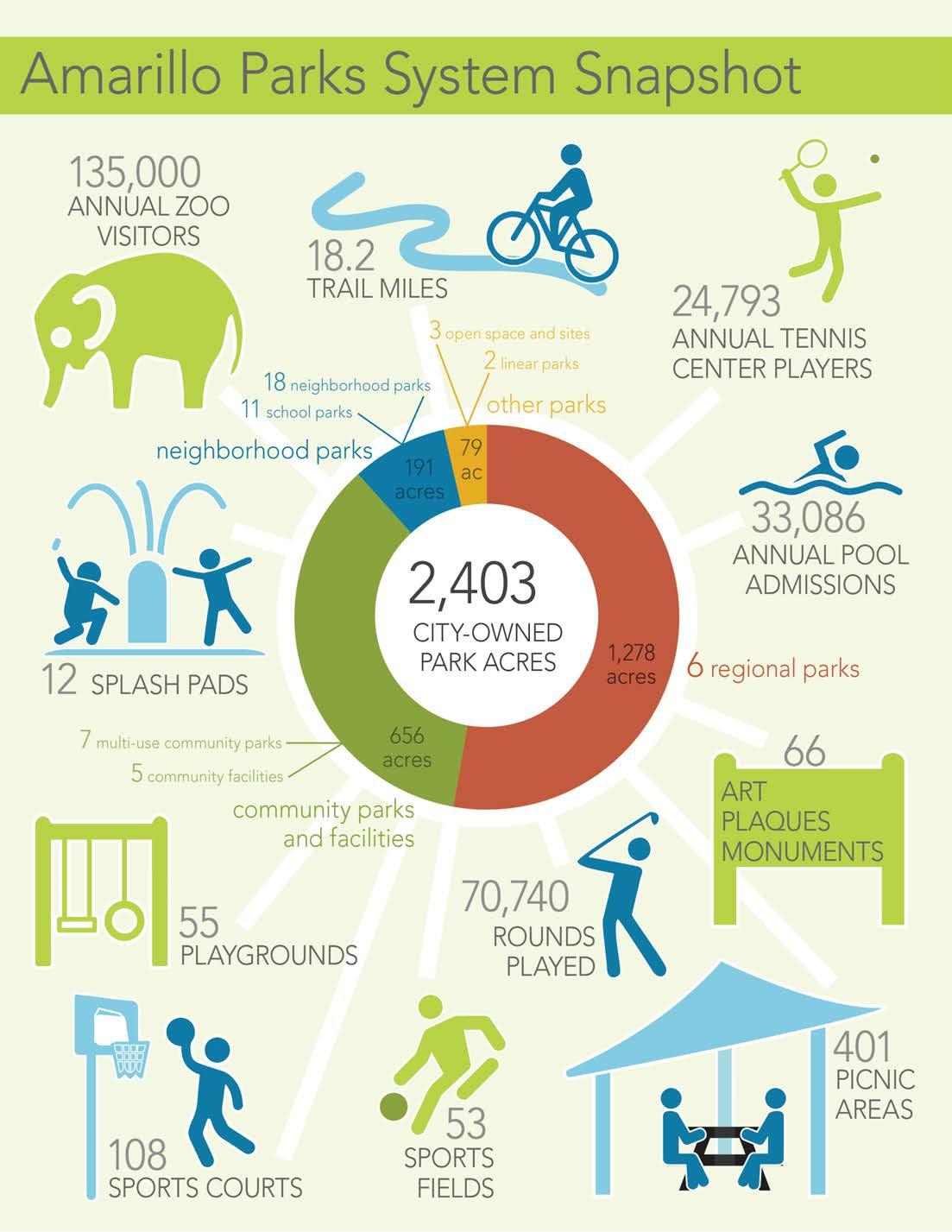
The City maintains 28 outdoor school properties to support close-to-home recreation. These “school parks” include 11 sites that are owned or jointlyowned by the City, along with 17 sites entirely owned by one of three school districts:
• Amarillo Independent School District (AISD)
• Canyon Independent School District (CISD)
• River Road Independent School District (RRISD)
School parks have ensured that amenities such as playgrounds and sports courts are available for local use. In past park maintenance and stewardship practices, the City did not differentiate between City-owned, jointly-owned, or school-district owned sites. While the Parks and Recreation Department has typically been responsible for park maintenance at all sites, it also has invested in park projects (e.g., playground replacement or facility development) at selected sites.
Note: The complete school park inventory is located in Appendix A, Table A-2.
*Acreage based on numbers as determined by the Potter-Randall Appraisal District. School acres include the entire school property, not the school park alone.

Amarillo’s parks include several recreation facilities and complexes that provide specialized recreation opportunities. These facilities house most of the City’s indoor and outdoor recreation programs and enrichment services. While facility programs generate revenue, the facilities require a greater investment in maintenance, operations and staffing. Highlights are noted below.
Amount: 1
Level of service: 1 center per 206,385 residents
Participation Statistics:
• Average daily passes per month: 106
• Memberships: 99
Amount: 4
Level of service: ~ 1 pool per 50,000 residents
Participation Statistics:
• Average pool admissions: 33,086
Amount: 4
Level of service: ~ 1 course per 50,000 residents
Participation Statistics:
• Total rounds of golf played: 70,740
• Rounds increased by 4,145 over the previous year (even being closed for a month due to COVID)
Amount: 7
Level of service: ~ 1 facility per 29,500 residents
Participation Statistics:
• Average daily passes per year-round volleyball: 3,474 players
• 3-season softball: 4,831 players



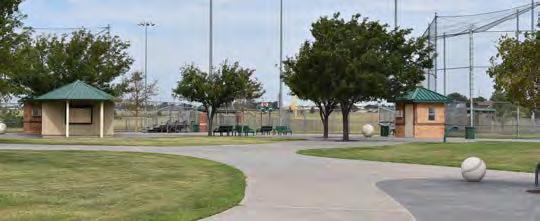
(managed by other operators or in conjunction with partners):


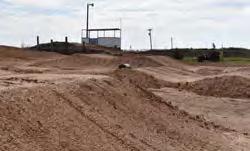
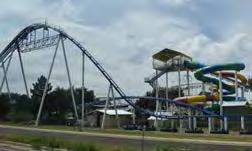
The City of Amarillo provides or facilitates several different types of programs and events for the community. Most of these are fee-based classes and camps, league play, drop-in activities, group events and volunteer opportunities. Most programs are offered at the City’s outdoor pools, sports fields and courts, golf course, and event spaces. Fewer are offered indoors at the Warford Activity Center and Pool.
Table 4 describes core program areas currently supported by the Parks and Recreation Department.
• Adult Sports & Fitness
• Aquatics
• Golf
• Special Events
• Volunteerism
• Youth Activities and Programs
Table 4: City of Amarillo Core Recreation Programs and Events Definition
Examples of Organized Programs, Activities and Events Program Area
Adult Sports and Fitness Recreational and competitive sports, including men, women and coed leagues, tournaments, and classes
Aquatics Indoor and outdoor pool events and programs
• Year-round outdoor volleyball and tournaments
• 3-season softball leagues and tournaments
• Basketball and pickleball leagues
• Adult tennis classes and leagues
• Warford fitness passes and memberships
• RESET fitness in the park
• Swimming lessons for all ages and abilities
• Recreational swim
• Water safety programs, such as Junior Guard program training youth about CPR, First Aid and water rescue
• Pool events, such Superhero Night
Golf Daily and annual rounds of golf, tournaments and events
Special Events Fairs, festivals, and neighborhood and community activities in parks
• Rounds of golf (daily, memberships)
• Junior Golf program
• Special programs, such as Golf Happy Hour
• Golf tournaments, corporate and charity events
• National Night Out
• Free Concert Series at Sam Houston Park
• Movies in the Park at various locations
• Hooked on Fishing
• Community events at the Zoo
• Doggy Days
• Hocus Pocus in the Park
Volunteerism Ongoing or one-time volunteer involvement or participation
Youth Activities and Programs After-school and summer programs, including child and youth development and leadership
• National Clean Up Day
• Tree-planting program
• Event support
• Youth sports camps for youth ages 5-13
• Fishing camp at Medical Center Park
• Tennis camps at multiple parks
• Summer safari camps at the zoo
• Job Fair Training
• Afternoon Adventure Camp
• Lego Engineering Camp
EVENTS, PROGRAMS AND ACTIVITIES
Starlight Theater: 9,910 (12 events)

Starlight Cinema: 1,228 (4 events)

Easter-Eggcitement: 3,328

Earth Day volunteers: 60

Easter-Eggcitement volunteers: 90

9,895

Hooked on Fishing: 30 kids per camp

Summer Recreation Camps: 11,509

Athletics (baseball, volleyball, softball): 10,200

Tennis Camp: 200

Sports Camps: 97

Summer Safari Camps: 92

Amarillo’s Parks and Recreation Department manages an extensive park system with many large parks, substantial greenspace and a variety of amenities and facilities. Expansive parks support Amarillo’s brand as the City of Open Spaces and Endless Opportunities. With finite resources to support park operations, how does the City fare in meeting the full spectrum of park and recreation needs?
Amarillo surpasses other cities in some aspects of providing quality parks and recreation opportunities. A technical analysis of the park system, however, reveals areas where the City has not been as successful in meeting community needs. The scorecard below (Figure 9) shows these differences.
Overall, the City has been relatively successful in providing parks, facilities, and activities and able to satisfy community expectations. This results in the overall fair/satisfactory rating across the park system. However, the challenge the City is facing in maintaining parks and replacing worn and aging assets has the potential to offset the other high scores and benefits provided.
Each element of the scorecard is explained on the next several pages.
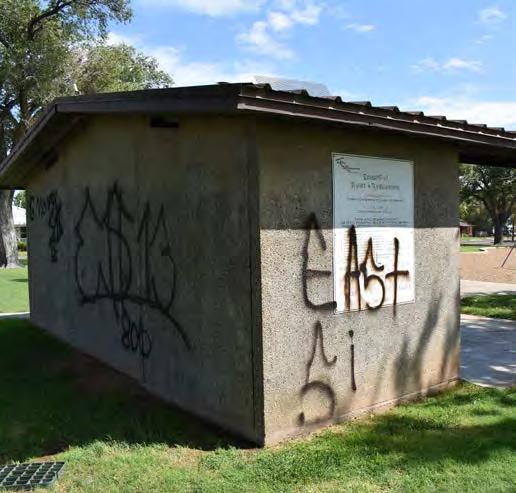
Maintenance
The Parks and Recreation Department provides ongoing short-term and long-term stewardship for the City’s park assets, landscaping, and infrastructure.
• Routine and preventative maintenance includes the daily and periodic tasks undertaken to ensure sites remain usable for recreation and leisure. This includes tasks such as mowing, weeding, litter pickup, restroom cleaning, graffiti removal, sports turf maintenance, irrigation, tree pruning, natural resource stewardship, specialized facility maintenance (e.g., pool water quality management and janitorial care of buildings), as well as minor facility repair to keep parks operational.
• Asset management includes the more extensive repair, renovation or replacement of old, worn or damaged facilities that is needed over time.
All parks require maintenance to take care of assets and landscaping. However, parks with higher levels of use, specialized facilities, reservable facilities, and organized programs and events require a greater level of maintenance.
The Parks and Recreation Department’s budget and staffing are insufficient to take care of park assets. Assets that are not routinely maintained deteriorate more quickly, resulting in a greater amount of “deferred maintenance” that requires more extensive repair or replacement (Figure 10).
HIGH RISK
$48,703,016 3,074 assets
MEDIUM
$41,763,119 11,882 assets
LOW RISK
$11,981,764 1,000 assets
An Asset Management Plan (AMP) conducted by Kayuga Solution in 2019 identified the condition of Amarillo’s park facilities and assets. The study found that approximately a quarter of park assets are in poor condition or failing. This percentage has increased since the AMP was completed. As facilities have continued to age, it is estimated that about $50 million is needed immediately to repair or replace “high risk” assets in 2021. On average, another $3.5 million will be needed annually to keep up with asset management needs as “medium and low risk” assets age.

Amarillo provides an expansive amount of parkland. Most of it is tied up in regional parks. To see if a city is providing the right amount of park land, a metric known as Level of Service (LOS) is used. For park land, LOS is presented as a ratio of park acres per 1,000 residents served.

Source: Kayuga Solution, 2019. See Appendix C for a summary of deferred maintenance needs by site.
• Amarillo has more park land than on average for cities of a similar size.
• The City exceeds its own standards for the amount of park land provided.
• The City is below its targets for neighborhood parks, but above for regional and community parks.
Amarillo’s park LOS can be compared to cities of a similar population size by using Park Metrics data provided by the National Recreation and Park Association (NRPA). Amarillo exceeds the median LOS of park agencies serving populations of 100,000 to 250,000 and is closer to the upper quartile of all agencies measured by Park Metrics in the United States.
• Median LOS of Similar-Sized Agencies: 8.9 acres per 1,000 residents
• Amarillo’s LOS (without schools): 11.3 acres per 1,000 residents
• Upper Quartile LOS Similar-Sized Agencies: 14.9 acres per 1,000 residents
*The park acreage that is owned by the School Districts but maintained by the City of Amarillo is unknown.
**The existing level of service (LOS) for park land is based on a 2020 population of 206,385.
***In 2012, the City set minimum standards for community parks (1 acre per 1,000 residents), neighborhood parks (2 aces per 1,000 residents) and school parks (2 acres per 1,000 residents), along with a total of 10 acres per 1,000 residents.
Another way to measure the sufficiency of park land is based on the percentage of residents who have access to a park within walking distance from home. This metric helps understand whether the City offers the right number and distribution of parks. Research shows that park proximity improves park use and increases health benefits.
The National Recreation and Park Association (NRPA) and the Trust for Public Land (TPL) have championed the industry standard of providing parks within a 10-minute walk (½ mile) of all residents. This distance is typically the farthest Americans will walk on average to get to a destination. According to TPL’s ParkServe data, less than half of Amarillo residents live within walking distance of a park, which is below the national
average. This could be in part because Amarillo’s standard is based on providing a park within 1 mile of most residents.
NRPA also notes that the typical agency provides one park for every 2,281 residents. Because Amarillo’s acreage is mostly provided in large regional parks, it falls short on this metric. Amarillo provides one park for every 5,034 residents (not counting school parks). However, it provides 1 park for every 2,991 residents if all school parks maintained by the City are counted.
NRPA Recommended Standard: provide parks within a 10-minute walk (1/2 mile)
Amarillo’s 2012 Adopted Standard: provide parks within a 20-minute walk (1 mile)

Using Urban Footprint, the Master Plan Needs Assessment created a series of maps to evaluate city areas that are served and unserved by parks. Appendix C presents the maps and findings of the access and equity analysis. Since population demographics, density, poverty and similar factors affect travel to parks, the map includes a look at key demographic and other statistics across the city.
Maps include:
• Walking access to Amarillo-owned parks
• Unserved residential areas (based on all Amarillo-owned parks)
• Walking access to all Amarilloowned neighborhood-serving parks
• Unserved residential areas (based on Amarillo’s neighborhoodserving parks)
• Percent of population below the poverty level
• Percent of population that identifies as Hispanic
• Percent of population that identifies as African American
• Percent of population that identifies as Asian American
• Less than half of residents have a park within a halfmile walking distance.
• The City owns fewer parks per capita than on average in the U.S.
• While some residents in Amarillo may typically drive to parks, residents in “high needs” areas have a greater need for parks within walking distance.
• In some areas, school parks play an important role in meeting needs in “high needs” areas.
• Other school parks are not needed to meet City standards.
• City-Owned Neighborhood-Serving Gap Analysis
• 10 and 20-minute walksheds for City-owned neighborhood parks
• 10 and 20-minute walksheds for City-owned neighborhood parks and school parks
The maps included “neighborhood-serving parks” since Community Parks and portions of Regional Parks also meet the needs of residents who live nearby. The detailed assessment evaluated every gap area in terms of its “severity of need” using equity metrics. The analysis also identified other nearby opportunities to meet park needs, including the locations of proposed or planned parks to serve new growth areas. This analysis helped identify critical gaps in service.
Map 2 shows the importance of school parks in meeting local park needs in many parts of Amarillo.
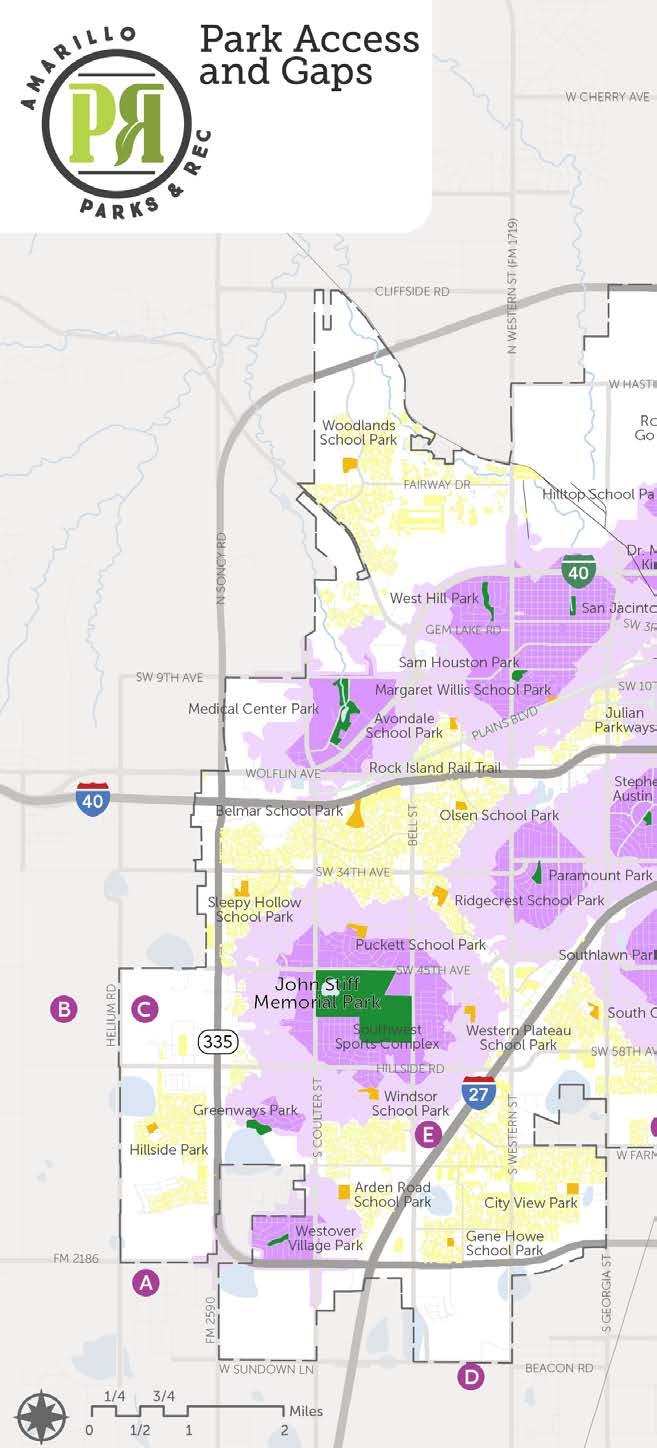
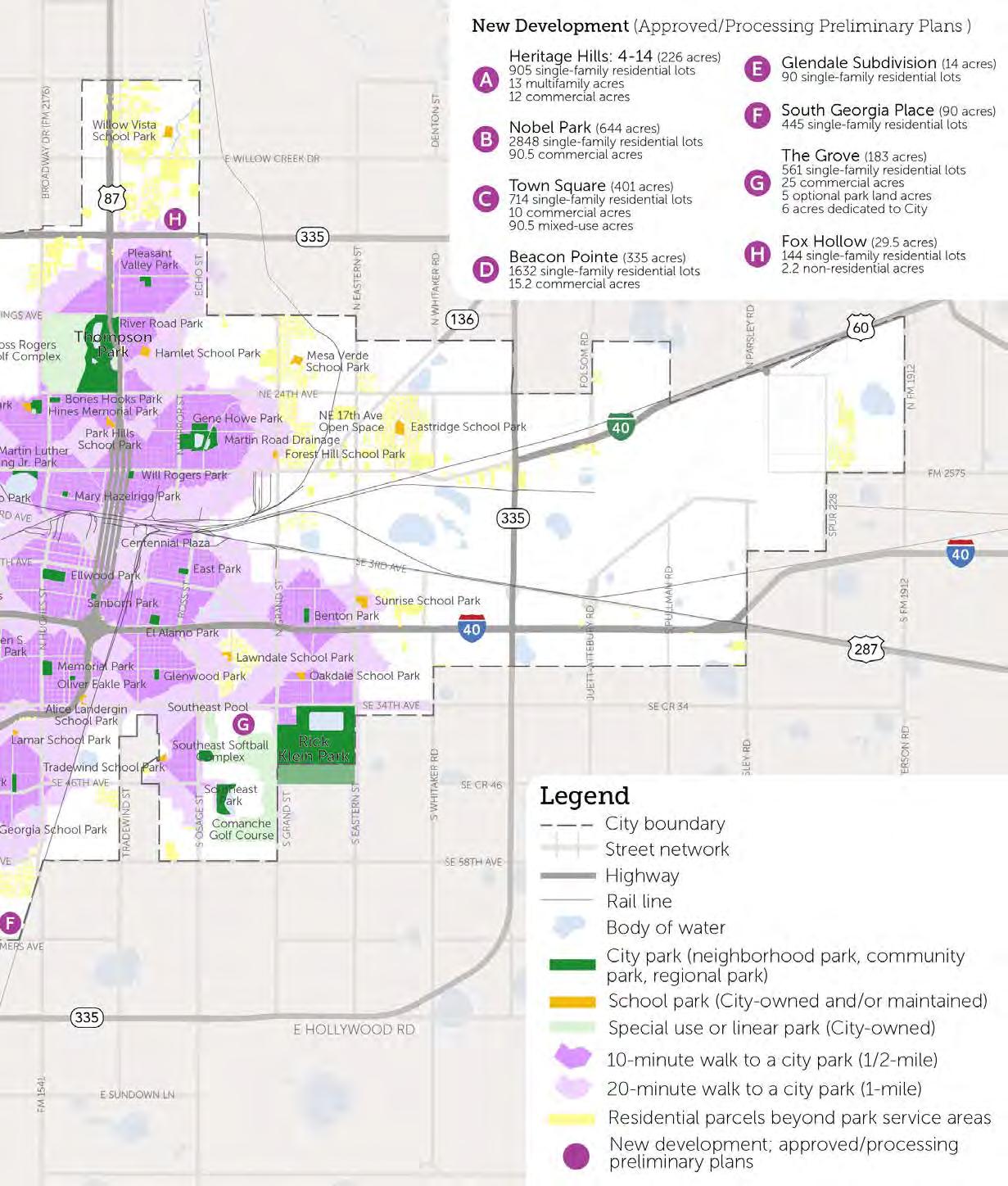
The City of Amarillo provides a good variety of major facilities, outdoor facilities, and support amenities in its parks, ranging from playground to splashpads and active to passive amenities. Still, a September 2019 park tour noted many opportunities to diversify and enhance facilities in parks:
• The City has expansive amounts of park land with lots of turf. Some sites are underdeveloped, providing opportunities to naturalize, develop, or repurpose some park areas for different uses.
• Most parks support traditional outdoor recreation uses (baseball/softball, play, picnicking). There is an opportunity to consider new trends and future uses when replacing/repairing existing amenities and facilities, such as:
a. Challenge opportunities that appeal to teens and young adults, such as ziplines, climbing walls or spires, bike pump tracks, mountain biking trails, and skate spots.
b. Activity hubs, such as outdoor ping pong, chess, giant Jenga, game tables, bocce courts, tai chi courts, etc.
c. Unique play features, such as nature play areas, thematic destination playgrounds, adventure play areas, hand-pumps for water play, and universal, all-inclusive playgrounds.
d. Unique social gathering spaces, such as long tables, movable tables and seating, group fire pits, and giant reservable pavilions, dog parks with food concessions.
e. Greater connections to nature, such as interpretive trails, wildlife viewing areas, bird blinds, canoe/kayak rentals, outdoor group camps or classrooms, ADA accessible fishing platforms, etc.
f. Non-traditional sports fields and courts, such as cricket, sepak takraw, futsal, rugby, and lacrosse.




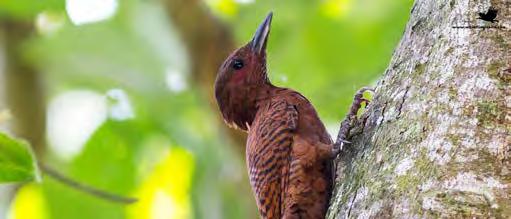
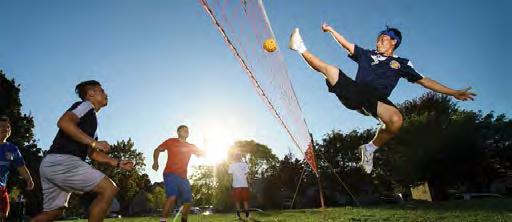
• There is an opportunity for Amarillo’s parks to better reflect the cultural and ethnic diversity and the needs of residents of varying ages and abilities. El Alamo Park is a great example of a park that does this well.
• Shade and more comfort amenities area needed at most parks to increase use. However, restrooms are provided in many parks across the system—including neighborhood parks-increasing park maintenance needs.
• The City invests in the urban tree canopy and has a forestry crew to help maintain trees that provide significant shade. Beyond that, there are opportunities to improve habitat, ecological function, and nature-based recreation activities such as fishing. Few drought-tolerant plantings were noted; and drought (or rising water costs) could significantly damage park landscaping and natural features.
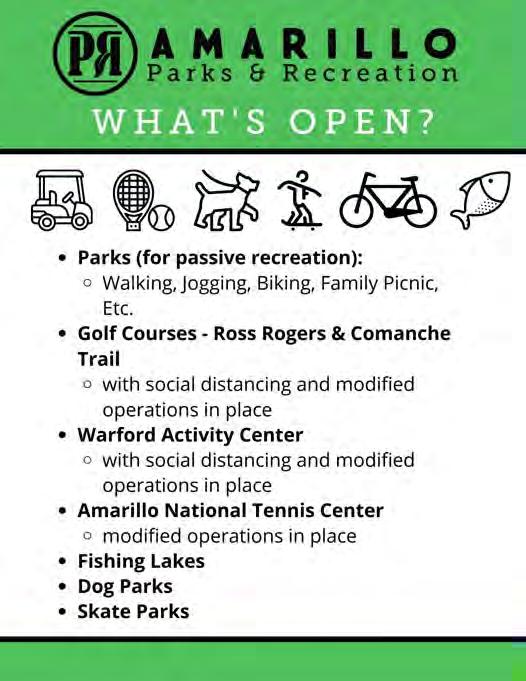
• Better infrastructure to support community events and outdoor recreation programs are needed. This may include plazas with utility hookups, natural amphitheaters with seatwalls/ grass seating, shaded pavilions with movable tables to serve as program space, etc.


Given facility closures during the pandemic, COVID-19 reminded residents of the importance of having open, accessible, high-quality amenities and facilities in parks.
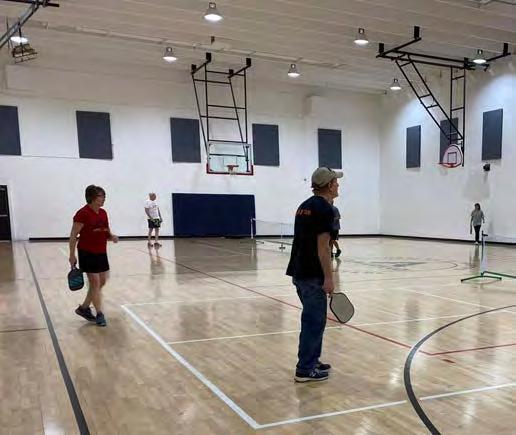


The City of Amarillo is significantly short on indoor recreation space. It does better in providing other types of major recreation facilities, such as golf courses, sports complexes, and pools. While more recreation opportunities may be desired, the challenge for major facilities is to ensure their affordability in operations and asset management, as recreation trends continue to change.
• Recreation and Community Centers: With the exception of managing the Warford Activity Center, the Parks and Recreation Department is not in the business of providing indoor recreation programs and services. Private entities are meeting this need, offering memberships and fee-based services. While those who cannot afford private opportunities are left underserved, the City is not in position to increase its services as an indoor facility manager or provider.
• Aquatic Facilities: Swimming participation continues to be strong across the United States, but pools are costly to operate. When updating pools, cities strive to maximize revenues through facility design and programming. Nowadays, recreation and waterplay features typically account for most swimming participation. Warmer water temperature, a zero-depth entry, float channels, and interactive play features—such as those added at the new Thompson Pool--encourage recreation and increase revenues. Learn-to-swim and water-based fitness programs also garner strong participation requiring sufficient shallow water. Elements such as party rooms, cabanas, rentable water play toys, pool events, snack bars, ample deck space, and other revenuegenerating features may be added to reduce operational subsidies.
• Golf Courses: Over the last ten years, golf has been declining across the United States. Many municipal golf courses have focused on enhancements at existing courses to increase play, such as Start New at Golf training courses, Top Golf-style driving ranges, added tournament and social space, and even disc golf or foot golf. In some cities, golf courses have

been converted to multi-use community parks. However, many golf courses have experienced a resurgence in play during the pandemic. The City of Amarillo needs to continue to monitor participation rates to determine future options for its courses.
• Tennis Center: Trends in tennis are mixed. In some parts of the United States, older tennis courts are being repurposed as futsal or pickleball courts because participation in tennis is declining. However, in Asian cultures and advantaged areas, tennis participation remains strong. For the Amarillo Tennis Center, the facility may explore options to diversify uses and/or increase learn-to-play opportunities to increase use.
• Sports Complexes: Over the last ten years, the seasonality of field sports has shifted, with many competitive sports transitioning to year-round play. This trend has significantly increased demands for sports fields and created user conflicts for sports fields with overlays. Nationwide, soccer participation is growing rapidly, while softball is slowing, and baseball is declining in some communities. However, adult sports and youth sports are increasing, with many cities focusing on recreation play and skill-building—rather than competitive youth leagues—when it does not have sufficient field
space. Sports play remains strong in Amarillo, resulting in needs for:
a. Field lighting (and replacement of broken lights) to extend use
b. More tournament venues and competitionquality fields (a need that often is met by private venues, such as the Peak Performance Project (P3) that is being built in Amarillo)
c. Improved support amenities, such as shade, restrooms, drinking fountains, bleachers or other seating, etc.
The development of new major facilities is more complicated, given the funding shortage the City is facing in managing its existing assets. Major facilities have a substantial development cost up front and require an investment in staffing, supplies and training to ensure the facility is ready to operate when it opens. While these facilities typically generate revenue and may provide other positive economic impacts citywide, most major facilities require operational subsidies. The subsidy is typically much higher in the initial years of operation. Given the cost tradeoffs, new major facilities are not being discussed for Amarillo parks. However, if a new city Civic Center and Convention Center is developed, that facility may provide additional indoor programming space.
• Primary needs include the repair and replacement of existing sports and outdoor facilities
• Secondary needs include adding smaller-scale facilities to diversify recreation options
• The City should be strategic in phasing in revenue-generating options for its major facilities
• For new facilities, private or public/private partnerships (entertainment, hospitality, and mixed-use development) may be considered if an equity partner would fund ongoing operations
Amarillo is severely lacking in hike and bike opportunities across the city, especially on- and off-street trail connectivity for recreation and nonmotorized transportation. Demand for trails is high and increasing. The City has several documents guiding the provision of trails, pathways, bike routes, safe routes to school, and wayfinding. Several City departments must collaborate to address growing trail needs.
Increasing demands and needs for trails in Texas are well documented in the Texas SCORP (Table 6). In addition to trails dominating facility needs, linear parks with trails are the most-needed types of parks in Texas. According to SCORP survey, the top two greatest needs for new parks are:
1. Trail linkage within your system: 87%
2. Trail linkage to other jurisdictions: 69%
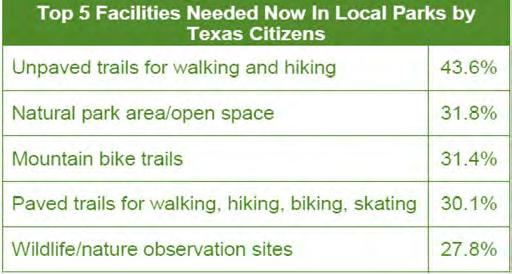
Source: Texas SCORP
The COVID-19 pandemic has increased trail demand and use since the SCORP survey was completed. In 2020, walk/run/hike trips in Potter County have been trending upwards, on track to double the number of trips taken in 2019 (Figure 14). Bike trips in Potter County also have trended upwards (Figure 15).
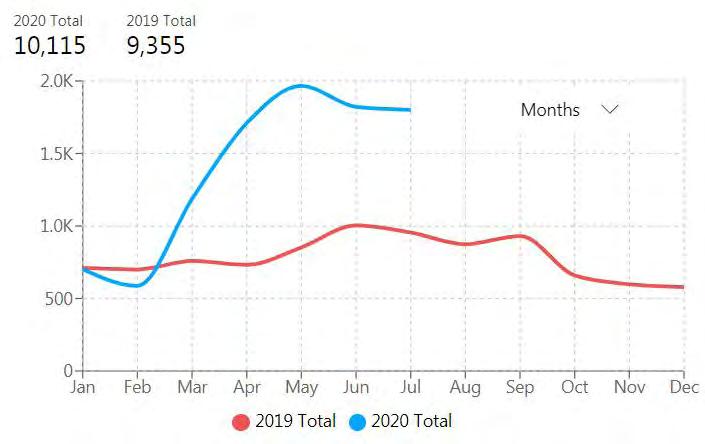
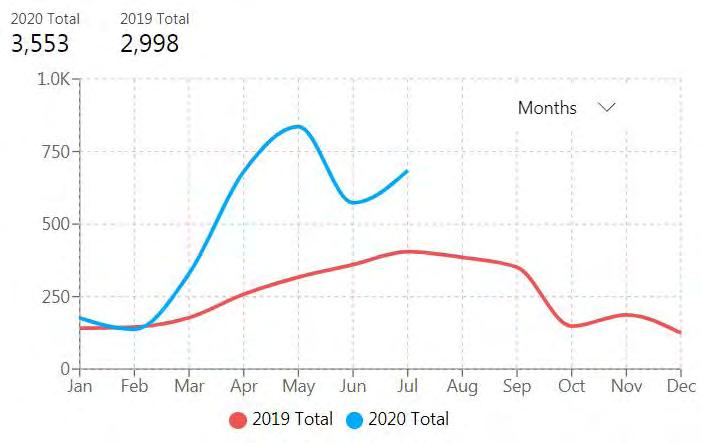
Source: Strava 2020 data
• The City has one existing off-street trail, limiting trail use.
• Trail use is one of the top recreation activities in the state.
• Trail demand and use has grown since the start of the pandemic.
• Multi-use trails are needed to improve park access and non-motorized transportation.
• A bikeway system, with on and off-street bike trails and routes developed in conjunction with transportation improvements, would help meet needs.
• More recreational trails are needed in parks, such as soft-surfaced mountain bike loops, nature trails, and jogging trails, as well as hard-surfaced accessible walking trails and tricycle paths.
• Safe routes to parks would improve park access.
Amarillo provides recreation programs and services for youth, aging adults, families, and individuals. Most focus on special events or facility-based programs, such as golf, aquatics, and tennis, plus a limited number of other types of classes, camps, and activities. The Department does not appear to provide full-service recreation and enrichment options, because of the subsidy needed to support programs.
In a comparison to other agencies across the nation, Amarillo has a smaller role or no role in providing several types of programs. Noteworthy needs include:
• Senior services
• Teen services/empowerment
• Youth sports (not just provided by non-profit leagues)
• Multi-cultural programs/diversity
• Cultural, fine and performing arts
• Community enrichment
• Special needs or therapeutic recreation
• Nature interpretation and environmental education
• School-based youth programs and childcare
• Social services, jobs training, skill-development
• STEM initiatives (science, technology, engineering and mathematics), which could be aligned with some zoo programs
Before Amarillo expands into these program areas, feedback from residents and city leaders is critical to define community expectations, identify core services, and prioritize funding and investment. With limited funding, the Parks and Recreation Department must prioritize which needs are met.
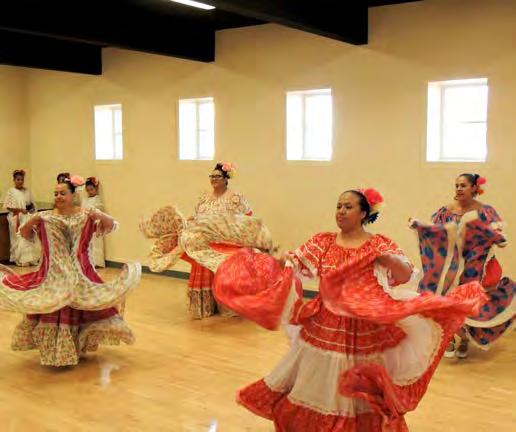

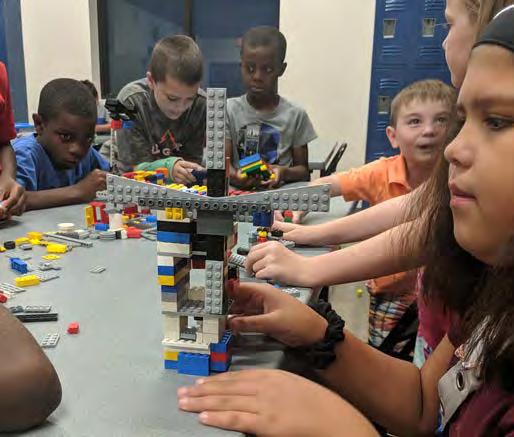


The City of Amarillo’s values, aspirations and priorities are the guiding forces for the Parks and Recreation Master Plan. This Master Plan must be aspirational—identifying ways to enhance and build City park assets over the next ten years. Recommendations also must be realistic—reflecting park conditions and the community’s willingness to pay for facilities, trails and recreation improvements. This chapter identifies City priorities, needs, vision, and goals for parks and recreation in the future, as informed by the outreach and engagement activities conducted for the planning process.
Residents, City leaders, stakeholders, partners, and interest groups all contributed the development of this Parks and Recreation Master Plan. A variety of meetings, surveys and outreach activities helped ensure that diverse voices were incorporated into a new vision, mission, and goals for the future.
• What: Interviews with key city leaders in the first phase of the planning process to identify the unique opportunities and challenges the Master Plan needed to address.
• When: September 9 and 10, 2019
• Participation: Mayor, City Council members, and City Manager
• What: An online and paper survey to determine preferences for the potential replacement of the Thompson Park Pool.
• When: May 30 to June 14, 2019
• Participation: 1,119 online and 304 paper surveys were completed
• What: An online survey conducted during COVID-19 shelter-in-place restrictions to gather information about recreation needs, concerns, priorities, and preferences. The 32-question survey was available in English and Spanish. A parallel youth activity and outreach via schools were put on hold because of COVID-19 restrictions on gatherings at this same time.
• When: April 24 to May 31, 2020
• Participation: 2,368 people responded
• What: An online survey intended to raise awareness of park system challenges, obtain feedback on the potential need to reduce facilities and services, and identify support for future funding.
• When: July 1 to July 25, 2021.
• Participation: 6,904 people responded
• What: A City forum where residents had an opportunity to share their concerns and priorities with Parks and Recreation staff and City Council members.
• When: July 12, 2021
• Participation: 270+ participants
• What: City staff provided information regarding the planning process and project key findings via a Parks Master Plan webpage, email, press releases, videos, TV interviews, Facebook posts and signage in parks with project links and QR codes.
• When: September 2019 – September 2021
• 4 City Council Meetings
• 4 Parks and Recreation Board
• 3 Parks Board Strategic Planning Committee
• 3 Pedestrian and Bicycle Safety Advisory Committee Meeting
• 2 Beautification and Public Arts Advisory Board
VOICES
“Given a lack of investment, City parks have stagnated. We need to ask ourselves: What are our priorities, and what do we want to be known for?”
“I have lived in Amarillo for over 50 years and have always used parks and pools. I am concerned about the age & condition of our facilities. It makes me sad that the beautiful rose garden/gazebo area at Memorial Park seems to have been basically ignored . . . .”
“Amarillo needs to focus on activities that youth and people of color can join in on. Pay more attention to the north side.”
“We don’t celebrate the creative people in our community, whether it’s the artist or the farmer or the dancers. Sure we have a few things like mutt fest and yc3, but I’d like to feel like even if I don’t like sports (which I don’t), I am still included in this city’s culture.”
“Rather than trying to enhance downtown and South Amarillo, why not spread recreation opportunities throughout the city?”
“Do not close any recreation facilities! This is a quality of life issue.”
“As the daughter of older parents who love golf, I would hate to see anything happen to our city golf courses. They are vital to so many by providing exercise, fresh air, and socializing.”
“Thompson needs walking paths. John Stiff needs to be watered, especially in the dog park.”
“As a fisherman, I would like to see a fishing derby or two for the kids, with the intention to get the youth outside more and teach them to fish. I would love to help in any way I can to be involved in something like that!”
“I love AMARILLO Parks! The city has great value in providing places to go and enjoy life. I think all great cities have a zoo, but ours needs a fundraiser to bring attention to it . . . .”
“In Amarillo, boys have their own baseball complex which I love. It’s time for Amarillo to invest more in youth sports, and please don’t forget the girls this time around. The girls of Amarillo need their own softball facility. The boys have several.”
“We love our nearby park, but it’s mostly turf grass, and we never really use the grass. It would be easier to maintain, attract wildlife, and be more interesting to incorporate native plants and nature into some parks.”
Figure 16: Quotes from Residents and Stakeholders
“There are no real mountain bike trails in Amarillo. There isn’t a safe area to ride on the road without feeling threatened. It’s crazy a town the size of Amarillo doesn’t have MTB trails.”
Seven community priorities emerged. These are discussed in detail in this chapter.
• Improved park maintenance and condition
• More trails and walkability
• A variety of outdoor recreation and play opportunities
• More events, programs, and social gatherings
• Attention to destination facilities
• Reflections of Amarillo’s uniqueness
• Prioritized enhancements for all


Enhancing the quality, maintenance, and comfort of the City’s parks, facilities, and trails is a top priority of community members. Amarillo residents would prefer to invest in maintaining, repairing, or replacing worn or old park features and amenities over building new features and trails or adding new parks and facilities. Support amenities such as benches, shade structures, tables, and drinking fountains should be improved to help make parks more comfortable and welcoming.
“Additional facilities and higher quality maintenance of existing facilities that would entice more local and out of town participation.”


Amarillo needs more trails, pathways, and bike routes. While many residents noted that they typically drive or get a ride to parks, this is attributed to the lack of trails for safe walking and biking, and in some cases, the distance people have to travel to get to nearby parks. Even Council members noted the importance of trails and bike routes—not only for recreation but for non-motorized transportation. Hard-surfaced multi-use trails that connect to different destinations across the city are desired most.
“I would love to bike or run to a park. When I do bike, cars honk and run me off the road, drivers are not friendly to pedestrians.”
7: What Types of Trails and Pathways Are Most Needed?
Off-street paved trails for bicycling, walking, rollerblading, skateboarding, etc.
Unpaved trails for recreation/exercise (jogging, horseback riding, mountain biking)
Paths and sidewalks to walk or bike to nearby parks
Nature trails with interpretive signage
On-street bicycle lanes
Connections to the regional trail system
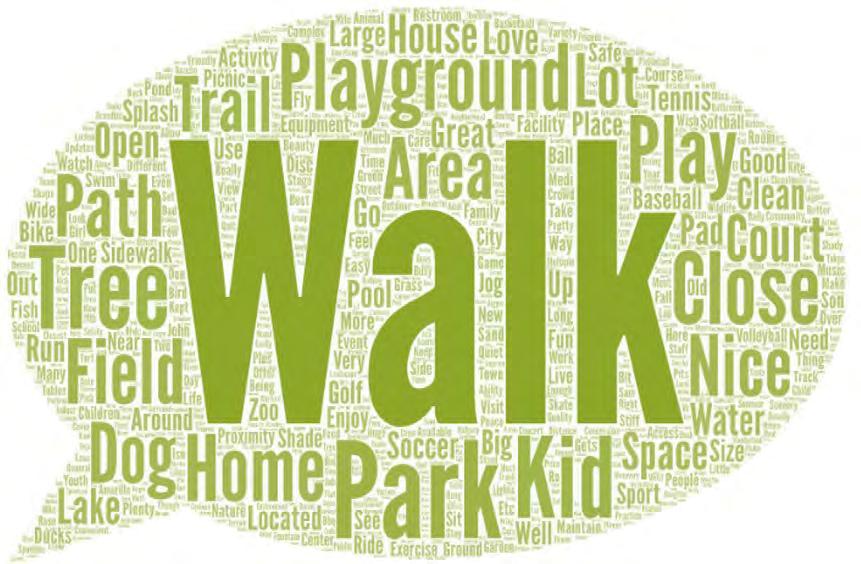
20: Questionnaire Results for “What do you like about your park”
The ability to walk to or while at park is important to residents. When asked “What do you like most about the park or facility you visit most frequently?” the word most frequently used in the open-ended responses appear larger in the word cloud to the left.
Residents desire a variety of recreation activities and experiences in their parks, including places to exercise, play sports, connect to nature, and play with friends and family. More unique and extraordinary play features are needed, including nature play, water play, and destination play areas. Residents also want challenge elements such as climbing walls, bike skills courses, and zip lines.
“What makes a great park? It is a combination of being surrounded by nature while participating in play with sports, kids, family and friends.”


Due to the number of response options, only the top six responses to each question are shown on the above graphs.
Having a variety of programming and events is a top priority of Amarillo residents. Outreach findings indicate that residents expect a greater variety of programming options and would like to see the City expand community events, fairs and festivals, aquatics programming, and youth sports. Residents desire family-friendly recreation programs and events that appeal to people of all ages.
“I think community events like city wide concerts utilizing different parks, (with art shows, music and local stores) and maybe investing in some sports like Frisbee golf (Lubbock has six courses!) And other activities could really help interest younger residents.”
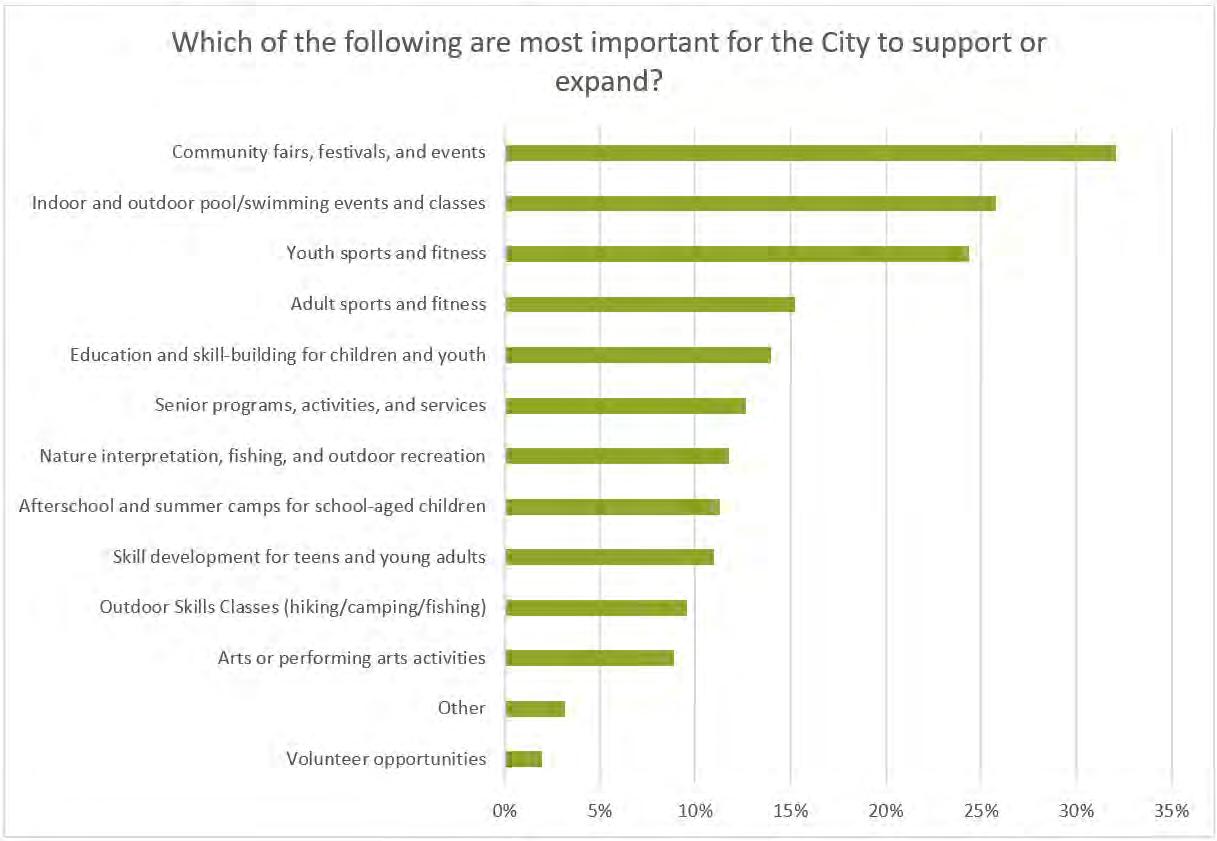
While regional and destination facilities scored lowest in terms of overarching priorities, many writein responses noted the importance of investing in aquatics and sports. For team sports especially, large complexes for baseball, softball, or soccer are desired to hold competitions or tournaments and draw in visitors and revenue. The Thompson Park Pool Survey also noted the community’s desire for a destination pool, especially an aqua park with a lazy river. In general, however, regional sports and destination venues lack broad public support unless it involved improving an aged or worn existing facility.
“Our family travels to other cities and their baseball/softball complexes are top notch. We could bring revenue to Amarillo if we could host big tournaments like Lubbock or Oklahoma.”
The table to the left shows responses to the question “In your opinion, what are the highest priority projects from the following list?’. Respondents were asked to rank their priorities. The second column in the table shows the weighted average of each respondent’s rankings with 0 being the lowest priority and 4 being the highest.

Outreach findings showed strong support for ensuring that City parks, facilities, and programs better reflect Amarillo’s diversity, heritage, culture and natural environment. While investing in art and beautification projects was not a top funding priority, Amarillo residents favored integrating and maintaining some of the unique features and programs that give the community its character.
“Amarillo used to be unique with all the wacky things around town. It really pulled us together with odd pride in the city. Now, most of those things are gone or just in a very sad condition.”
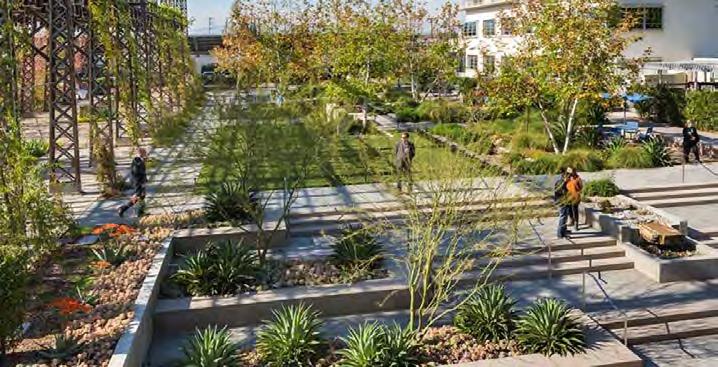
64% favor landscaping and plantings that enhance the beauty of parks and neighborhoods.


60% favor creative play features with unique sculpture, music, or images built in.
57% favor artistic recreation amenities.
42% favor temporary installations that add something new to see and do.


44% favor murals or public art pieces in city parks and public spaces.
Through the planning process, the City realized that nearly half of outreach respondents were not aware that 1) City parks were underfunded and 2) that the City was considering removing or closing various park amenities or facilities. However, many stakeholders, City leaders, and project advisors were aware of the funding deficiencies and recognized the need to “right-size” the system. This prioritization was challenging. When residents were forced to make difficult funding choices, they instead demanded increased parks funding to support critical recreation needs for all people across the city—especially those in underserved areas.
“We realize the city is diverse. But all citizens deserve access to safe/beautiful surroundings, parks that are interesting, educational programming, and free opportunities for recreation/exercise.”

“You need to find a way to keep all parks open. . . .You have to admit there is literally nothing here to do in Amarillo for the kids and that’s a shame. This city has potential and now it’s up to the city to determine what they can do.”
“I believe any and all of the city’s parks and recreational activities should be funded to be safe and fun for all ages . . . encouraging people to get outside, be active, play, nurture human interaction and learning, etc.”
27: Questionnaire Responses to Limited Funding
“You cannot ask us residents to choose just 2 things [as important recreation activities to fund]. There are 199,000 people in this town and they all should have access to everything on this list. Shame on you for making us pick just 2. There should be funding for everything to be updated.”
“We should strive hard to keep and maintain what we have, and expand in areas that need more park areas, such as in San Jacinto. This neighborhood has 1 park.”
In light of the funding challenges facing the park system, the City of Amarillo needs a strong direction to provide realistic, outcome-focused directions for future projects, programs and services. In 2012, the mission of the Parks and Recreation Department guided it broadly to enhance the quality of life for Amarillo through quality parks, programs, and people. This time around, however, Department staff wanted to articulate their core services and define how they would sustain the City’s parks and recreation business. They also needed practical yet forwardthinking goals and a vision of what they wanted to achieve in the future.
The 2021 Master Plan proposes a new vision framework. It includes the following elements:
• Our Mission identifies the purpose and essential services of the of the Parks and Recreation Department.
• Our Vision summarizes our aspirations for future parks and recreation services.
• Goals describe our desired directions for longrange change.
• Objectives articulate specific and measurable outcomes that will help achieve our goals.
The graphic on the next page summarizes Amarillo’s vision framework. While the goals are numbered for ease of reference, they do not appear in priority order. Together with objectives, these goals present a cohesive set of directions to achieve the community’s priorities for parks, recreation facilities, trails, art and programs.
For each goal and objective, the Master Plan also presents systemwide strategies to guide the provision of parks, recreation, and related services over the next ten years. These represent a mix of actions that should be taken to enhance the park and recreation system. The full set of goals, objectives and strategies are included in Appendix D.
While important to meet TPWD requirements for grant eligibility, the complete set of strategies is far more comprehensive than the City can complete within the 10-year planning horizon. However, the vision framework and strategies help identify more realistic and achievable implementation priorities, actions and tasks that take into account funding availability and needs. In short, these comprehensive aspirational strategies make it clear that Amarillo needs an overarching investment strategy with specific actions to guide its future operations and capital projects.




Amarillo residents have a vision and priorities for parks and recreation that by far surpass the current resources of the City’s Parks and Recreation Department. A greater investment is needed to ensure our parks survive the current asset management crisis. Looking both short and long term, the City must be strategic in deciding where and how funds should be spent. This chapter guides this park investment, introducing a new business model to sustain key operations and assets. This strategic approach will help the City make progress over the next ten years towards achieving its vision as diverse, resilient, and sustainable park system.

Many residents assume that their tax dollars should fund the provision and maintenance of parks. Amarillo, however, has one of the lower property tax rates in the State. For every dollar collected in taxes, approximately one cent goes to parks.
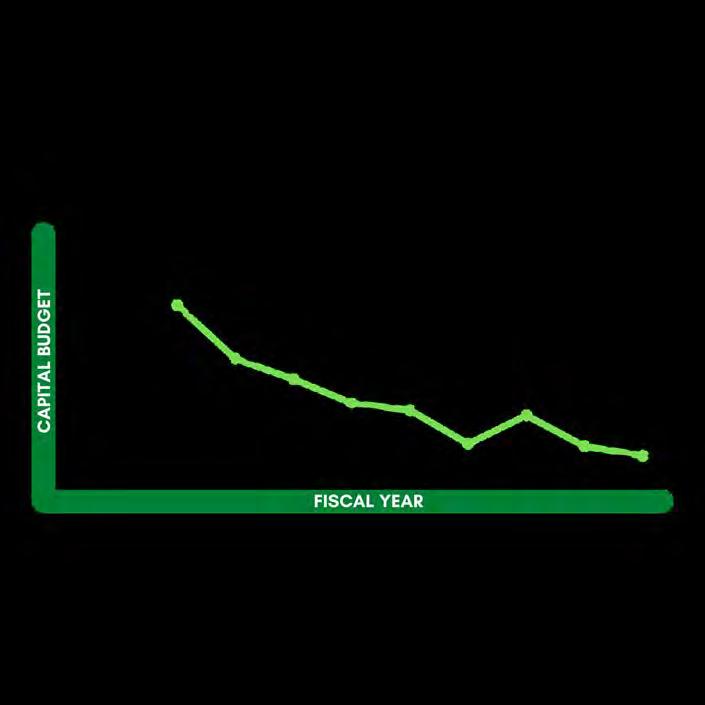
Besides regular tax dollars, many cities rely on other funding sources such as bonds, dedicated levies, grants, program/facility revenues, impact fees, sponsorships, etc. Amarillo:
Parks & Recreation currently has $48 Million worth of assets that fall within the high risk (failing) category. The drastic increase in failing assets is directly related to a consistent decrease in capital funding and the general wear and tear of aging infrastructure.
Is long overdue in passing a publicly supported bond measure. City voters have not approved a bond measure since 1974.
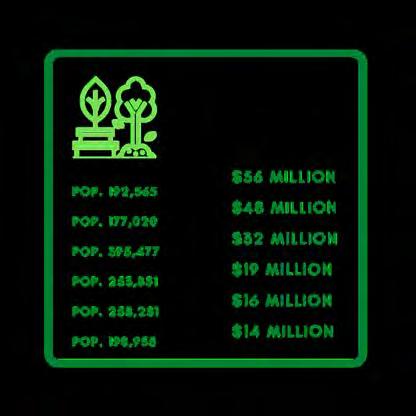

• Has just recently updated its Zoning Ordinance to update and increase park land dedication and in-lie fee requirements for new development to offset the costs of growth.
• Has coordinated with partners, sponsors, and legacy donors, but does not have a Parks and Recreation foundation or nonprofit.
• Has been successful in grant applications but limited by the need to provide matching funding.
While continuing to look for options to increase funding, the City must also look to reduce its expenditures. In short, the Amarillo Parks and Recreation Department must re-align its investment to focus on funding core services.
Cities subsidize parks, programs, services that support broad public benefits, public safety, and underserved groups. Examples include:
• Neighborhood playgrounds and greenspace
• Swimming pools
• Park and facility maintenance
• Community events
• Recreation and beginner level activities
• Community social services (e.g., refugee or fragile senior services)
The Parks and Recreation Master Plan recommends a new business model to guide its park investment. This includes realigning expectations around revenues and expenditures. The National Recreation and Parks Association notes that, in 2021, 23 percent of agency operations typically are funded through earned or generated revenue. That amount tends to be higher for larger agencies that traditionally provide full-service recreation options.
Agencies with higher cost-recovery rates work to balance the type of parks and services provided. Subsidized sites and services are balanced by those that generate revenues (Figure 30).
Cities ensure that parks, programs, services with high individual benefit, high entertainment value or high enrichment value generate revenues or be supported by fees. Examples include:
• Enterprise or specialized facilities such as golf courses and zoos
• Competitive sports
• Adult fitness and enrichment programs
• Art performances, such as ticket-based concerts
• Facility rentals
• Land leases
Figure 30: Balancing Park and Recreation Subsidies and Revenues
Based on the findings of the technical analysis and community engagement, the Master Plan identified strategies and recommendations to achieve eight long-term goals for the park and recreation system (Appendix D). These are aligned with eight guiding principles for the City’s future park investment.








Guiding Principle: Sustainability ensuring the wise use of our assets and resources
Goal 1: Strategically Maintain and Manage Assets
Guiding Principle: Diversity creating parks and programs that reflect the full range of community culture in Amarillo Goal 2: Create Context-Sensitive Parks
Guiding Principle: Equity and Inclusion providing park benefits and play opportunities for all Goal 3: Ensure Equitable Park Access
Guiding Principle: Connectivity enhancing trail connections through the city and beyond Goal 4: Foster Trail Experiences
Guiding Principle: Health & Wellness supporting healthy lifestyles, including individual and community health Goal 5: Promote Health and Fitness
Guiding Principle: Social Cohesiveness cultivating community through events and activities Goal 6: Support Social Gatherings, Events and Programs
Guiding Principle: Resilience regaining park system vitality amidst adversity and challenges Goal 7: Ensure Fiscal and Economic Resilience
Guiding Principle: Enrichment promoting quality park experiences and Amarillo’s identity Goal 8: Enrich Amarillo through Quality Services
Of these, three should guide immediate changes in restructuring the City’s parks and recreation business. To sustain the park system and reopen following the COVID-19 pandemic, Amarillo should focus on sustainability and resilience. However, the City does not want these changes to price out disadvantaged residents, so equity and inclusion must be factored in to the new reinvestment strategy.
• Increase fees and revenues
• Reduce and right-size services
• Increase efficiencies in resource use, staffing, and operations
• Eliminate high-cost, high-risk ventures (unless an equity partner assumes the risk)
• Diversify funding resources
• Ensure core services for all
• Reduce subsidies for non-core services
While the investment strategy is driven by sustainability and resilience, that does not mean that the City should focus exclusively on asset management. If the City entirely repairs and replaces the assets it has without realigning services, it merely defers the funding crisis to the next park and facility lifecycle. Nor would it address needs for new parks in growing residential areas, the needs of unserved areas, and evolving demands for new or more diverse recreation options. A new business model is needed.
While the investment strategy is driven by sustainability and resilience, that does not mean that the City should focus exclusively on asset management.



The Master Plan provides direction on the types of services that should be considered core services for investment. These are the types of parks and programs most important for the Parks and Recreation Department to provide. Core services that may require added investment are considered the priority for the use of General Fund dollars. There are several support or ancillary services the City must sustain to continue to provide its core services. Also, there are other recreation opportunities that the City should foster if able. This may mean increasing fees or identifying partners to share costs. Table 9 provides directions with regards to these different levels of services.
Table 9: Core, Ancillary, Non-Core and Other Services
Service
Core Services:
Examples
The City should invest in these elements that provide broad community benefits.
Close-to-home greenspace and play
Active recreation, programs and park facilities that support community health and safety
• Playgrounds
• Irrigated neighborhood greenspace (natural or landscaped)
• Targeted school parks in high-needs areas
• Aquatics water safety and learn-to-swim programs
• Aquatics and water play for cooling
• Shade in parks
• Sports courts in neighborhood parks
• Sports fields for recreational use
• Loop trails in parks or extensions of existing trail corridors
• Community gardens in parks
• ADA facilities and inclusion
Outdoor social gathering space and activities
Programs and services in underserved, disadvantaged, and high need areas
Ancillary Services:
• Community gathering facilities, such as urban plazas, picnic areas, dog parks, and destination play spaces
• Selected community events, holiday events, family movies or concerts in parks, cultural festivals, farmers markets
• Mobile recreation
The City should sustain these services but look for efficiencies to reduce costs where feasible.
Park and facility maintenance and asset management
Facility operations
Management and administration
• Preventative and routine maintenance
• Janitorial care
• Tree, landscaping, and natural resource stewardship
• Facility inspections
• Repair and replacement of core facilities
• Divestment of non-core facilities
• Building/facility opening and closure
• Program set-up and take down
• Management of regular or contract staff
• Staffing to support programs and operations
• Administration
• Marketing and communications
• Planning and construction management
• Volunteer coordination
• Business management (including foundations, land leases, etc.)
• Recreation/arts and beautification coordination
Shared-Cost Services:
Examples
The City should decrease its subsidy by increasing fees or sharing costs with partners better suited to provide these recreation and community services.
Community Events, Fair and Festivals
Sports field reservations
Recreation programs in disadvantaged areas
Citywide transportation, health, safety or beautification initiatives
• Permitted events hosted by other groups
• Art and craft fairs
• Youth and adult non-profit recreation leagues
• Youth camps
• Youth childcare or after-school programs
• New trail greenway corridors
• National Night Out programs
• Park and community clean ups
• Tree planting programs
• Art installations
Enterprise Services:
The City should decrease its subsidy of services that provide high individual benefit. These should move towards 100+% cost recovery through fees, memberships, sponsorships, donations, etc.
Revenues should cover any city permitting, scheduling, maintenance, operations, and long-term asset management.
Sports enterprise facilities and complexes
Heritage sites and entertainment venues
Private enterprises and uses in parks
• Golf courses
• Sport complexes and tournament venues
• Amarillo Tennis Center
• BMX Tornado Alley
• Amarillo Zoo
• Food truck and concessionaire permits
• Filming and photography permits
• Private sports coaching
• Private bootcamps or programs
• Picnic shelter, room, pool and facility rentals
Various programs and services
Non-Core Services:
• Competitive sports
• Enrichment programs
The City should divest or transfer responsibilities for these sites and services.
Surplus park sites
Surplus/supplemental leisure, entertainment, and beautification services
• School parks in areas already served
• Surplus lands (with little or no current or future recreation value)
• Bike lanes/routes in transportation corridors and street rights-of-way
• Additional indoor recreation opportunities
• Wonderland (as non-City facility on leased City property, the lease agreement must include decomissioning requirement)
Note: The complete school park inventory is located in Appendix A, Table A-2
Moving forward, Amarillo should focus on investing in core and ancillary services, as well as on increasing revenues or offloading other services. This strategy can be applied across the park and recreation system to guide park management and business planning.
Larger parks have more enterprise facilities and a greater ability to generate revenues through programs, events, concessions, permitting, and leased uses. Smaller parks do not. By rethinking and reclassifying city park in a new park hierarchy, the City can begin to re-think its cost recovery by classification (Table 10).
The key change lies in requiring programs, sports field use, and facility rentals to include fees that cover maintenance and asset management costs to increase revenues. On the other end of the spectrum, smaller neighborhood parks should be scaled-back to reduce maintenance and asset management needs. This may require removing (or not replacing) restrooms and non-essential facilities. Instead of treating all neighborhood parks equally, the City should distinguish larger neighborhood parks from smaller ones to provide mid-size parks and facilities that serve multiple neighborhoods.
Directions
(or ½
in high needs areas)
• Scale back development to provide essential recreation options for nearby neighbors
• Remove restrooms and highmaintenance facilities not suited for close-tohome parks
• Offer this midsize park to provide varied recreation options for several neighborhoods
• Generate revenues by providing reservable facilities for small groups and sports
• Increase revenues by expanding programs, fee-based league sports and rental facilities for large group uses.
• Offer a greater variety of recreation options
• Program these sites and provide rental facilities and concessions depending on opportunities
*Cost recovery should factor in maintenance, operations, and asset replacement needs.
and beyond
• Provide revenuegenerating programs, events, rental facilities, and enterprise facilities
• Consider land leases, naming rights, sponsorships and other revenue sources
• Provide and maintain to expand connectivity and improve bike and pedestrian access to community and regional parks
As part of this investment concept, the Master Plan evaluated park distribution. In the ideal park system, fewer large parks, medium and smaller parks are distributed to provide access to a variety of park experiences. Currently, Amarillo parks tend to cluster higher-investment parks, leaving other areas underserved (Figure 31).
With this information, the Master Plan began to map out an investment strategy across the park system. It considered park adjacencies, equity needs, and even barriers to access in creating a re-envisioned park system (Map 3). It selectively keeps school parks where needed to meet neighborhood needs. This map provides general direction to focus the level of investment and guide the repair and replacement of worn or deteriorating assets across the system.
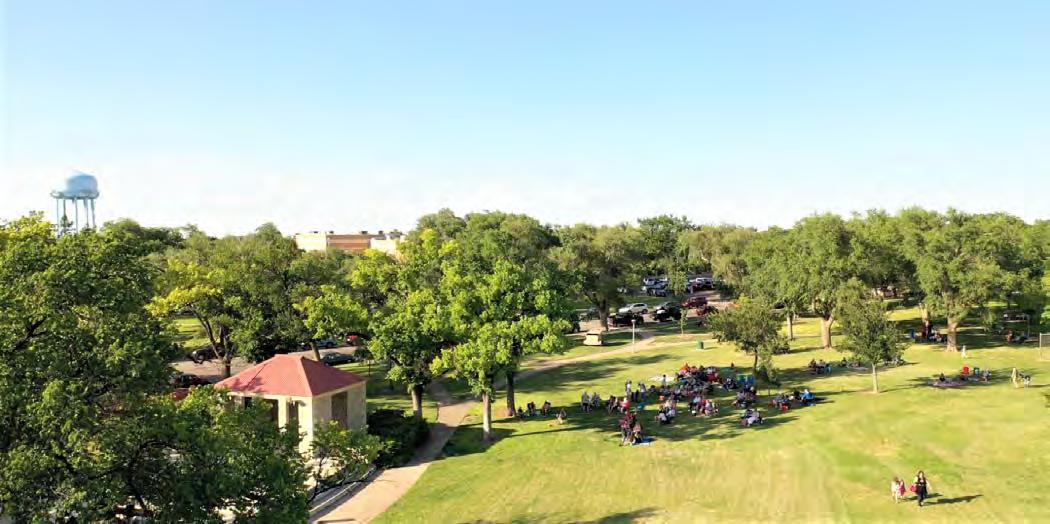


The restructured park investment concept is built upon strategies for diversifying how and where funding is spent. This includes providing:
• Scaled-down, diversified small neighborhood parks
• Shared-cost school parks in selected areas
• Parks via updated dedication requirements for new residential development
• Parks to address unmet recreation needs
• Tiered maintenance approach
• Revenue-generating programs leases, concessions and facility rentals
Table 11 on the following pages summarizes these details on for each park classification and type. Details on these investment strategies are provided following the table.

Note: This map is intended for conceptual purposes only. Park classifications will be determined through cost recovery and business planning.
Purpose Small parks that provide essential greenspace to support play, recreation and family gatherings within walking or biking distance for nearby neighbors
Existing LOS
acres per 1,000 for small neighborhood parks
Service Area; Distance Surrounding neighborhood; 1 mile (maximum), ½ -mile preferred in higher-density residential areas or disadvantaged areas
Medium-sized support a variety recreation and gathering opportunities several neighbor
Intent Co-located with a school to leverage joint resources in underserved areas
Provides essential recreation experiences to support health and wellbeing Provides gathering space and recreation to support diverse neighborhood cultures
Supports urban agriculture
Provides a mix sports, picnicking other recreation for surrounding
Essential Elements
• Playground
• Open turf play area
• Seating
• Active use amenity
• Other features provided by school
Note: City may share maintenance cost with School District through JUA
• Play equipment
• Picnic area
• Sports court
• Youth sports field or practice field
• Low-maintenance landscaping
• Thematic play features
• Open turf play area
• Shaded group seating
• Diverse recreation element (e.g., bocce, sepak takraw, futsal, etc.)
• Art/Interpretive elements
• Low-maintenance landscaping
• Nature play elements
• Open turf play area
• Shaded picnic area
• Community garden or accessible natural area
• Loop trail
• Trees
• Low-maintenance landscaping or native plantings
• Play equipment
• Open turf play
• Small group shelters
• Sports fields
• Small, unique feature (e.g., equipment, sprayground, skate spot, bike track)
• Restrooms
• Art/Interpretive elements
parks that variety of play, and small group opportunities for neighborhoods
Large parks that support varied recreation options, large group gatherings and specialized uses for a portion of the City
Single-purpose recreation facilities or parks that support specialized uses for a portion of the city
Recreation and cultural destinations that attract people from across the city and beyond.
for
of play, picnicking and recreation activities surrounding neighbors
acres)
Provides a mix of play, sports, picnicking and other recreation features at a scale and quality to support recreation programs, community events, and large group uses
per
for
• Large thematic play area
• Open turf play area
• Large group picnic shelters
• Lighted sports fields and courts (variety)
• Small and large unique recreation features (e.g., splashpad, skatepark, disc golf, dog park)
• Loop trail (walking/biking)
Provides a stand-alone facility or complex with recreation features at a scale and quality to support recreation programs, sports, community events, and large group uses
Provides park destinations with specialized or unique facilities that support citywide events, recreation tourism, and revenuegeneration. Sites may be operated as enterprise facilities
• Depends on site use
• Enterprise facilities
• Specialized revenuegenerating facilities
• Large group shelters/pavilions
• Event and programming space
• Destination play areas
• Additional sports and recreation facilities
Greenways and trail corridors that support connectivity and access.
• Trail (soft or hard surface)
• Buffers (vegetative, physical barriers)
• Low-maintenance landscaping
• Trees
Supports trail development in linear parks and greenways equipment play area picnic and courts unique recreation (e.g., fitness sprayground, bike pump Art/Interpretive
• Art/Interpretive elements
• Restrooms
Programming, Leases, Concessions and Facility
Rentals
None, drop-in use only
drop-in use only
• Willow Vista
• Mesa Verde
• Sunrise
• Ridgecrest
• Will Rogers Park
• Benton Park
• Pleasant Valley Park
• Oliver Eakle Park
• Mary Hazelrigg Park
• Glenwood Park
• Sanborn Park
• NE 17th Ave Open Space
• Sleepy Hollow
• Arden Road
• New parks to serve residential development
• San Jacinto Park
• Vest Pocket Park
• New parks to serve residential development
• New parks to serve residential development Northwest
• West Hill Park
• Woodlands School
• San Jacinto Park
Facility and sports reservations and Examples of Parks Suited to this Classification **
• Dr. Martin Luther Northeast
• Gene Howe Park
• Eastridge School
• Benton Park
• Pleasant Valley Southeast
• City View School
• Southlawn Park
Southwest
• Greenways Park
• Paramount Park
• Belmar School
• New park to residential development
* Targets are not intended for individual park sites. Park collectively should be managed to hit revenue targets and reduce expenditures **Park classifications for all sites will be determined through cost recovery and business planning. This table is intended to provide See Appendix E for park dedication requirements that include more specific guidelines for neighborhood and community parks.
Note: Small neighborhood parks where neighbors want a higher level of investment can be adopted/taken over by HOAs to operate.
sports field and rentals
Enhanced with Specialized maintenance where warranted
Outdoor and indoor programs, small events, concessions, and facility and sports field rentals and reservations
• Hines Memorial Park/Warford Center
• Sam Houston Park
• Ellwood Park
Northeast
• Martin Road Park/Softball Complex
• River Road Park
• El Alamo Park
• New NE Community Park to serve unserved area
Southeast
• Southeast Park
Southwest
• Memorial Park
Enhanced with Specialized maintenance where warranted
Outdoor and indoor programs, small events, concessions, and facility and sports field rentals and reservations
Northwest
• Medical Center
• 9th Avenue Bike Park
Northeast
• Centennial Plaza
Southeast
• Southeast Softball Complex
• Southeast Pool
Southwest
• None
Enhanced, with Specialized and Natural Resource maintenance where warranted
Outdoor programs, large events and festivals, concessions, facility and sports field rentals and reservations, land leases
Northwest
• Thompson Memorial Park
• Ross Rogers Golf Complex
Northeast
• None
Southeast
• Rick Klein Athletic Complex
• Comanche Trail Golf Course
Southwest
• John Stiff Memorial Park
Standard
Walking and biking events, activities and races
• Rock Island Rail Trail
• Julian Parkways
expenditures at high-cost parks. provide general direction for asset management. Several small neighborhood parks have not been assigned to a park type. parks. operate.
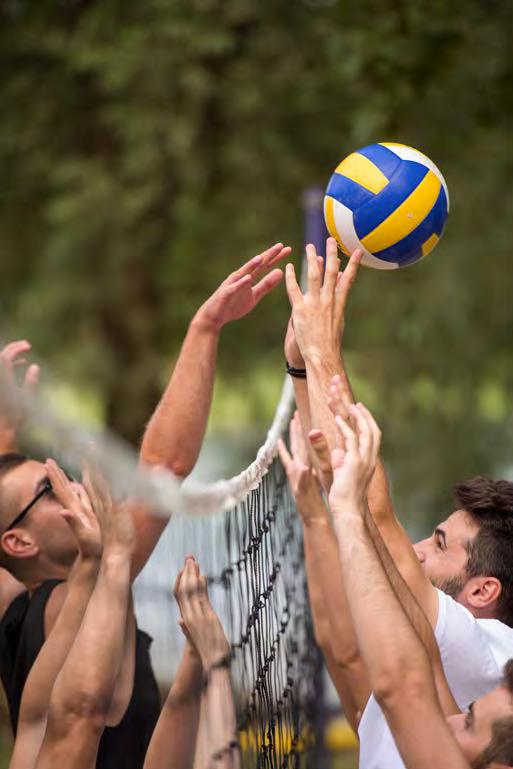
Small neighborhood parks should provide the following elements to support essential recreation activities and site character:
• Children’s play area
• Active recreation, fitness or healthy living amenity
• Social gathering space for friends and families
• Open turf area for unstructured recreation
• Other low-maintenance amenity to support site character
These sites are intended to be simple and should not include high-maintenance facilities or additional development. Restrooms and spray features should not be provided. To ensure small neighborhood parks are varied and engaging, the City should diversify parks—when replacing old or worn facilities or developing new sites—to focus on one of three different options (Figures 32-34). At the time of renovation, the City will engage nearby neighbors to determine the type of park to provide. The result will be lower maintenance, scaled-down but unique and interesting small neighborhood parks.

33: Heritage-hood Park Schematic
Figure 34: Nature-hood Park Schematic
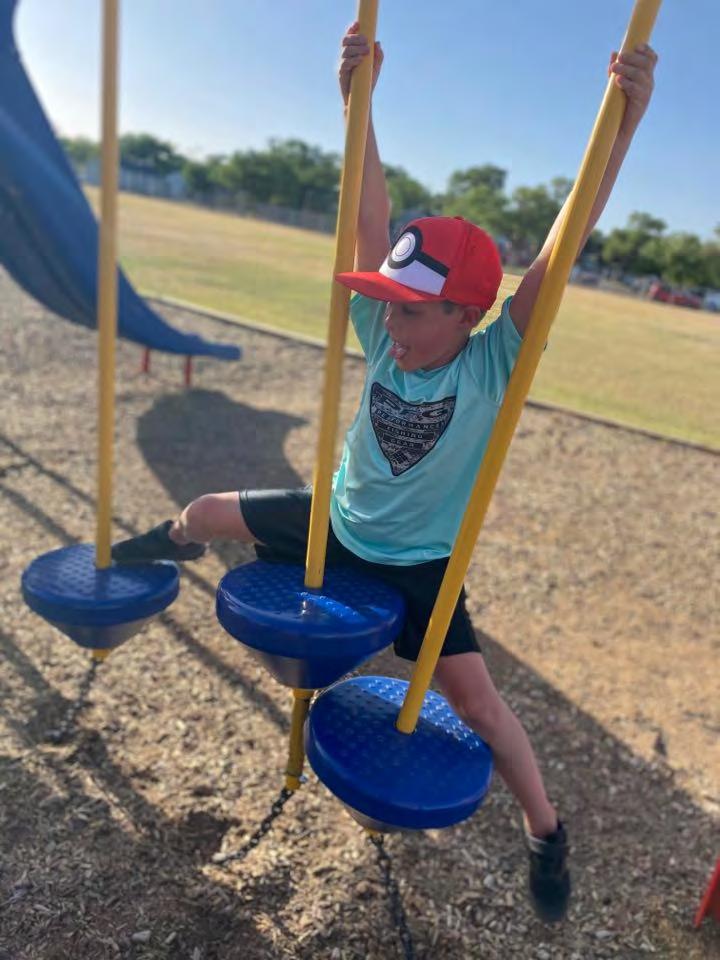


School parks are neighborhood parks that are colocated with schools and, frequently, co-owned or owned by School Districts. Most function as small neighborhood parks; a few City-owned sites are well-positioned to function as large neighborhood parks. Sites that are owned entirely by School Districts may offer different development options (as determined through joint use agreements) to support both outdoor recreation and education.
Moving forward, the City should selectively invest in sites that are needed to provide nearby neighborhood parks, as per the standards and guidelines of this Master Plan. School Districts may still contract with the Parks and Recreation Department to maintain other school recreation spaces, but they will either fully pay or share maintenance and asset management costs depending on site ownership and new agreements.
As part of the Master Plan all existing school parks were evaluated against park access and equity criteria to identify park needs. Table 12 summarizes recommendations based on that evaluation. Recommendations include:
• Keeping a City-owned school park and increasing the investment to meet needs.
• For jointly-owned sites, funding park maintenance only for the City’s portion of the park and increasing or decreasing the investment in park assets depending on whether the park is serving an unserved area.
• Terminating maintenance agreements for sites not needed as school parks. If the park is Jointly-Owned, the City may explore options to divest its portion of the site, transferring these lands to schools if approved by a majority voted of the community.
• Entering a cost-sharing agreement for School District-owned sites that meet park needs.
Note: The sites noted in blue are served within a 20-minute walk. However, these are unserved within a 10-minute walk (the industry standard for providing parks within walking distance.) Given the demographic characteristics and density of nearby areas, the City should consider maintaining these sites and sharing costs to support equitable park access.
School Name
CITY-OWNED SITES
Serves an Unserved Residential Area (beyond 20-minute walk)1
Recommendation5 Below the poverty level2 Nonwhite or Hispanic/ Latino3 Higher housing density4
City View Park a Keep Site. Invest in as Large NP.
Woodlands School Park a Keep Site. Invest in as Large NP.
Arden Road School Park a Fund City portion.
Belmar School Park a a Fund City portion. Increase investment.
Eastridge School Park a
Fund City portion. Increase investment.
Puckett School Park a Fund City portion. Reduce investment.
Ridgecrest School Park a a Fund City portion.
Sleepy Hollow School Park a a Fund City portion.
Sunrise School Park a a Fund City portion.
Willow Vista School Park a Fund City portion.
Windsor School Park Fund City portion. Reduce investment.
SCHOOL DISTRICT-OWNED SITES
Alice Landergin School Park a Terminate Agreements
Avondale School Park a
Forest Hill School Park a
Gene Howe School Park 7 Terminate Agreement
Hamlet School Park a a Terminate Agreements
Hillside School Park a Share Costs6
Hilltop School Park a a a Terminate Agreements
Lamar School Park a Terminate Agreements
Lawndale School Park a a a a Share Costs
Margaret Wills School Park
Mesa Verde School Park a a
Oakdale School Park
a a Reevaluate; Terminate Agreements
Share Costs
a a Reevaluate; Terminate Agreements
Olsen School Park a Share Costs
Park Hills Elementary School Park a a a Reevaluate; Terminate Agreements
South Georgia School Park a Share Costs
Tradewind School Park a a Stop Maintaining Site6
Western Plateau School Park a Terminate Agreements
1 Identifies unserved areas beyond the City’s 20-minute walk standard of an existing City-owned park.
2 Receives a checkmark if a portion of the residential gap area’s population is 50% or more below the poverty level and/or the majority of the residential gap area’s population is 30% or more below the poverty level.
3 Receives a checkmark if the residential gap area has a population that is 50% or more non-white.
4 Receives a checkmark if the residential gap area has a relatively fair amount multi-family housing and 20 residential dwelling units per acre or greater.
5 Unless otherwise noted, sites kept as school parks are anticipated to be maintained as small neighborhood parks.
6 City does not have maintenance agreement
7 Another school park covers the unserved area near this site
Note: Given the demographic characteristics and density of nearby areas, the City should consider continuing to maintain sites noted in blue to support equitable park access.
New residential subdivisions are required to provide, through dedication or alternative means, neighborhood parks and community parks sufficient to meet the proportionate demand created by the subdivision and resulting development. Appendix E summarizes these Parkland Dedication Requirements. It also provides guidance regarding the recommended level of development for the City’s update of its in-lieu fees.
If adopted, these requirements are anticipated to apply to six new residential areas noted on Map 3:
• Fox Hollow
• Nobel Park
• Town Square
• Heritage Hills
• Glendale Subdivision
• South Georgia Place
Going forward, they will apply to all new residential development to offset the impacts of new growth. While these dedication requirements will fund park land acquisition and development, additional maintenance funding and staffing will still be needed as new parks are brought online.
All park sites require some type of routine and preventative maintenance to take care of City assets and landscaping. Parks with higher levels of use, specialized facilities, reservable facilities, and organized programs and events require a greater level of maintenance. In addition, a few sites require added specialized care for major facilities and/or natural resources in addition to routine maintenance. This section notes how this tiered maintenance approach can be applied across the park system (Table 13). It recognizes that some neighborhood parks may need plantings or amenities removed so that these sites only receive a basic level of care.
While the City is interested in supporting beautification efforts in parks and additional open spaces, it cannot afford to provide enhanced maintenance at additional sites. Public feedback during Master Plan outreach suggested that higher-maintenance landscaping could be cut to reduce costs. This means that maintenance funding and tasks should be focused on sites that provide higher recreation value. In contrast, beautification projects should include lowmaintenance plantings and features that can be maintained at a standard level. This may reduce or eliminate annual and perennial plantings such as flowerbeds across the park system and minimize extra “beautification” areas (not in parks) that have no recreation value.

Routine and Preventative Maintenance for Developed Parks
Standard
Enhanced
• Basic landscape maintenance for safety and aesthetics
• Monitoring and inspection
• Landscape maintenance and litter pickup
• Routine and preventative care for site furnishings and facilities
• Restroom cleaning
• All tasks in “standard” level, but on a more frequent basis, or sequenced to support activities, e.g., more frequent landscape maintenance and litter pickup
• Specialized facility maintenance (e.g., splashpad, pool)
• Sports field turf irrigation and management
• Janitorial care of buildings (e.g., restrooms, golf clubhouse, and activity center)
Additional Maintenance Services
Specialized
Natural Resource
• Major facility maintenance (e.g., swimming pool, activity center)
• Care of golf course greens
• Care of floral and botanical plantings, weeding, pruning where applicable
• Routine monitoring and inspection
• Tree / brush pruning
• Mowing (where appropriate)
• Trail clearing
• Graffiti / vandalism removal or repair
• Amenity repair
• Amenity replacement
• Repair or replacement of facilities
• Minor program or reservable facility preparation, setup, or cleanup
• Small neighborhood parks, school parks, linear parks, and beautification areas.
• Large neighborhood parks, except specialized facilities such as spraygrounds and splashpads.
• Community parks, special use parks, and regional parks
• Repair or replacement of major facilities
• Major event venue preparation, setup, or cleanup
• Tree canopy protection
• Invasive species removal
• Dumping and hazards removal
• Bank stabilization
• Natural area restoration
• Natural resource management
• Fire prevention
• Regional parks, with added attention for specialized assets with heavier or more frequent use
• Parks with significant natural resources, ponds or lakes
Park and recreation programming is essential to community health, identity, and park usage. It’s also critical for generating revenues to offset the costs of maintaining and operating specialized facilities. To support programs and activities in parks where appropriate, City staff will maximize their impact by managing facilities, programs, events and services in several different capacities:
• Direct Program/Event Provider: The Parks and Recreation Department will identify program needs, plan programs, provide facilities, and hire and train staff to implement programs. This applies to services such as pool operations.
• Contract Provider: The Parks and Recreation Department may contract with other providers to implement programs in City facilities, such as contracting with a tai chi instructor. Revenues for classes typically would be split proportionately. For example, 65% may go to the instructor and 35% to the City (as determined through pricing and cost recovery policies) to cover the City’s direct and indirect costs for maintenance, asset management, marketing, facility, scheduling, and coordination of registration.
• Contract/Facility Concessionaire Manager: The Parks and Recreation Department may contract out operations for an entire facility to another entity or concessionaire. Cities frequently use this model to operate golf courses, zoos and similar major facilities. Where cities do not have many indoor facilities, they may bring in a facility operator for recreation and activity centers. Here, the concessionaire either contracts out maintenance or pays Department staff to play this role. These types of contracts frequently include revenue-sharing agreements that give the city a portion of profits generated, in adding to covering any city investment in the facility.
• Partner: The Parks and Recreation Department may coordinate with another entity to share costs and responsibilities for providing programs and events in City parks and facilities. For example, the Park and Recreation Department may offer use of its facilities without charge to an event provider, taking on the costs associated with site utilities, event set-up and clean-up as part of its contribution, while the other provider coordinates the activity or event. Equity partners are frequently involved when cities provide non-core facilities. The city’s contribution may be in the form of a nominal lease (e.g., $1 per year) to allow the partner to build, operate and maintain a facility in park.
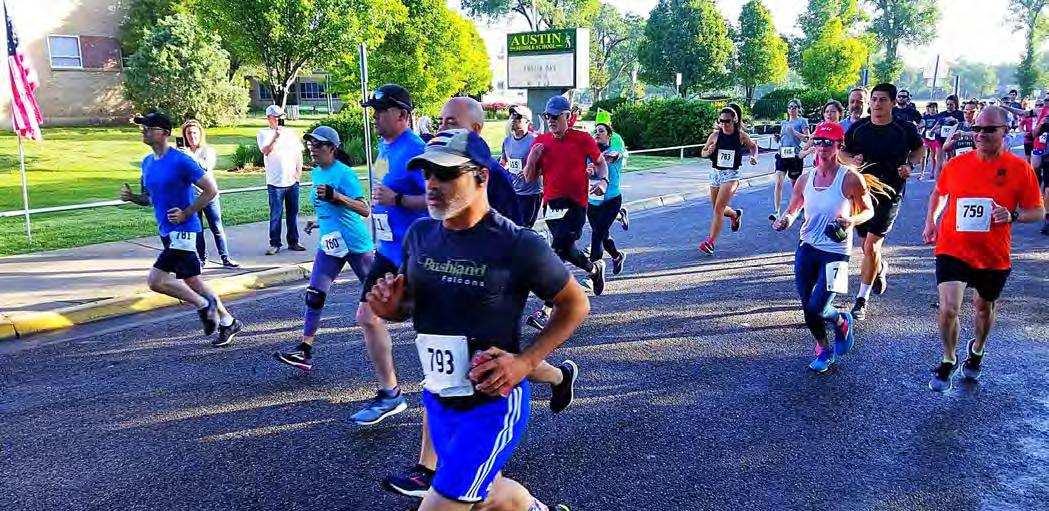
• Facilitator/Permitter: The Parks and Recreation Department may manage and maintain facilities that are reserved (for a fee) on an ongoing or one-time basis by sports leagues, non-profits, individuals, or other public or private community groups. Most sports fields and reservable picnic shelters, party and meeting rooms, pools and cabanas, etc., generate revenues on this basis. The role as facilitator may include scheduling, managing reservation processes, and even managing event and vendor permits—including for activities such as filming, private coaching, food trucks in parks, etc.
• Land Lessor: Given Amarillo’s extensive undeveloped park space, the Parks and Recreation Department may lease long-term (or consider selling) selected sites to another entity with the intent of generating revenues and reducing maintenance costs.
• Promoter: The Parks and Recreation Department may help market and promote non-City recreation activities through existing communications channels, including traditional and social media, activity guides, newsletters or mailing lists, etc.
Fees should be charged for each of these services. The City of Amarillo needs a clear fee philosophy and cost recovery plan that establishes clear pricing policies based on the level of benefit provided. These fees should be applied to offset costs associated with maintenance, operations, and asset management. Additional revenues can be re-invested into additional programs and scholarships that offsets costs for individuals that cannot afford program fees. This new fee philosophy may require updating current fee expectations. For example, most cities collect revenues from youth and adult sports—whether the City is providing the sports program or only providing the sports field or court on which the sport is provided (by a league, non-profit, private provider or other entity.)
The strategies noted here will not all happen instantaneously. They will be phased in over time to gradually increase fees and right-size parks and maintenance investments as amenities and facilities are replaced. The action plan presented in the next chapter will help guide the projects and services that should be undertaken in the next ten years.

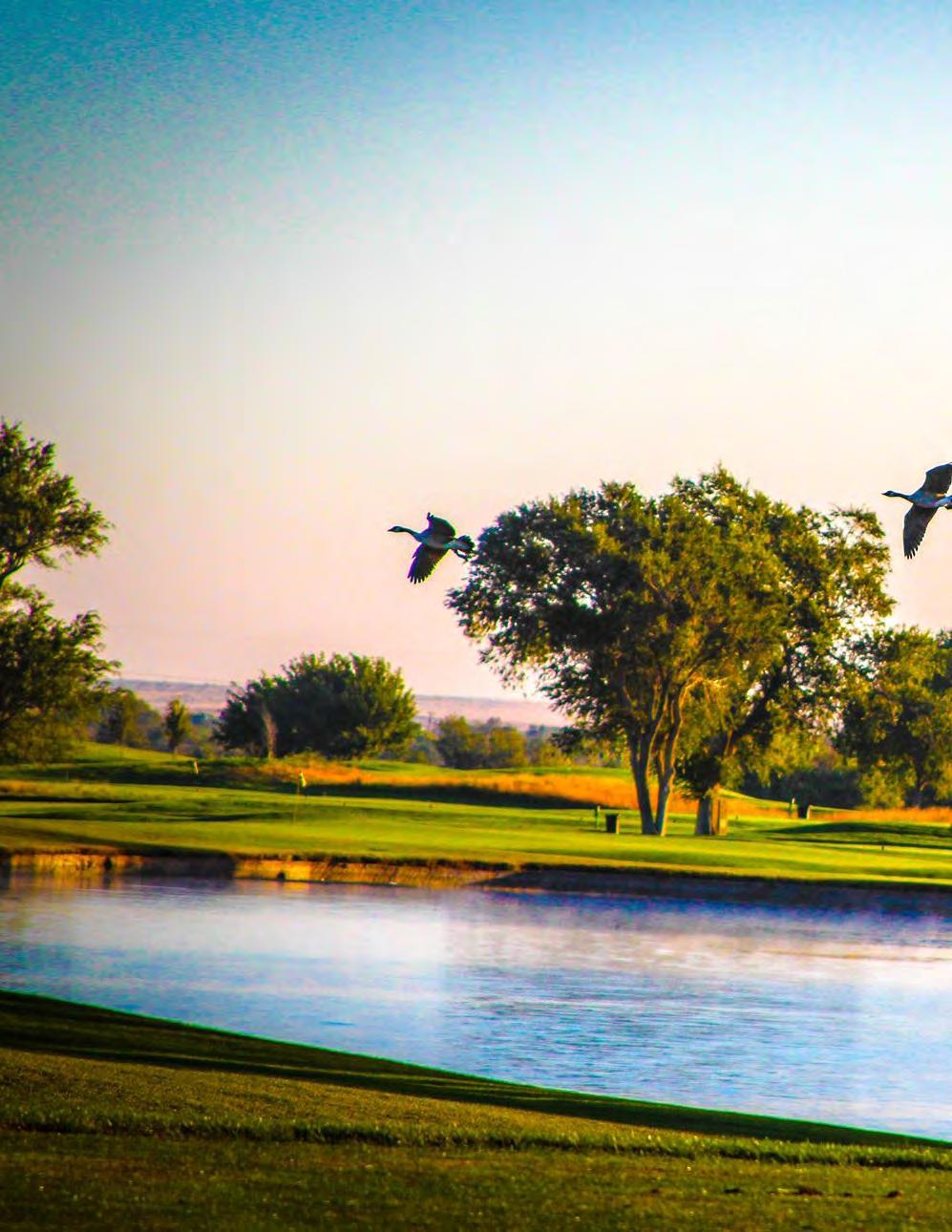

Based on community support and direction being provided by City leadership, the City of Amarillo is at an exciting crossroads. A set of clearly articulated needs, a new strategy to ensure and balance resiliency and equity, and a renewed funding commitment are all setting the stage for positive change and a level of reinvestment in parks and recreation that the community has not seen in decades. With all that said, resources are not unlimited and certain investments come with risks. The Action Plan included within this chapter establishes a framework for prioritization and a set of actions to guide early years of implementation.
While the investment strategy summarized in the previous chapter includes more nuance, the community has voiced their support for getting back to basics (see Figure X). Three of the top four investment priorities are related to maintaining, improving or expanding existing parks and facilities. Adding new parks in unserved areas is the fourth investment priority according to survey respondents.
At the same time, 69% of survey respondents indicated support for increased level of investment in parks throughout Amarillo. The Investment Strategy in Chapter 4 includes recommendations that are intended to guide the City throughout the planning horizon. In order to prioritize the large number of implementation steps, this section introduces an approach to strategic evaluation of identified and unidentified opportunities.
The Master Plan identifies community needs and articulates a strategy for best aligning available resource with recommendations for future investments and operations. As the Master Plan is adopted, there is strong support to increase funding for parks and recreation in Amarillo. However, the exact amount of money that will be devoted to asset management, new capital expenditures, programming and operations is unknown.
The Parks and Recreation Master Plan introduces a tool for City use in evaluating and prioritizing future investments (Table 14). This evaluation tool can be used when balancing available resources with needs as part of the Parks and Recreation Department’s annual budgeting process. The evaluation criteria are organized in two major categories of Equity & Inclusion and Sustainability & Resiliency.

35: Survey Highlights
Investment Priorities
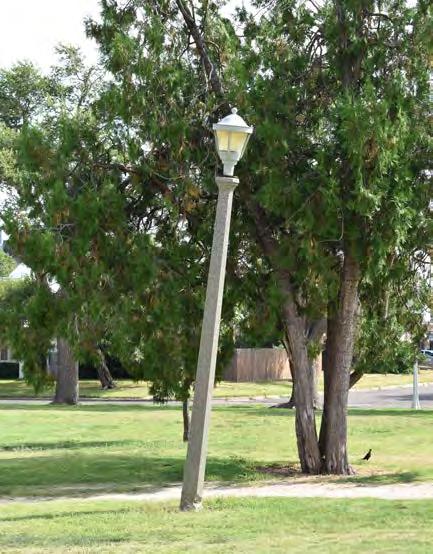
Criteria #1: Provision of active recreation opportunities
Active recreation opportunities promote physical activity, health, and well-being.
No physical activity associated with investment
Limited physical activity opportunities associated with investment
Criteria #2: Provision of passive recreation opportunities
Passive recreation opportunities promote enjoyment of the outdoors, mental health, and well-being.
No passive recreation opportunities associated with investment
Limited passive recreation opportunities associated with investment
Some physical activity opportunities associated with investment, but likely will not increase physical activity
Investment will likely increase physical activity for some residents
Investment creates a new opportunity for physical activity
Some passive recreation opportunities associated with investment, but with a limited audience Investment creates new passive recreation opportunities for some residents Investment creates new passive recreation opportunities for a large number of residents
Criteria #3: Provision of social gathering/interaction opportunities
Social gathering/ interaction helps sustain or strengthen relationships between friends, families, neighbors, and community.
No social gathering/ interaction opportunities associated with investment
Limited social gathering/ interaction opportunities associated with investment
Some social gathering/ interaction opportunities associated with investment, but with a limited audience
Criteria #4: Creation of opportunity for underserved population
Underserved populations include people of color and low-income residents.
No underserved populations benefit from investment
Investment creates opportunity that may benefit underserved populations
Investment creates opportunity that will benefit limited number of residents from underserved populations
Criteria #5: Creation of opportunity for underserved geography
Underserved geographies do not have access to parks, facilities, and/or trails within 10 minutes of home.
No underserved geographies benefit from investment Investment creates citywide opportunity, but with limited access from underserved geographies
Criteria #6: Potential for cost recovery
Cost recovery includes revenue from user fees, sponsorships, grants, and other sources that partially or fully offset costs.
cost recovery potential
Criteria #7: Number of people served per $1,000 spent
The number of people served compared to costs provides a measure of impact.
Investment creates opportunity that is accessible for limited number of residents in underserved geographies
Investment creates new social gathering/ interaction opportunities for some residents
Investment creates new social gathering/ interaction opportunities for a large number of residents
Investment creates opportunity that will have widespread benefit for at least one underserved population
Investment creates opportunity that will have widespread benefit for multiple underserved populations
Investment creates opportunity that is accessible for at least one underserved neighborhood Investment creates opportunity that is accessible for multiple underserved neighborhoods
Some assets have the potential to increase revenues over time through the provision of programs, events, and other more creative revenue-generating strategies. However, with some investments and funding commitments, there could be risks--especially associated with non-traditional tools and strategies. Factors such as COVID-19 and extreme weather—as well as changing recreation and leisure trends that affect participation—affect revenues over time. Cities typically deal with these risks in a few different ways:
• They have funding resources in form of reserves set aside to respond when issues arise.
• They use existing facilities first to ramp up the operational and business side of programming, before making an extensive investment in new infrastructure. The revenues they generate from these programs are set aside to invest in additional facilities gradually.
• They involve equity partners in sharing the costs and risks of facility development and ongoing operations, or they provide incentives for a private partner to build and operate a facility.
• They diversify revenues and funding resources by creating mixed-use venues that generate monies through other uses. This may potentially include lodging, restaurants and other businesses that are taxed to support the major facility. It also may include renting or leasing park land to support related businesses and adjacent uses.
This section further articulates the big moves necessary to align the City’s cost recovery strategy and fee philosophy with the investment strategy included in Chapter 4 and the Action Plan presented throughout the rest of this chapter.
As the Revenue Generation section in Chapter 4, fees should be charged for a greater range of programming delivery means and methods. Furthermore, if revenue is being generated using Park and Recreation assets, a portion of
those revenues should be given to the Parks and Recreation Department. The City’s fee philosophy should ensure that revenues generated through programming, events, and rentals are applied to offset costs associated with maintenance, operations, and asset management.
Per the Restructured Investment Strategy in Chapter 4, there are many opportunities to reduce level of service (LOS) across the system while maintaining most or all core services. As the previous chapter highlights, opportunities to reduce LOS include:
• Reclassifying parks and redefining the associated core elements, especially for Small and Large Neighborhood Parks;
• Reduce the number of permanent restroom facilities in parks, especially in Small Neighborhood Parks;
• Reduce the number of high-maintenance facilities not suited for close-to-home Small Neighborhood parks; and
• Terminate agreements for School Parks in areas that are already served well by City-owned parks.
The City of Amarillo is currently providing direct and indirect subsidies to a number of individuals and groups when a higher level of cost recovery is possible. Larger parks tend to have more opportunities for revenue generating enterprise amenities and facilities. In Large Neighborhood Parks, reservable facilities for small groups and sports should be provided with fees to generate revenue. Multi-Use Community Parks provide an opportunity to increase revenues by expanding programs, fee-based league sports and rental facilities for large group uses. Special Use Sites can provide more revenue with rental facilities and concessions. Finally, Regional Parks should provide revenue-generating programs, events, rental facilities, and enterprise facilities. They also provide opportunities for land leases, naming rights, sponsorships and other revenue sources.
The City of Amarillo Parks and Recreation Department has many opportunities for partnerships, but some of those come with a high level of risk. A high level of risk can also come with a high level of reward, but the City should balance the opportunity to increase revenue with the risk of losing or wasting tax payer dollars. Risk mitigation strategies should be explored in order to structure creative partnerships that better share risks and increase the likelihood of upside for the City and its partners. The City should evaluate all partnership opportunities to ensure that risks to the City are minimized, the City’s level of investment is appropriate, the facility meets a community need, and the partner has a business plan for long-term facility operations and asset management.


One of the major reasons that parks and recreation funding has not kept pace with needs is that the Parks and Recreation Department has largely relied on entirely General Fund dollars for a number of years. A more diverse funding strategy should include a Council approved bond, a voterapproved General Obligation (GO) bond, grants, land leases, and increased parkland dedication and fees in lieu.
The diversification strategy may include establishing partnerships to improve undeveloped land for recreation or recreation-supportive uses. An example of this approach is highlighted in the John Stiff Park Real Estate Study summarized below.
The area around John Stiff Memorial Park is experiencing the City’s largest amount of residential growth, including households with higher than average incomes. There is a growing demand for additional retail, entertainment, and services in the area. The real estate study proposes using park outparcels to support recreation and
entertainment businesses, or retail and general commercial uses. The monies can be used to enhance park facilities. The strength of the John Stiff real estate proposal is that it leverages resources (existing land and location) to create revenues for needed park projects. It does not recommend building a major facility to generate revenues.
The temptation to construct something new is difficult to pass up for most communities. Focusing on new construction without devoting the proper attention to existing facilities can lead to deferred maintenance and high-cost replacement projects. In Amarillo, the situation is complicated by the fact that new residential areas will need new parks within walking distance. Some new, trendier, and more engaging facilities should be added to existing parks when older, worn amenities are removed—instead of just replacing what was there. These new facilities will add to park maintenance needs, requiring more maintenance and operations funding even if increased capital funding is provided.

Deferred maintenance and replacement costs are already extremely high. The City should maintain its focus on the smaller moves needed to enhance the park and recreation system. For the development of any new major facilities, the following should be guaranteed:
• A business operations and financial feasibility plan (prior to development)
• A facility operator and sufficient staffing (cityprovided or contracted)
• Sufficient maintenance funding and staffing
• A source of funding for ongoing improvements and asset management
• Public, voter and stakeholder support
• An equity partner(s) or private partner to drive the project
• Coordination and sequencing with other City initiatives, such as the convention center, which may be able to support some type of indoor programming and tournaments.
The Parks and Recreation Department has become relatively adept at doing less with more. The ability to maintain existing assets over the years to the extent that they pass the “eye test” is a testament to staff’s resourcefulness. However, it also contributed to the lack of prioritizing increased funding for the Department. Thus, it will be critical to continue to be transparent about park, facility and programming needs and sufficiently communicate both progress and remaining/new needs.
This Master Plan includes a call to action to continue to fund park projects and services— immediately and also in the future. It includes recommendations to establish a 501(c)(3) Parks, Arts, and Beautification Non-Profit to continue to cultivate community support and investment in the park and recreation system. In Appendix D, Goal 7 identifies additional strategies to ensure fiscal and economic resilience while leveraging resources to support Amarillo’s priority actions for parks and recreation.
The previous sections provide the framework for identifying Priority Actions to guide resources over the course of plan implementation. This section summarizes and organizes the Priority Actions associated with the Investment Strategy described in Chapter 4.
Table 15 describes priority actions and projects to guide implementation. For each action, the table identifies a targeted timeline in terms of ShortTerm (0-2 years), Mid-Term (3-5 years), and LongTerm (6-10 years). For each priority action, the table also includes supporting information related to Responsible Party and Service Type.
The seven key project types used to organize the Priority Actions include the following:
1. Playground Replacement
2. Scaled-Back Neighborhood Parks
3. Sports Field Lighting Replacement
4. Equity Enhancements in High Need Areas
5. New Parks
6. Annual Allowance for Core Asset Management/ Replacement
7. Other

Table 15: Phased Priority Actions
Priority Action/s (organized by Key Projects)
Playground Replacement
Replace or Repair Playgrounds and Play
Structures in Critical Condition in City Parks
• Benton Park; East Park; Glenwood Park; Greenways Park; John Stiff Memorial Park; Mary Hazelrigg Park; Pleasant Valley Park; Sam Houston Park; San Jacinto Park; Sanborn Park; Southeast Park; Southlawn Park; Stephen F. Austin Park; Thompson Memorial Park; Will Rogers Park
Replace or Repair Playgrounds and Play
Structures in Critical Condition in School Parks
• Margaret Wills School Park (if agreement isn’t terminated); Olsen School Park; Ridgecrest School Park; Park Hills Elementary School Park (if agreement isn’t terminated); South Georgia School Park; Sunrise School Park (if agreement isn’t terminated); Willow Vista School Park
Scaled-Back Neighborhood Parks
Decommission Restrooms
• Decommission restrooms in Small Neighborhood Parks at the end of their lifecycle.
• Evaluate restrooms in other parks to determine their utility and condition to determine any additional restrooms should be decommissioned.
Replace Unused or Underutilized Turf
• Evaluate parks to identify turf areas that are unused or underutilized and replace traditional turf grass with low maintenance, low water plantings.
Sport Field Lighting Replacement
Replace Sport Field and Sport Court Lighting in Critical Condition
• Amarillo National Tennis Center; Benton Park; Bones Hooks Park; Estes Park; El Alamo Park; Ellwood Park; Forest Hill School Park; Gene Howe Park; Glenwood Park; Hines Memorial Park; John Stiff Memorial Park; Martin Road Softball Complex; Mary Hazelrigg Park; Paramount Park; Pleasant Valley Park; River Road Park; San Jacinto Park; Southeast Park; Southeast Softball Complex; Thompson Memorial Park; Will Rogers Park
Responsible Party (P&R, Other Dept., Schools,)** Service Types (Core, Ancillary, Shared-Cost, Enterprise, NonCore)
P&R; Schools Core; Shared Cost
Non-Core
P&R Non-Core
P&R; Schools (for Forest Hill School Park) Core; Shared-Cost; Enterprise
Identify and Install Culturally Appropriate Recreation Amenities in More Diverse Neighborhoods (e.g., futsal, seepak takraw) a a a P&R; Schools Core; Shared Cost
Install New, Improved and Expanded Picnic and Gathering Spaces a a
Core
Table 15 (continued): Phased Priority Actions
Priority Action/s (organized by Key Projects) Timeline*
Install Shade Structures for Sport Courts and Playgrounds in Parks with High Use and Little to No Tree Canopy
Develop Additional Parks in Unserved Areas
• See below under New Parks
New Parks
Develop and Maintain New Small Neighborhood Parks to Serve New Residential Development
• 1 small neighborhood park in NE
• 2 small neighborhood parks in SE
• 2 small neighborhood parks in SW
Develop a New Large Neighborhood Park to Serve New Residential Development
• 1 large neighborhood park in NW
Develop Additional Parks in Unserved Areas
• 1 multi-purpose community park in NE
• 1 small neighborhood park in NW
Develop a Bike Park
• Develop the 9th Avenue Bike Park.
Add Maintenance Services
• Add an additional Capital Project Manager/ Planner and maintenance staff commensurate with new parks and facilities (FTE to be determined).
Responsible Party (P&R, Other Dept., Schools,)** Service Types (Core, Ancillary, Shared-Cost, Enterprise, NonCore)
P&R; Schools Core; Shared-Cost
P&R Core
P&R Core
P&R Core
P&R Core
P&R Core
P&R Ancillary
Establish and Allocate Annual Allowance for Core Asset Management/Replacement
Repair or Replace Other Assets in Critical Condition
• Refer to 2019 Asset Management Plan
• Update assets based on the goals, objectives, and strategies noted in the Master Plan. Consider evolving demographics and community culture, avoiding “like for like” replacements that reflect past instead of future needs.
Add Maintenance Services
• Add maintenance staff for deferred needs (at least 2-3 FTE)
Other
Increase Programming
• Add a ½ FTE volunteer/recreation coordinator. a
Support Key Initiatives
• Adopt Public Arts and Beautification Plan and revised Hike and Bike Plan.
• Hire a new Arts/Beautification Coordinator (FTE to be determined).
* Timeline Key - Short-Term = 0-2 years; Mid-Term = 3-5 years; Long-Term = 6-10 years
P&R; Schools Ancillary
P&R; Other Dept. Ancillary
P&R Core
P&R Ancillary, Shared Cost
** Responsible Party Key - P&R = Parks and Recreation Department; Other Dept. = Other City Department/s; Schools = Amarillo Independent School District or Private School/s
Implementation of the Parks and Recreation Master Plan for the City of Amarillo will likely require funding from a number of sources. The variety of park, facility and trail types included in the Master Plan and associated documents; the integration of recreation with health, equity, and economic development; and the identification of partnership opportunities could be supported by a variety of potential funding options.
It is recommended that the City of Amarillo dedicate a portion of the General Fund to ongoing park improvements, operations and programming throughout the community. City leadership should also explore the incorporation of park-related improvements through a future bond measure as additional investment in parks and recreation has received substantial community support.
Some of the following sources should also be considered as part of the overall implementation plan. It is important to consider what funding sources might be available to help the City supplement the cost of implementation. It should be noted that several of the funding sources identified below require a local contribution or local match.
Grants are an obvious target for public agencies looking for project funding. However, the application, matching, management and reporting requirements keep grants from being truly free money. With many granting entities, including Texas Parks and Wildlife, the proven ability to maintain projects once they are in the ground is a growing focus.
• Texas Parks and Wildlife Department (TPWD)
• Local Parks Non-Urban Outdoor Recreation Grant (population 500,000 or less; grant ceiling of $750,000)
• Local Parks Non-Urban Indoor Recreation Grant (population 500,000 or less; grant ceiling of $1 million)
• Community Outdoor Outreach Program (COOP) Grants
• Recreational Trails Grants (up to 80% of project costs with maximum of $200,000 for nonmotorized trail grants)
• Texas Department of Transportation (TXDOT)
• Transportation Alternatives Program (TAP)
• State Energy Conservation Office
• Energy Efficiency and Conservation Block Grant
• Highway Safety Improvement Program
• Surface Transportation Program
• Federal Transit Administration Programs
• Transportation and Community and System Preservation
• The Trust for Public Land
• Communities Foundation of Texas
• Meadows Foundation
• Land Trusts
Sponsorships and donations are a potential source of funding for capital improvements, programming, and even maintenance and operations in some cases. Reinvesting in Amarillo’s parks and expanding the City’s programming options can create new opportunities to engage and excite sponsors and donors. For many parks and programming areas, there are likely community partners that could bring funding to the table. For example, health and fitness programming, from classes in parks to engaging employee fitness programs, would be on brand for health care providers or insurance companies. A donor catalogue and/or acknowledgment program can be another effective way to help fund projects and programs.
Through expected revisions to the Amarillo Zoning Ordinance currently under final review, new residential subdivisions may be required to provide, through dedication or alternative means, neighborhood parks and community parks sufficient to meet the proportionate demand created by the subdivision and resulting development. Appendix E defines these requirements and also identifies development guidelines that can be assigned costs and used to calculate and set fees in-lieu of land development. This funding and land resource will be critical for supporting the acquisition and development of new parks in growing residential areas.
The Amarillo Parks and Recreation Department already has several formal partnership agreements with School Districts. These partnerships should be assessed regularly to determine if they are benefiting both entities and to see if there may be enhancements to the partnerships that make them even more effective. Other entities with which to explore partnership opportunities may include Potter County, local colleges and universities, hospitals and medical clinics, and Texas State Parks.
Amarillo’s largest parks – including John Stiff Park, Rick Klein Park, and Thompson Memorial Park – present exciting opportunities for publicprivate partnerships that can leverage the City’s land holdings and benefit the community in a number of ways. Land leases and development agreements can create funding streams and/ or opportunities for significant investment in the Amarillo’s regional parks. Private development that can be complementary to regional park amenities include restaurants and family entertainment uses, hospitality, health and wellness clinics and offices, educational facilities, and even housing.
Now at a crossroads, the City of Amarillo is about to take an exciting next step towards making a greater investment in its park and recreation system. With community support and collaboration, the Parks and Recreation Department is well-positioned to coordinate with City leaders, stakeholders, partners, and residents to fund enhancements that will:
• Support recreation for youth, families and residents of all ages
• Foster community health and wellbeing
• Provide greenspace to support community aesthetics
• Reflect the cultural preferences and needs of our diverse community
• Foster economic prosperity and growth
• Usher in a new era of resilience
By working together, we can create a more livable community by providing vibrant parks and recreation opportunities that promote our heritage, resilience, connectivity, and diversity.
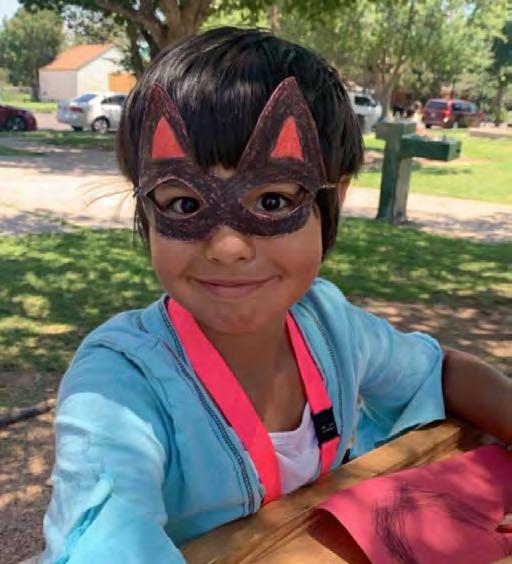

Parks and Recreation Master Plan
Our Parks + Our Community’s Future
FINAL PLAN | SEPTEMBER 2021















Parks and Recreation Master Plan
Our Parks + Our Community’s Future
APPENDICES | SEPTEMBER 2021


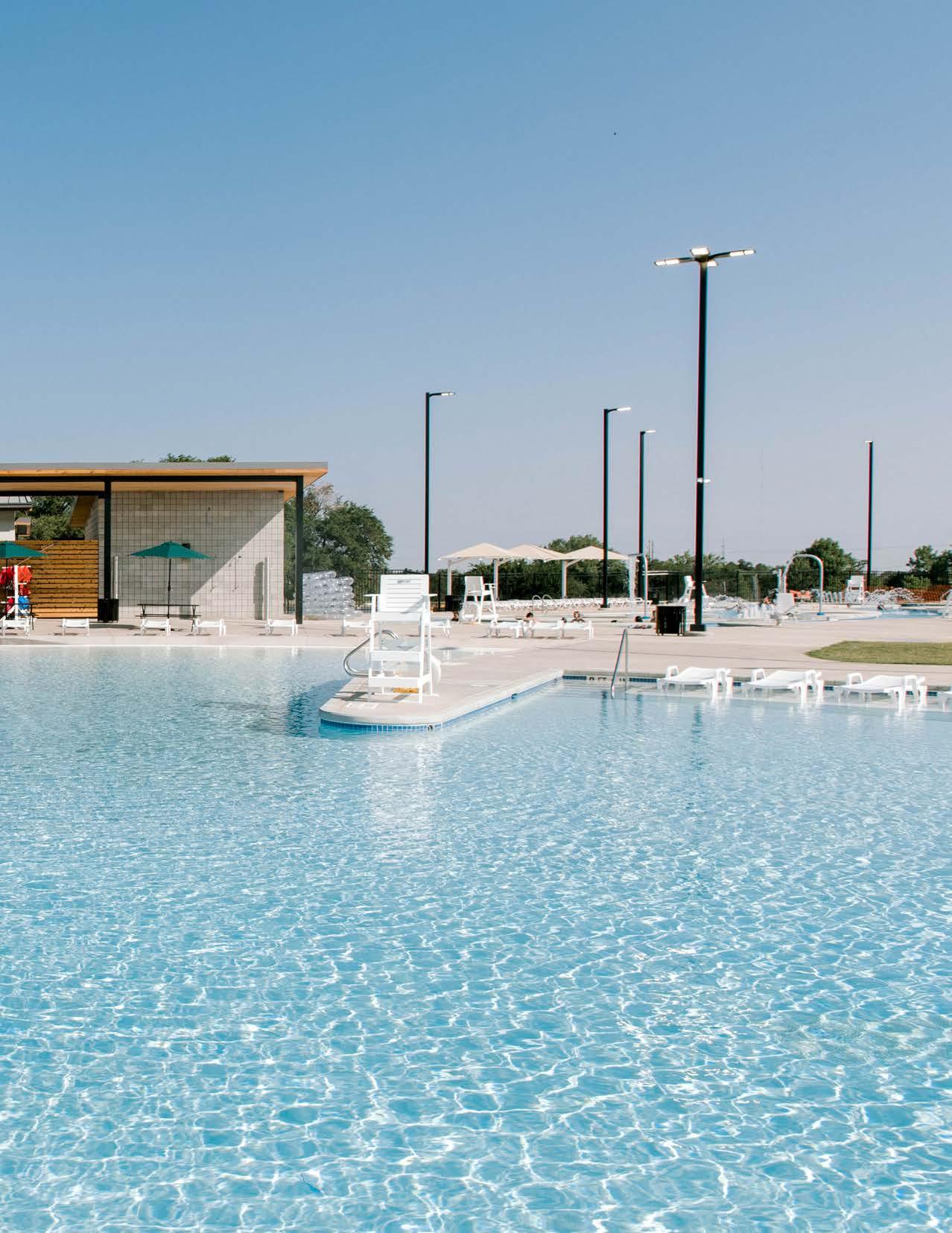
As part of the Parks and Recreation Master Plan, Amarillo updated its park and recreation facility inventory. This appendix presents the revised inventory and classification system.
In the past, the City’s park inventory had included all sites maintained by Department of Parks and Recreation for recreation purposes. It included several school parks that had been dedicated when residential subdivisions were platted. The school park inventory was cross-checked to determine where the City of Amarillo owned school parks and where the City had been maintaining sites that are owned by one of three School Districts. This process informed discussions around park access, maintenance responsibilities, and efforts to rightsize the park system.
The City’s park inventory is now separated into two separate tables:
• Table A-1: Amarillo Park and Facility Inventory (City-Owned Sites)
• Table A-2: School Parks Summary (CityOwned, Jointly-Owned and School-Owned Sites)

Table A-1 identifies City parks by classification. The inventory is divided into four main park classes and various park types.
• Regional Parks are larger parks, typically ranging from 50-500 acres in size, that attract visitors from the entire city and surrounding region. These sites typically support large group gatherings and specialized facilities, such as sports complexes, swimming pools, and fishing piers. Regional parks may include water features and/or preserve natural areas. Some sites support recreation tourism and revenue-generation as daytime destinations. As such, they may include amenities such as concessions, event space, parking, permanent and portable restrooms to support all-day and large-group use.
• Community Parks are mid-size parks that serve several neighborhoods or a portion of the city. These are divided into two types:
o Multi-use Community Parks typically range from 10-20 acres in size. These parks support active and passive recreation activities, recreation programming and group gatherings through the provision of destination playgrounds, group and individual picnic areas, sports fields, and sports courts, mixed with communityserving amenities such as stages/ amphitheaters and splash pads. These sites are accessible by walking, biking and driving. They include support amenities such as off-street parking, restrooms, and shade.
o Community Facilities are single-purpose sites that vary in size to support a specialized use. Attracting people from across the city, these parks include major facilities or spaces such as golf courses, community centers, sports complexes, and swimming pools, and urban plazas not located in a larger, multi-use park.
• Neighborhood Parks are smaller parks, approximately 3-12 acres in size, intended to serve nearby neighbors within walking or biking distance. These sites provide close-to-home playgrounds, picnic areas, sports fields, sports courts and open grass areas for leisure and play. They are divided into three types:
o Neighborhood Parks are City-owned parks that serve nearby neighbors.
o City-Owned School Parks are neighborhood-serving parks located adjacent to schools. These sites are Cityowned and maintained by the Parks and Recreation Department.
o Jointly-Owned School Parks are neighborhood-serving parks on sites that are co-owned with schools. The City owns part of the site, even though it may maintain the entire property as determined through joint use agreements. At some sites, the Parks and Recreation Department has also funded facility development/ replacement or other improvements on the school’s portion of the site. The acreage shown is the City-owned portion of the site only.
• Other Parks are recreation space and/or greenspace reserved for other uses.
o Other Open Space and Sites include miscellaneous sites that are leased to other entities or currently undeveloped and held in reserve for potential future use.
o Linear Parks are elongated corridors that facilitate pedestrian and bicycle movement through off-street trails. These corridors may include adjacent open space or greenways.
Table A-2 identifies school parks, which are sites maintained by the Parks and Recreation Department for outdoor park and facility use by nearby neighbors. Adjacent to schools owned by the Amarillo Independent School District (AISD), Canyon Independent School District (CISD) and River Road Independent School District (RRISD), school parks have ensured that amenities such as playgrounds and sports courts are available for local use.
Sites are divided based on ownership to see Cityowned acreage and school-owned acreage. Acreage data is based on records from the PotterRandal Appraisal District. The school-owned acreage includes the entire site owned by the school district including buildings, parking, etc.

3


Amarillo’s Asset Management Plan (AMP), created by Kayuga Solution, assessed the conditions of various facilities, amenities and infrastructure in city parks, i.e. assets. The study was completed in the early stages of the Master Plan process.1 This appendix summarizes key findings and data by park site that help guide decisions on asset replacement.
In total there are approximately 16,000 assets in the Park Management System. The majority of the park assets (64%) were rated “good or as expected with age.” Of the total park assets, 24% were considered failing or critical (Figure B-1). The sum of all replacement costs for park assets is estimated, in 2019 dollars, to be approximately $103 million. Assets in school parks would add another $9.1 million.




1 Because the AMP was completed before the Master Plan inventory was updated, numbers of amenities, facilities, and park sites may differ.
Table B-1 summarizes the estimated asset replacement costs for each park. The table describes:
• Total replacement cost: The total replacement costs for all assets at a given location, including park and building assets.
• Costs of Immediate Replacement Needs: Assets found to be in either poor or failed condition should be addressed for immediate replacement.
• Costs of Maintenance and Rehabilitation Needs: Assets needing any maintenance or rehabilitation work should be addressed at least within the next three years.
• Percent of Park Assets that need Immediate Replacement or Rehabilitation: Park asset values determined by asset costs and needs, i.e., cost of immediate replacement, maintenance and rehabilitation needs divided by total park asset replacement costs.
Source: All data are from the Asset Management Plan, Kayuga Solution, 2019.
*Note: Park asset values are determined by asset costs and needs, i.e., cost of immediate replacement, maintenance and rehabilitation needs divided by total park asset replacement costs.
**Note: Includes Tennis Center, Southwest Pool and Southwest Softball Complex
***Note: Includes Amarillo Zoo

An access analysis evaluates park service based on the actual routes and distances people must travel to get to parks or recreation facilities. It is based on the notion that everyone benefits from living within walking distance of park. Using the modeling software, Urban Footprint, and ArcGIS Network Analyst™, park service areas were mapped to identify where residents have access to park land within specific travel distances. The maps also show characteristics of the areas that are served and unserved. These maps were evaluated to identify gaps in service as well as park needs.
Amarillo’s current standards are based on providing parks within 1-mile from all residents. However, the City recognizes that smaller parks may only draw residents from a 1/4-mile away. The industry standard for access to park land is 1/2-mile, which equates to approximately a 10-minute walk. As such, this analysis evaluated park access within a 1-mile, 1/2-mile and 1/4-mile service reach.
The map illustrates residential areas that are served by a “neighborhood-serving park” owned or jointly-owned by the City of Amarillo. This includes all parks classified as neighborhood parks, community parks, City-owned school parks and jointly-owned school parks, recognizing that each of these sites help meet nearby needs for park land. This preliminary analysis helped identify service gaps, numbered on the map here. These were later refined into the more detailed analysis that appears in Chapter 2.
This appendix presents the series of maps and tables that helped identify areas of greatest need based on community demographics, poverty levels, residential density, and nearby opportunities.
C-1: City-Owned Neighborhood-Serving Parks Gap Analysis


Residential gap areas were identified by assessing the residential parcels beyond a 10- or 20-minute walk to neighborhood-serving parks. Gap area factored in major transportation barriers, e.g., arterial streets, railways, etc. The analysis revealed that:
• 17 residential areas are not served by a park within 1 mile
• 35 residential areas are not served by a park within a ½ mile
The 35 residential gap areas were evaluated in more detail to determine the severity of community need beyond the 10-minute walk to a neighborhood-serving park. The categories include:
• City Quadrant: Location of the gap areas per the City’s statistical quadrants
• Unserved residential area beyond 20-min: Identifies unserved or partially unserved areas beyond the City’s 20-minute walk standard (1mile)
• Below the Poverty Level: Identifies gap areas that have a portion of their area with 50% or more of the population below the poverty level and/or the majority of the gap area’s population is 30% or more below the poverty level
• Non-white or Hispanic/Latino: Identifies gap areas that have a population that is 50% or more non-white or Hispanic/Latino
• Higher housing density: Identifies gap areas that have a relatively fair amount multi-family housing and 20 residential dwelling units per acre or greater
Table C-1 shows the results of the equity and access analysis. Gap areas with two or more check marks are highlighted in yellow to draw attention to the severity of needs in key areas. Areas that are unserved beyond the City’s 20-minute walk standard were assessed further to determine if there are additional recreational opportunities nearby, including planned parks for future growth areas. Shown in Table C-2, the analysis then considered opportunities to meet needs in these areas, such as:
• The presence of other types of City parks, even if these do not offer the same experience or types of facilities as neighborhood-serving parks
• The presence of schools with recreation space maintained by the City Parks and Recreation Department (School District-owned school parks)
• The presence of other public or private schools
• The presence of other public or private recreation amenities, facilities, or greenspace
Attached to Appendix C are the analysis maps that informed the park equity and access gap analysis. Each map includes a description of content and key findings. The following were mapped to inform equity discussions:
• Map C-2: Walking access to all City-owned parks
• Map C-3: Unserved residential areas (based on all City-owned parks)
• Map C-4: Walking access to City-owned parks developed to serve nearby neighbors
• Map C-5: Unserved residential areas (for these neighborhood-serving parks only)
• Map C-6: Population below poverty level
• Map C-7: Population that identifies as Hispanic
• Map C-8: Population that identifies as African American
• Map C-9: Population that identified as Asian American
• Map C-10: Residential density
• Map C-11: 10 and 20-minute walksheds for City-owned parks serving nearby neighbors (excluding all school parks)
• Map C-12: 10 and 20-minute walksheds for City-owned parks serving nearby neighbors (including school parks)
The final two maps were critical in making recommendations regarding maintenance agreements for school parks. These appear in Chapter 4.
The Colonies (HOA) greenways and pocket parks; Amarillo Town Club (aquatics and fitness)
Northern gap area may be served by school site with a use agreement; the area is developing and may or may not have neighborhood parks; further evaluation required
The area is served by adequate greenspace, but lacking in park facilities; adding facilities to existing HOA park space may better serve residents
This area is currently served by a school park; limited other neighborhood park opportunities identified; opportunity to develop another site
Served by a school park through agreement and Medical Center Park facilities; Island Rail Trial offers another recreation opportunity
Church at Quail Creek; apartment tennis court
A small area that is not served recreationally; opportunity to provide a new park as the area develops
The area spreads out around a golf course with private recreation options; the southern portion of the gap area is not served by any neighborhood parks although common space social trails are prevalent
The southern area is served by a school park; another opportunity is needed to the north such as developing the Montgomery Park site
Apartment pools and fitness facilities; HOA park
Northern gap area served by a school park; some apartment complexes may be adequately served with recreation opportunities; the southern most neighborhood is without neighborhood-serving amenities with opportunities to add some
Northern gap area meets needs with amount of school parks but needs agreements for public access; southern portion has a private opportunity in Netplex, but is unserved otherwise
C-2 (continued):
Recreation or Greenspace in
Areas ID Citymaintained Park or Recreation Area School Site; Citymaintenance Agreement School Site; Districtmaintained Other Opportunity Conclusions
19 Julian Parkways
Tascosa High School; Bivins Elementary School West Lawn Park; apartment pools, playgrounds and fitness areas
25 Rick Klein Park Lawndale School Park; Oakdale School Park Caprock High School
27 Martin Road Regional Park
Emerson Elementary; Rogers Elementary, Mann Middle School; Palo Duto High School
Area currently meets park needs but use agreement for public access is needed; opportunity to add facilities to Julian Parkways and West Lawn Park
Rural lots without neighborhood park facilities; opportunities for new park in community or in developing area west
Area currently meets park needs but use agreement for public access is needed for schools; Access to facilities at Rick Klein Park North
Meets community recreation needs but requires agreement for public access
Large lot rural area with some new development; opportunity for better access to access the existing school park and/or utilize E Amarillo Creek corridor 32 NE 17th Ave Open Space Forest Hill School Park
Whittier Elementary; Travis Middle School
Currently served by school park; potential for need to develop another site 33 Mesa Verde School Park Dirt Track Speedway
Currently served by school park; no other neighborhood park opportunities identified 34
Area without neighborhood park facilities; few dispersed home plus mobile home park whose recreation needs may be met elsewise
Contains unserved area beyond the City’s 20-minute walk standard
Contains unserved area beyond the City’s 20-minute walk standard and contains 2 or more checkmarks for poverty level, non-white/Hispanic, and/or higher housing density
Table C-3 summarizes these findings, showing only the sites that include two or more of the four factors that mark severity of need). Furthermore, the table annotates other recreational opportunities in the gap areas that could help serve residents’ needs.
ID (residential area not within 1/2-mile of neighborhoodserving park) City Quadrant
Severity of Need Assessment Other Opportunities to Meet Needs Contains unserved residential area beyond 1 mile Below the poverty level Nonwhite or Hispanic/ Latino Higher housing density
Table C-3: Summary of Neighborhood-Serving Park Needs
Other Cityowned Park School Site Maintained by City Other School HOA Park, or Opportunities
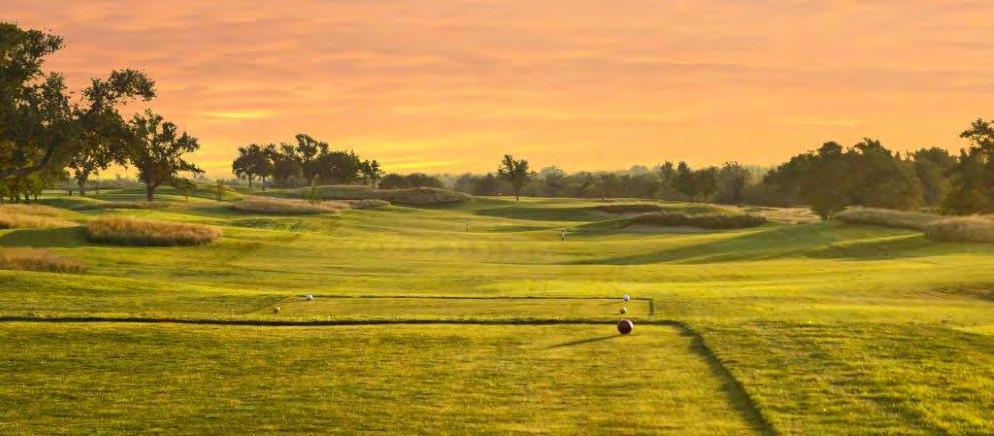
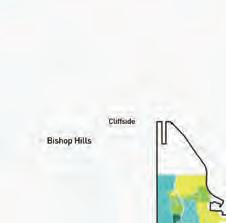

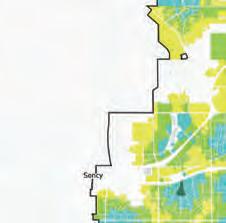

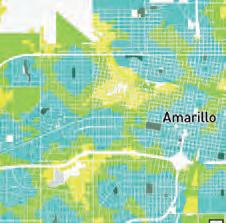

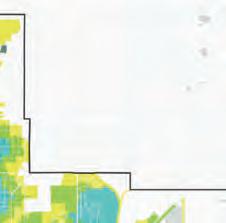
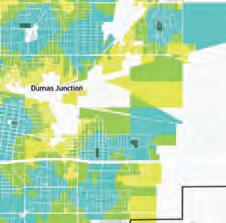


Unserved residential areas (based on all Amarillo-owned parks)
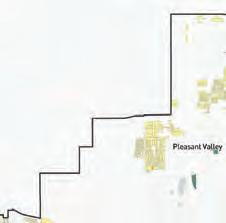
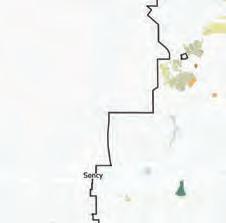


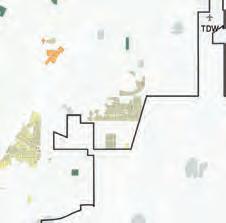

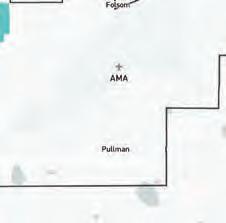
Approach:

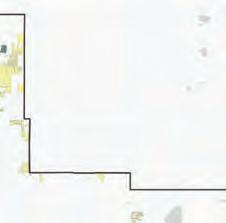


Map C-3: Unserved residential areas (based on all City-owned parks)


All City-owned parks are symbolized as dark green polygons. From those polygons, current park service areas were mapped to identify where residents have access to park land within specific travel times. The time ranges used for this map show walking distances in three ranges, is less than 10 minutes (within a 1/2 mile), 10-15 minutes, and 15-20 minutes.
Key Finding:
Most residential and commercial areas in Amarillo have Cityowned parks or green spaces within a 20-minute walk.


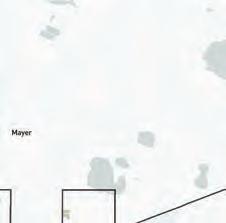
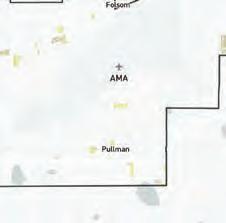
Approach:



Residential gaps to parks are determined by assessing the areas beyond a 20-minute walk to City-owned parks (symbolized as dark green polygons). The yellow and orange colored parcels represent the residential gaps and define their land uses.
Key Finding: The residential gap areas reside primarily on the periphery of the city and likely include other opportunities for recreation that is not provided by the City.



Walking access to all Amarillo-owned neighborhood-serving parks
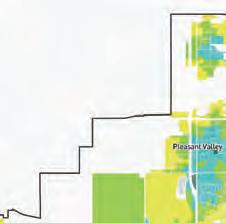


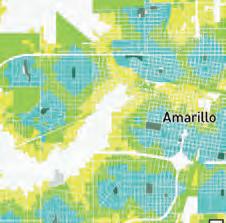
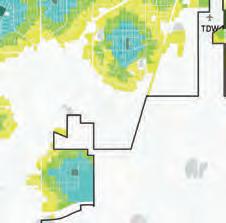

Unserved residential areas (based on Amarillo's neighborhood-serving parks)



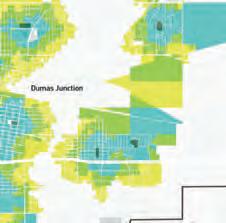
Approach:

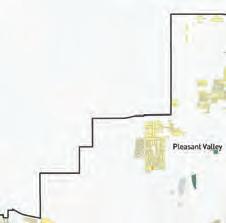
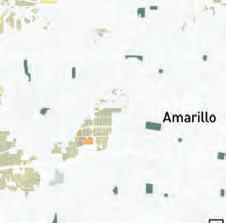





An attempt to identify City-owned parks that are neighborhood-serving, a selection of City-owned parks was established to include neighborhood parks, community parks, and City-owned or jointly-owned school parks. The results are shown as dark green polygons. From those polygons, current park service areas were mapped to identify where residents have access to park land within specific travel times. The time ranges used in this map show walking distances in three ranges; less than 10 minutes (within a 1/2 mile), 10-15 minutes, and 15-20 minutes.
Key Finding:
Neighborhood-serving parks are well distributed across the center of Amarillo covering most of the area within a 20-minute walk. However, departing the from the core of the city yields access gaps.

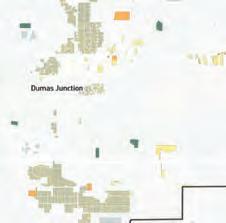




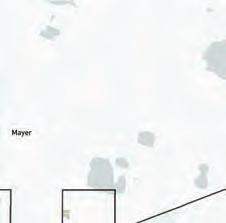
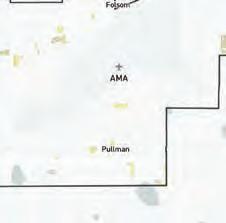
Approach:


Residential gaps to parks are determined by assessing the areas beyond a 20-minute walk to City-owned neighborhood-serving parks (symbolized as dark green polygons). The yellow and orange colored parcels represent the residential gaps and define their land uses.
Key Finding:
The residential gap areas that lack neighborhood-serving amenities reside primarily in the southern and eastern portions of the city, yet two large clusters are identified west of the city center. These gap areas require further analysis to determine other neighborhood-serving parks and facilities that may not have been included in this analysis.



Map C-5: Unserved residential areas (for these neighborhood-serving parks only)
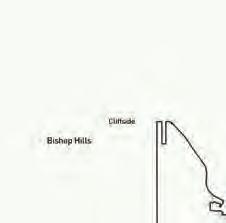
Percent of population below the poverty level (per Census block group)
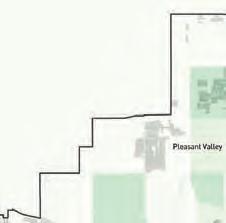





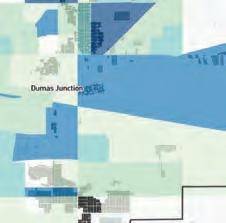


Percent of population that identifies as Hispanic (per Census block group)
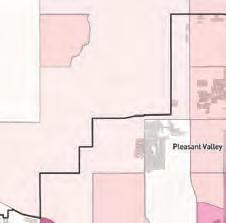


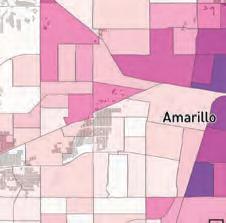
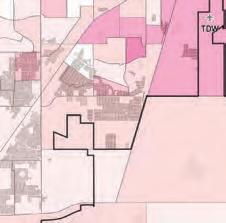


Approach:
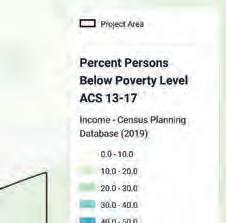

Income distribution data projected at the block group level is a subset of the 2019 Census Planning Database that uses data from the 2010 Census and the 2013-2017 ACS. The results for percent of the population below the poverty level (per corresponding household size) are overlaid on residential parcels that lack access to a neighborhood-serving park (identified as black parcels).
Key Finding:
Central, east and west Amarillo contain block groups with the majority of the population below the poverty level. These block groups and those adjacent, with 20%-50% of the population below the poverty level, contain entire neighborhoods lacking neighborhood park access.





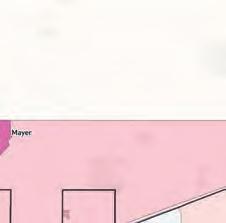

Approach:
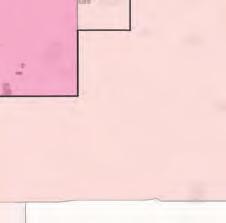
Map C-7: Population that identifies as Hispanic
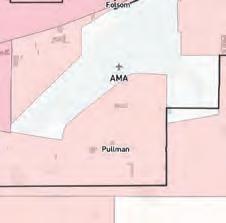

Race and ethnicity data projected at the block group level is a subset of the 2019 Census Planning Database that uses data from the 2010 Census and the 2013-2017 ACS. The results for percent of the population that identifies as Hispanic are overlaid on residential parcels that lack access to a neighborhood-serving park (identified as black parcels).
Key Finding:
Neighborhoods with the majority population identifying as Hispanic are prevalent in eastern Amarillo. Within that area, two to three residential clusters that lack access to neighborhood serving parks are located adjacent to Grand Street. Other block groups across the city with a population that identifies as Hispanic (10%-50%) are spread throughout most residential areas that lack neighborhood park access.




Percent of population that identifies as African American (per Census block group)
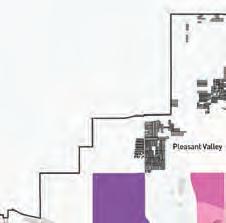


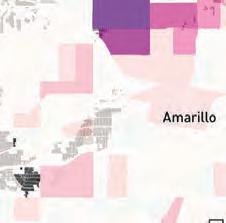
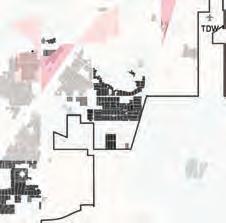



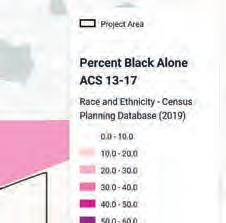
Approach:

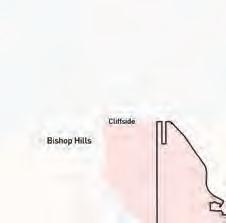
Percent of population that identifies as Asian American (per Census block group)
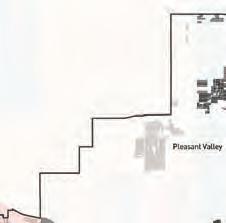




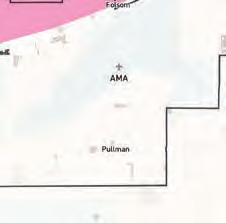
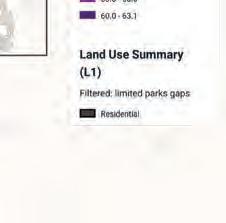
Race and ethnicity data projected at the block group level is a subset of the 2019 Census Planning Database that uses data from the 2010 Census and the 2013-2017 ACS. The results for percent of the population that identifies as African American are overlaid on residential parcels that lack access to a neighborhood-serving park (identified as black parcels).
Key Finding:
North central Amarillo contains the majority of block groups with individuals who identify as African American. Furthermore, block groups with individuals who identify as African American (between 10%-60%) and have limited access to neighborhood serving parks are spread across the inner parts of the city.
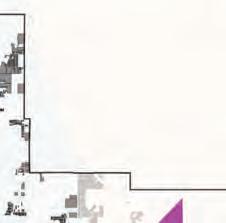
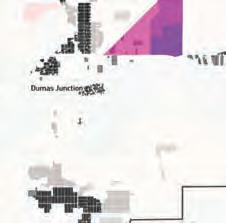




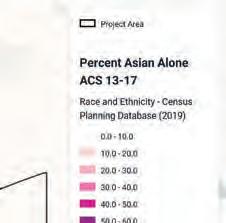
Approach:



Race and ethnicity data projected at the block group level is a subset of the 2019 Census Planning Database that uses data from the 2010 Census and the 2013-2017 ACS. The results for percent of the population that identifies as Asian American are overlaid on residential parcels that lack access to a neighborhood-serving park (identified as black parcels).
Key Finding:
The primary cluster of block groups with individuals who identify as Asian American (northeast) has access to neighborhood serving parks. An area just west of the city center and an area to the northwest with 10%-40% of the population who identify as Asian American contain parcels lacking neighborhood park access.




Residential dwelling unit density

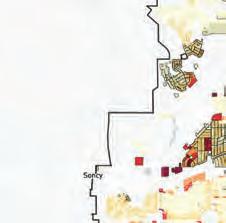






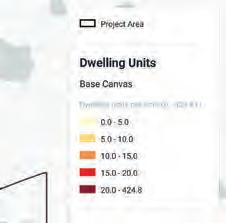
Approach:


Dwelling unit density is calculated per acre for all residential parcels in Amarillo. Residential use park gaps are underlaid in black. The density ranges were divided into 4 categories based on national averages for smaller communities and subdivisions in America. Six units per acre and below is typical of detached single family housing, whereas, 20 units per acre plus represents high-density townhouses and other multi-family dwellings.
Key Finding:


Denser residential areas in the city are less likely to have private outdoor space and have more need for a neighborhood park. Areas with greater densities and less park access are identified along Interstate 40, in northeast Amarillo, and southwest Amarillo.


Map C-11: 10 and 20-minute walksheds for City-owned parks serving nearby neighbors (excluding all school parks)

Map C-2: 10 and 20-minute walksheds for City-owned parks serving nearby neighbors (including school parks)



Appendix D identifies eight goals for the park and recreation system, along with the systemwide objectives and strategies that will guide the provision of parks, recreation, and related services over the next ten years. These elements are numbered for ease of reference; they do not appear in priority order. They are structured in the following format:
Definition of each goal.
X.1. Objective
a. Strategy
i. Clarifying recommendations
The strategies represent a mix of recommendations that should be taken to enhance the park and recreation system to support the following goals:
• Goal 1: Strategically Maintain and Manage Assets
• Goal 2: Create Context-Sensitive Parks
• Goal 3: Ensure Equitable Park Access
• Goal 4: Foster Trail Experiences
• Goal 5: Promote Health and Fitness
• Goal 6: Support Social Gatherings, Events and Programs
• Goal 7: Ensure Fiscal and Economic Resilience
• Goal 8: Enrich Amarillo through Quality Services
While far more comprehensive than the City can complete within the 10-year planning horizon, this information is important to meet TPWD requirements for grant eligibility. The framework will be used to identify more realistic and achievable implementation priorities, actions and tasks that take into account funding availability and needs.
The City of Amarillo will provide a variety of park and recreation assets that it will manage and maintain through good stewardship, sustainable choices, and the wise use of resources.
Investments in asset replacement will sustain park uses for future generations.
1.1. Provide high quality routine and preventative park and facility maintenance.
a. Establish a tiered maintenance approach as defined in Chapter 4 of the Master Plan to ensure the sustainable maintenance of all parks and facilities.
i. Provide an enhanced level of maintenance at highly visible and heavily used parks, as well as sites that include specialized assets, large group gatherings and events, and revenue-generating programs. These sites are maintained at the highest level and receive priority during peak use times.
ii. Provide a standard level of maintenance at regularly-used sites that have a mix of outdoor recreation facilities to support public health and safety, social gatherings, and community aesthetics. These include more frequent tasks such as restroom cleaning, trash removal and litter pickup, mowing and facility maintenance.
iii. Provide a basic level of maintenance at lesser developed, less frequently used sites, including routine monitoring, inspection and care of amenities and landscaping for asset management and public safety.
b. Create a maintenance management plan to guide the tasks, frequencies and staffing and resources needed for each maintenance tier.
c. Identify best practices to guide the integration of technology, staff training, best practices in irrigation, turf management and IPM for park areas and sports fields.
1.2 Track park age and facility lifecycles to prioritize repair and replacement needs.
a. Prioritize deferred maintenance projects and asset management needs using the criteria in Chapter 5 of the Master Plan.
b. Use Asset Management Plan tools to establish a replacement schedule for substandard facilities and guide the replacement of aging park and recreation infrastructure.
c. Update Asset Management Plan data to reflect projects completed or change in condition status to continue to keep this tool relevant for annual planning and budgeting.
d. Consider lifecycle and maintenance costs when designing, developing, and constructing parks and bringing new facilities online.
e. Establish annual dedicated funding allocations to repair or replace landscaping, infrastructure, facilities and equipment when old and worn.
f. Establish a schedule for the disposition/ de-ascension of un-funded and high risk assets.
1.3 Protect and steward natural resources.
a. Incorporate sustainable landscaping practices and facilities that limit water usage and energy consumption, such as drought-resistant landscaping, low impact development, and the use of raw or reclaimed water for irrigation.
b. Develop water-efficient, climatecontrolled irrigation systems in all new parks and landscaped areas. Update current irrigation systems when parks and facilities are renovated to improve water efficiency and reduce water costs.
c. Incorporate water and energy efficient fixtures in all new restrooms, water fountains, lighting, and recreation buildings.
d. Work with partners to inventory, assess, protect and restore where needed habitat and significant natural resources in parks, greenways, and other areas throughout the City to preserve vital ecological functions, improve water quality, protect habitat and increase biodiversity.
e. Implement long-term climate adaptation strategies to prepare parks and natural resources for future climate change (e.g., increased extreme weather, warmer temperatures, wildfires, droughts, etc.).
1.4 Foster park beautification through projects, partnerships, and volunteerism.
a. Dedicate staff time or hire a part-time Beautification Coordinator housed in the Parks and Recreation Department to coordinate the development, maintenance and management of public space landscaping, urban greening, community cleanups, volunteer corps management, etc.
b. Coordinate with the Beautification and Arts Advisory Board and new Beautification Coordinator to prioritize, organize and fund beautification projects.
c. Focus beautification efforts at sites with high visibility and high visitation, such as City’s regional parks and selected revenue-generating special use parks.
d. Leverage and beautify existing parks on the periphery to serve as gateway opportunities to the city.
e. For each beautification project, identify immediate and ongoing resources needed (funding, staffing, equipment) and ensure that those resources are available or provided to the Parks & Recreation Department before proceeding.
f. Continue the City tree planting/urban tree canopy enhancement program to maintain Tree City USA designation.
g. Coordinate with the Beautification and Public Arts Advisory Board to coordinate annual community and park clean-up programs in conjunction with neighborhood associations.
h. Continue seasonal light displays at selected City park sites.
i. Consider a Legacy Program that provides an opportunity to honor a loved one or commemorate a milestone by funding a tree planting, memorial bench, mile of trail (development) or other designated items in Amarillo parks.
j. Where possible, locate private entities and stakeholder groups to “adopt” sitespecific beatification areas and/or art displays.
k. Expand volunteer park beautification programs. Consider an Adopt-APark Program, Park Friends Groups, and Youth Park Corp, with the Beautification Coordinator overseeing the recruitment, management, training, and recognition of volunteer participants.
Through park design and renovation, Amarillo will create unique and vibrant parks that reflect the identity, abilities and needs of nearby neighbors and park visitors, the character of the landscape and natural resources, and the culture and values of the City.
2.1 Ensure park identity and features reflect community culture, heritage, history, and diverse recreation preferences.
a. Provide parks and facilities systemwide that consider the needs of Amarillo residents of all demographics, including different ages, genders, incomes, race/ cultures, abilities, family configurations, education levels, and recreation skilllevels.
b. Where feasible, create-context sensitive local parks that reflect the needs of surrounding neighborhoods and target market.
c. Preserve, conserve, and interpret historic and natural resources in parks to contribute to Amarillo’s sense of place.
d. Develop amenities and recreation facilities that support cultural needs. Consider Sepak takraw, badminton, futsal, adult-sized soccer fields, shade, language-appropriate signage, outdoor barbecue/cooking, community gardens, permaculture, etc.
2.2 Encourage community involvement in park design and programming decisions.
a. Expand efforts to engage community members in the design of new and existing (renovated) parks. Use a mix of online outreach, focus groups with stakeholders, and events at or near the site to garner feedback from the community.
b. Create an online forum and input tool to crowd-source maintenance requests and community ideas for desired programs, activities, events, and park improvements.
c. Strengthen relationships and communications with Homeowners Associations/Neighborhood Planning Groups/etc. to receive ongoing updates about local needs across the city.
d. Establish or strengthen communications with underserved communities by coordinating with community-based organizations, churches, schools and other agencies that can help identify the needs of traditionally underserved and underrepresented populations.
e. When developing site master plans, consider engagement activities that include family-friendly pop-up events or activities in parks, providing incentives (e.g., childcare, food, swag, entertainment) and targeted marketing campaigns to encourage attendance from non-park users.
f. Communicate via multilingual digital and print communications with youth, teens, elderly, and community groups and keep them informed of opportunities for involvement. Share communications through schools, churches, social media, youth organizations and community centers.
g. Expand and cultivate park friends groups, volunteer pools by geography, and adopt-a-park hosts to help engage other residents in ongoing park planning or stewardship projects.
2.3 Strategically incorporate art in City parks.
a. Create dynamic parks and recreation facilities by adding or incorporating historic and cultural resources, public art, murals, innovative features, diverse landscaping, varied color palettes, and amenities and furnishings to support social gatherings and the unique character of parks and the surrounding neighborhoods/districts.
b. Collaborate with the Beautification and Arts Advisory Board and new Arts Coordinator to develop policy and criteria for art installations in parks.
c. Ensure that major new facilities, such as Thompson Pool, incorporate art.
d. Consider art in parks that:
i. Is funded through nonDepartment resources for design, development, and installation.
ii. Ensures that processes and/ or resources are in place for the ongoing maintenance, stewardship, and display of the art piece prior to installation or of the art event to offset maintenance impacts.
iii. Incorporates art and interpretive elements in parks that celebrates community heritage, culture, and Amarillo’s natural environment.
iv. Activates a community or regional park through low- or no-maintenance temporary art, playable art, rotational installations, pop-up art, or performance art in parks and public spaces.
v. Includes functional, integrated art where it is cost effective for
maintenance and achieves park and recreation goals for a site.
vi. Draws attention to revenuegenerating facilities in regional or special use parks.
e. Inventory and evaluate art elements in City parks to ensure these are consistent with the goals of the Public arts and Beautification Plan and new criteria for installations.
f. Investigate deaccession options to phase out maintenance, remove, transfer to new locations, or sell art, statues and sculptures that are not consistent with City art standards.
2.4 Adopt acquisition, design, and development guidelines to guide park renovation and new park development. Coordinate these guidelines with parkland dedication and feein-lieu requirements.
a. Establish design and development guidelines to ensure that park renovations and new park and facility development address the following principles and best practices:
i. Inclusivity: Ensure parks are welcoming and engaging for residents and visitors of all ages, ethnicities, cultures, abilities, and incomes.
ii. Diversity: Provide a mix of active and passive recreation opportunities to serve a variety of recreation interests. Balance energetic, programmed active use sites with spaces designed for contemplation and quiet social gatherings.
iii. Universal, All-Inclusive Access: Create equitable use and experiential opportunities for people of different abilities and ages, considering all options of modality and accessibility.
Meet and where possible exceed the standards of the Americans with Disabilities Act (ADA) to provide parks and facilities that accommodate multigenerational groups and people with mobility issues, sight and hearing impairments, allergies, and other special needs.
iv. Safety: Implement Crime Prevention through Environmental Design (CPTED) strategies and enhance park safety through playground design, crime prevention technology, night lighting, natural surveillance, unobtrusive landscaping, and increased staff, police and community-based patrols if needed.
v. Park Greening and Native Plantings: Protect green space in parks by balancing the use of native plantings, turf, trees, and landscaping to promote aesthetics, connect people to nature, reduce stress, and improve site ecological function.
vi. Tree Canopy: Plant and protect native or large canopy trees to provide shade, break the wind, and reduce urban heat in the summer.
vii. Noise and Lights: Minimize noise and light pollution by siting lighted facilities and noise-producing activities away from nearby residences and neighbors.
viii. Placemaking: Integrate Amarillo’s heritage, culture and identity through thematic site design, the use of materials, the inclusion of public art and interpretive elements, and/or the choice of recreation elements and support features.
ix. Continuity in Furnishings: Establish and integrate a consistent
furnishing palette systemwide for ease of maintenance (including items such as seating, light fixtures, trash receptacles, bike racks, etc.), but allow for variations in the City’s most visible, high-use parks to emphasize a unique park theme or identity.
x. Maintenance: Involve maintenance staff in park design to incorporate maintenance efficiencies in parks, including wide paths for maintenance vehicles.
xi. Sustainability: Incorporate sustainable landscaping and facilities that limit water usage and energy consumption, such as drought-resistant landscaping and low impact development.
xii. Flexibility of Use: Allow for a variety of programmed and selfdirected activities to occur by not precluding activities with unnecessary physical constraints or regulations.
xiii. Adaptability: Design multi-use spaces and facilities to be easily adaptable to address changing community needs over time.
b. Encourage the preservation and interpretation of historic, cultural, and natural resources as important design elements of parks and trails.
c. Highlight and protect environmentally sensitive areas, topography, and local landscapes to emphasize Amarillo’s identity. This includes embracing stormwater management features and incorporating green infrastructure elements, such as rain gardens, bioswales, permeable pavers and detention ponds to filter pollutants and reduce flooding.
d. Create a systemwide park wayfinding and signage template for all sites to promote the City’s identity and the visibility of City parks and facilities.
All residents in Amarillo deserve access to quality parks. Amarillo will provide equitable access to recreation opportunities through strategic distribution of park land and a tiered strategy for locating and investing in parks and facilities to enhance access in higher-need areas.
3.1 Adopt park standards and guidelines that ensure the balanced and equitable distribution of parks and facilities.
a. Strive to provide neighborhood parks at a level of service of 1 acre per 1,000 residents and community parks at a level of service of 1.2 acres per 1,000 residents.
b. Distribute parks to take into account travel distance, barriers, neighborhood density and economic disparities. Consider the following guidelines:
i. Provide neighborhood parks in lowdensity residential areas within a one-mile walking/biking distance of nearby neighbors.
ii. Provide neighborhood parks in medium- or high-density residential areas within a ½-mile walking/ biking distance of nearby neighbors.
iii. Provide multi-use community parks, special use community parks or regional parks in locations to serve several neighborhoods at a maximum travel distance of 4 miles.
c. Prioritize neighborhood park improvements and development in underserved areas in Amarillo. Account for the severity of need taking into consideration the following socioeconomic and physical factors:
i. Unserved residential areas beyond the City’s one-mile walk standard.
ii. Areas with the majority of the population below the poverty level.
iii. Areas with the majority of the population who identify as refugees, non-native English speakers, and/or diverse ethnic or racial groups.
iv. Areas that have a relatively high amount of multi-family housing and 20 residential dwelling units per acre or greater.
3.2 Adopt new park types and guidelines for park design, development and improvements that provide cost-effective, affordable and sustainable alternatives for park management while addressing local recreation needs. (See Appendix E: Park Dedication Requirements for guidelines for neighborhood and community parks.)
a. Adopt and implement new park design and development guidelines to define essential and desired amenities and facilities to provide in parks by classification, as well elements to avoid to support cost-effective operations.
b. Diversify development guidelines for neighborhood parks to reflect different park needs within a one-mile and ½-mile travel distance.
c. Reduce expectations regarding acreage in neighborhood and community parks to focus a greater investment in site development.
d. Reduce expectations regarding required sizes for neighborhood parks to provide smaller sites (e.g., 2-3cres) within a 10or 20-minute walking distance of most residents and larger neighborhood parks (e.g., 5-7 acres) within a two mile travel distance.
e. Explore options for the strategic re-use or divestment of vacant or underused parkland.
3.3 Strategically manage and maintain school parks.
a. Maintain school parks through Joint Use Agreements in targeted highneeds areas to provide close-tohome recreation opportunities within a ½ mile of nearby residents.
b. Coordinate with school districts to encourage the use of school sport fields for community use and tournaments.
c. Avoid maintaining other school parks that do not address Master Plan goals or needs. Re-evaluate and/or discontinue Joint Use Agreement as school sites in areas already served by other parks. (See Chapter 4.)
3.4 Provide parks to serve new residential development.
a. Adopt park dedication requirements and minimum standards for neighborhood and community parks to ensure new parks adhere to the requirements of the City’s Landscape Development Ordinance. (See Appendix E.)
b. Coordinate with developers to identify, acquire, and develop sites for neighborhood parks in new developments or redevelopments
c. Apply park dedication fees to add facilities or develop nearby Community Parks, enhancing nearby multi-purpose community parks, special use community parks, or regional parks with local serving facilities to provide opportunities for social gathering, play and active recreation.
d. Explore opportunities for to develop trails in developing or re-developing residential and commercial areas, as well as along street rights-of-way to enhance park access, connectivity, and trail-related recreation.
3.5 Explore other opportunities in park deficient areas.
a. Expand mobile recreation opportunities. (See also 6.2.a).
b. Establish provisions for linear/corridor land dedications to support trail network expansion in conjunction with new development. (See also 4.2.c).
c. Explore opportunities to coordinate with other recreation providers increase recreation options in park deficient areas. These may include, but are not limited to, mobile or pop-up programs and movable facilities (e.g., climbing wall, dance floor, movie screen that can be set up in different locations.)
d. Continue to monitor and track recreation areas provided by other entities and encourage/promote opportunities to improve these areas. Some areas include, but are not limited to, the Hodgetown Stadium area, HOA parks and facilities, and Amarillo Netplex Sports Facility and Event Center.
A walkable, bikeable, and interconnected city is a priority for residents, requiring collaboration among City departments and other agencies. The Parks and Recreation Department will support this vision by maintaining greenways, addressing trail connections to parks, facilitating trail activities within parks, and advocating for bike and pedestrian access to parks through the transportation network.
4.1 Increase trail-related recreation opportunities in parks and greenways.
a. Establish areas in parks that provide recreational hiking and biking options, such as BMX tracks, bike pump tracks, bike skills courses, nature trails, jogging trails, big wheel and tricycle tracks, walking tracks, mountain bike trails, etc.
b. Provide looped internal pathways or trails in parks with adequate space, wide enough for people to walk together and pass each other comfortably.
c. Develop park entries and trail access points for pedestrian and bicyclists where trails connect to parks and greenways.
d. Include park trail maintenance in a park maintenance management plan. This plan will identify the maintenance tasks, frequencies, staffing and resources needed to manage and maintain park trails.
4.2 Advocate for trails that improve park access for pedestrians and cyclists.
a. Prioritize extensions of existing trails and connections to fill missing linkages. For example, explore options to extend the existing Rock Island Rail Trail to reach nearby destinations including the Central Business District and Medical Center Park.
b. Explore options to improve pedestrian and bike access to regional parks.
c. Adhere to the Citywide trail and path design guidelines and development criteria in the Hike and Bike Master Plan when building trails.
d. Support various trail length, types, and challenge levels to expand trail-related recreation options.
4.3 Coordinate with other City departments on opportunities to provide off-street trails and greenways.
a. Participate in the coordinated efforts with the City departments of Transportation and Public Works to support the development of the nonmotorized transportation system.
b. Evaluate and pursue linear trail opportunities in corridors such as railways, creeks, and utility easements to support active transportation, recreation and health.
c. Require dedication or easements for trails as part of the development review process, where appropriate.
d. Establish trailheads in areas where trails are highly used and/or in areas with regional connectivity potential.
4.4 Support bicycling, walking, and trail-related recreation through park and trail corridor enhancements.
a. Identify locations for and provide trailheads and/or trail rest areas with bike racks, seating, shade, drinking fountains, restrooms, trash receptacles, and self-service bike repair stations where appropriate at regional, community or special use parks with trail connections and at popular bicycling destinations.
b. Provide support amenities periodically along trails, such as benches and shade. (Note: avoid providing restroom, drinking fountains, trash receptacles and other high-maintenance elements along trail corridors, except at trailheads as noted above.)
c. Coordinate with other City departments in the development and provision of comprehensive wayfinding and signage program along trails and bike routes and in parks that serve as trailheads.
d. Consider creating a permanent or temporary “Safety Town” that offers children a safe place to learn how to navigate by walking and biking oneway streets, curves, traffic signals, overpasses, etc.
4.5 Lead the provision of trail programs and services to encourage the use of the pedestrian and bicycle network.
a. Coordinate with other City departments to provide a hike and bike trails map and information guide. Publish bike and walking route information online and in the City’s recreation program guide.
b. Enable and encourage children to walk and bicycle to school by embracing “Safe Routes to Schools” objectives.
c. Implement bicycle safety programs to educate children, youth and families about trail etiquette and use.
d. Develop a multi-modal share the road public awareness program.
e. Develop a citywide database to monitor bicycle and pedestrian accidents.
f. Coordinate trail programs, drop-in walks, nature hikes, and communitywide trail events and bike rides to encourage use of the pedestrian-bike network.
g. Explore a trail sponsorship program that encourages or incentivizes businesses to sponsor the development and/or maintenance of trail links that provide nearby bike and pedestrian access.
Given the important role that parks play in supporting community health and wellbeing, the City of Amarillo will prioritize opportunities to support sports, active recreation, healthy lifestyles, and community safety through its parks, facilities, and programs.
5.1 Invest in existing facilities that support community health, fitness, and sports where in line with other financial objectives.
a. Prioritize the maintenance, asset management, renovation, and replacement of the City’s swimming pools, sports complexes, and sports courts.
b. Invest in field lighting to expand the use of sports fields.
c. Invest in flexible-use facilities that support individual use and group activities to support health and fitness even as pandemic restrictions are in place.
5.2 Increase and broaden program participation at the City’s revenue-generating facilities by diversifying programs.
a. Diversify aquatics and water safety programs to support water fitness, learn to swim, lap and recreational swim, pool social events, canoe/kayaking, water and boating safety, first aid, water rescue, and dog swim, etc.
b. Continue to monitor golf course use, integrating programs to increase golf participants (e.g., Start New at Golf (SNAG), women’s leagues and tournaments, youth camps and classes), increase rounds of golf played (e.g., speed golf), and market to a larger target audience (based on state rankings of the courses).
c. Continue to support tennis and pickleball through lessons, camps, tournaments, and reserved play at Tennis Center and other City courts. Select City tennis courts to stripe for Quick Start Tennis and Pickleball.
5.3 Re-evaluate the City’s policies and role as a sport field provider and program provider.
a. Revisit the City’s sport field allocation program and cost recovery policy to ensure that sports organizations pay appropriate fees to offset field maintenance, renovation and replacement.
b. Support a mix of youth and adult sports programs, including traditional and non-traditional programs such as the trending play of dodgeball, kickball, smash ball and similar court and field sports.
c. Stripe rectangular fields for multiple field sports (e.g., lacrosse, soccer, football, rugby).
d. Consider artificial turf multi-use sports fields to support year-round play. These typically reserve at a higher cost than grass fields.
e. Prioritize local recreation play and skill development to support youth health and fitness. Facilitate competitive play secondarily, ensuring field use fees are set to recover greater costs for field use.
5.4 Diversify the types of facilities in parks to increase drop-in play, sports, and fitness.
a. Enhance bike opportunities in parks, providing a bike pump track, enhanced BMX track, and bike skills course.
b. Consider low-cost water play options in parks in lieu of splashpads upon replacement, such as hand pumps and water “squirts” that are turned on an off.
c. Diversify sports courts to increase play from all ages and diverse cultures (e.g., futsal, bocce, shuffleboard, badminton, and seepak takraw).
d. Expand stand-alone tournament pickleball courts to support increasing use.
e. Enhance the existing disc golf course to provide more engaging experiences.
f. Provide a cricket field as a standalone facility or sport field overlay.
5.5 Increase outdoor programs and events in parks to support fitness and community health.
a. Identify and recruit contract providers, non-profits, sports trainers, and private providers to provide feebased fitness and sports programs in parks and increase the numbers and diversity of participants. Consider activities such as boot camps, yoga classes, sport training, etc.
b. Support walks, races, fitness challenges and other healthy lifestyle and fitness and events to support health and wellness and enhance tourism.
c. Increase opportunities to get seniors outdoors through program such as guided walks, gardening, Silver Sneakers, pickleball classes, etc.
d. Coordinate with local social services organizations to provide free, outdoor programs in underserved, economically-disadvantaged areas that foster healthy eating, gardening, youth development, youth and adult fitness, learn-to-play sports, childcare/youth play programs, etc.
(See also 6.2.e)
Parks provide the public spaces and places that bring together Amarillo’s diverse residents to celebrate, recreate and have fun. The City will enhance park venues, amenities and services that support social gatherings, cohesiveness, and activities for residents of all ages, abilities, cultures, and interests.
6.1 Facilitate community events and festivals to foster a diverse and cohesive city.
a. Ensure through renovation or development that each quadrant has an outdoor venue suitable for hosting large group gatherings and festivals (e.g., amphitheater, pavilion, event space suitable for a temporary stage/ movie screen). Consider converting the Barrio gazebo to an amphitheater. These types of venues are suitable in regional or multi-purpose or special use community parks.
b. Recruit partners such as performing groups, non-profit and cultural organizations to sponsor or provide a series of signature organized programs and events across the city to increase the community’s art interest. Continue
to provide a regular summer concert series, movies in parks, and theater in parks.
c. Encourage smaller scale “miniart” performances, such as street performer-style programs, short/small performances, or temporary music/ busking in parks or under-utilized public spaces to bring more performing arts viewing opportunities to residents.
d. Increase city-wide events, fairs and festivals, farmers markets, art events, and other celebrations of diverse cultures at regional parks.
e. Provide support to the Arts Coordinator and Beautification and Public Arts Advisory Board to facilitate an annual Amarillo art event that would showcase regional arts.
f. Provide a simple registration process and fee system for community groups organizing events and programs in neighborhood parks.
6.2 Increase recreation options for economicallydisadvantaged neighborhoods and underserved groups.
a. Create a mobile recreation program with a van, staff, and equipment to take recreation opportunities to underserved areas or underdeveloped parks. Explore options for pop-up programs and movable facilities (e.g., climbing wall, portable movie screen) that can be set up temporarily in neighborhood or community parks.
b. Sets program fees as per market rates, but establish a scholarship program or volunteer credits program for lowincome residents to reduce costs or earn credits towards City recreation programs.
c. Ensure new and renovated parks, facilities, and trails meet or exceed the requirements of the Americans with Disabilities Act (ADA).
d. Coordinate with local social services organizations to provide free, outdoor programs in underserved, economically-disadvantaged areas. Establish a pilot program that brings 2-3 activities per year to target large neighborhood, community, or regional parks. Consider neighborhood-focused gatherings such as neighborhood socials, music in the park, youth and family activities, parent-child playgroups, evening teen activities, summer playground programs and camps with a focus on disadvantaged children. (See also 5.5.d)
e. Support bilingual communication to expand communication, bilingual enrichment, and recreation programs.
6.3 Facilitate revenue-generating or self-directed recreation programs that build public support and funding to reinvest in the park system.
a. Support art in park programs such as mural development, annual art contests/showcases, sidewalk chalk art in parks.
b. Increase pay-to-play recreation programs in parks, such as adult sports, that will generate revenues for facility renovations.
6.4 Strategically increase park amenities to enhance visitor comfort and park use.
a. Incorporate shade over play areas where feasible and other shade elements (structures, canopies, trees) in all new parks.
b. Evaluate all parks to ensure shade is provided to support health and park use, especially in neighborhoods with cultural sensitivities to being in direct sunlight. Consider shaded play equipment, tree-lined walkways, picnic shelters, shaded tables and seating, shade at dog parks, etc.
c. Provide permanent restrooms in community and regional parks;
consider either permanent or seasonal portable restrooms where splashpads, sports fields and reservable facilities are provided in large neighborhood parks. Avoid restrooms and drinking fountains in small neighborhood parks.
d. Provide a variety of seating options and groupings of seating in parks (benches, movable seating, seat walls, picnic tables, round or long tables, etc.) to both allow separation and encourage social congregation when health protocols allow.
e. Provide amenities such as bike racks and benches that facilitate bike and pedestrian use of parks.
6.5 Evaluate options to facilitate year-round, indoor recreation activities.
a. Create a business and market study to evaluate options, feasibility, location, programmatic elements, size, fees and an operational pro forma for a new multi-use, multi-generational community and recreation center prior to design and development.
i. Consider a mix of sports, recreation, arts and social gathering space, including gymnasiums, fitness rooms, indoor track, multi-purpose reservable room, catering kitchen, stage/ theater, maker space, classrooms for arts and recreation programs, and storage space.
b. Evaluate options for joint-use partnerships and/or renovation of existing facilities (public, private or partner facilities, including school gymnasiums and indoor activity, performing arts and classroom space) prior to building new ones.
c. Explore potential equity partners, operating partners, and sponsors before planning and designing major facilities.
d. Consider transferring operations of the Warford Center to a contract operator.
e. Consider indoor needs in conjunction with any potential future Convention Center/Civic Center development project. If this moves forward, coordinate on opportunities to provide indoor recreation events that support Amarillo’s recreation tourism brand.
Amarillo’s Parks & Recreation Department will be fiscally and financially prudent in funding the park and recreation needs of the Amarillo community. This will involve leveraging resources and partnerships, increasing cost recovery, and diversifying funding sources to support capital development and ongoing operations.
7.1 Increase funding and resources for parks and recreation projects.
a. As part of the City’s new Landscape Development Ordinance (currently under review), adopt new requirements for park dedication to ensure that new development addresses the costs of impacts for neighborhood and community parks, as well as trails.
b. Expand staff capacity for grant writing, grant management, solicitation of sponsorships and donations, and exploration of new revenue sources.
c. Establish a 501(c)(3) Parks, Arts, and Beautification Non-Profit. Identify communication protocols, Nonprofit roles and responsibilities, and coordination points between the Non-profit and the Parks & Recreation Department.
d. Develop a fee philosophy and cost recovery goals for programs and rental facilities to reflect changing market
conditions and the community’s ability to pay. Add a facility use fee to all program and rental fees (including sports) to provide dedicated funding for maintenance, renovation, and facility replacement.
e. Identify and implement park use fees/agreements for vendors, concessionaires, sport trainers, private recreation providers, photographers, filmmakers, and others who use City parks and facilities to support their businesses or affiliated services.
f. Coordinate with City leaders to expand the Parks & Recreation Departments’ resources to support critical asset management. Create a dedicated funding allocation for annual progress on deferred maintenance.
g. Diversify funding sources, considering sponsorships, bond measures, operational levies and other alternatives to fund capital projects, operations, maintenance, and programming.
h. Define maximum allowable annual subsidies for enterprise facilities such as the City’s golf courses.
7.1 Pursue new funding sources for specialized Citywide initiatives, including arts and trails.
a. Ensure that art and beautification efforts beyond parks—planning, installation, and maintenance—are supported by outside funding if involving Parks & Recreation staff. These include but are not limited to street rights-of-way, islands, gateways, remnant properties, beautification areas.
b. Support the establishment of a citywide Establish a One Percent for Art ordinance.
c. Collaborate with Public Works to encourage the use transportation funding, (State and Federal), matching grants, private funds and other funding sources to build the Hike and Bike trail network.
7.3 Re-evaluate, establish, and maintain partnerships that support Master Plan goals.
a. Leverage resources by collaborating with partners, stakeholders, and volunteers.
b. Explore formal public/public and public/private partnerships for major facility development and operations.
c. Create one master memorandum of understanding and/or joint use agreement with each School District and coordinate with district facility supervisors (rather than individual schools or principals) to define shared resources and facility use and maintenance agreements.
d. Cooperate with community organizations and the business community to leverage benefits, such as outcomes related to community health, youth development, asset management, etc. Document these in written partnership agreements.
e. Encourage public/private partnerships to capitalize on City park assets and undeveloped park properties where these provide revenues for reinvestment, without opening the Parks & Recreation Department to the risk of incurring long-term expenses.
7.4 Continue to refine planning, policies, and procedures to reduce costs and increase financial sustainability.
a. Develop annual business and operations plans, including tracked recreation participation data, to inform annual budgeting and facility operations.
b. Prior to the development, renovation, or assumption of a major new facility (e.g., one that requires and investment in staffing and programming), develop a business plan and market study to assess funding and operational requirements.
c. Involve contract staff in park maintenance to reduce costs without decreasing maintenance quality. Ensure that an in-house Park Maintenance Supervisor continues to supervise contract staff to provide right expertise to efficiently manage the system.
d. Develop water-efficient, climatecontrolled irrigation systems in all new parks and golf courses. Update current irrigation systems when parks and facilities are renovated to improve water efficiency and reduce water costs.
e. Design with design water wise landscapes to reduce water usage. Consider the use of graywater where available for park irrigation.
f. Incorporate water and energy efficient fixtures in all new restrooms, water fountains, lighting, and recreation buildings.
g. Develop long-range plans to guide investment in the park system. Update the Parks Master Plan every 10 years.
7.5 Strategically leverage park resources to support recreation tourism, business/residents recruitment and retention, and economic impacts.
a. Prior to building new major facilities in parks, complete a business plan and market study to identify the facility location, program, operations plan, and cost-recovery strategy. (See 6.5.a.)
b. Carefully evaluate proposed public/ private partnerships to minimize shortand long-term risk and department operational commitments.
c. Enhance and leverage parks to support city prosperity and the recruitment of new residents and business.
The Parks & Recreation Department will promote Amarillo’s livability, unique identity, and values through Department communications, services, and involvement in City arts, beautification, and recreation tourism initiatives. These affiliated services will help attract visitors, support community aesthetics, increase park use, and build support for future park projects.
8.1 Promote Amarillo parks and recreation through media, social media, and communications.
a. Refresh the Department’s identity to align with the Master Plan’s vision, mission, and goals.
b. Regularly update the Department’s webpage/social media to communicate information related to City parks, recreation events and activities, programs, policies, and services.
c. Collect contact information for people who would like to be on mailing lists to receive updates about programs, events, and services.
d. Continue to offer communication support in multiple languages to diverse groups; in the long term, continue to monitor needs to provide information, signage, and materials in different languages.
e. Use social media forums to promote parks, recreation, and arts opportunities, as well as recreation tourism initiatives, e.g., Texas Heritage Trails Program.
f. Update the Parks and Recreation Marketing Plan annually to increase residents’ awareness of recreation programs and services.
8.2 Provide high-quality park and recreation services that reflect Amarillo’s values and identity.
a. Enhance customer service and satisfaction.
b. Provide to resident and park users the ability to report unsatisfactory park conditions or concerns via email, phone, or an input form on the City’s webpage.
c. Encourage all staff who have customer contact (including maintenance, administrative and recreation staff ) to participate in customer service and cultural diversity training to strengthen staff ’s ability to deliver a positive, welcoming experience for all customers.
d. Track, monitor, and report participation data to measure performance in providing high quality parks and services.
e. For major facilities, track recreation participation, programs offered, revenues, expenditures to use in annual business and operations planning. For each facility, identify gross and net per-capita expenditures to compare operational investment.
f. Request demographic and geographic data from participants where feasible to track what demographic and geographic areas of the city are wellserved and underserved.
g. Continue conducting online customer feedback surveys to collect data on customer satisfaction; invite ideas for desired new facilities, programs, and activities.
h. Enhance maintenance and recreation program quality by ensuring that staff receive program training, certifications, and professional development opportunities, as well as direction and mentorship.
i. Improve relationships and communication with partners, volunteers, and contract providers by appointing a Volunteer/Partner Coordinator.
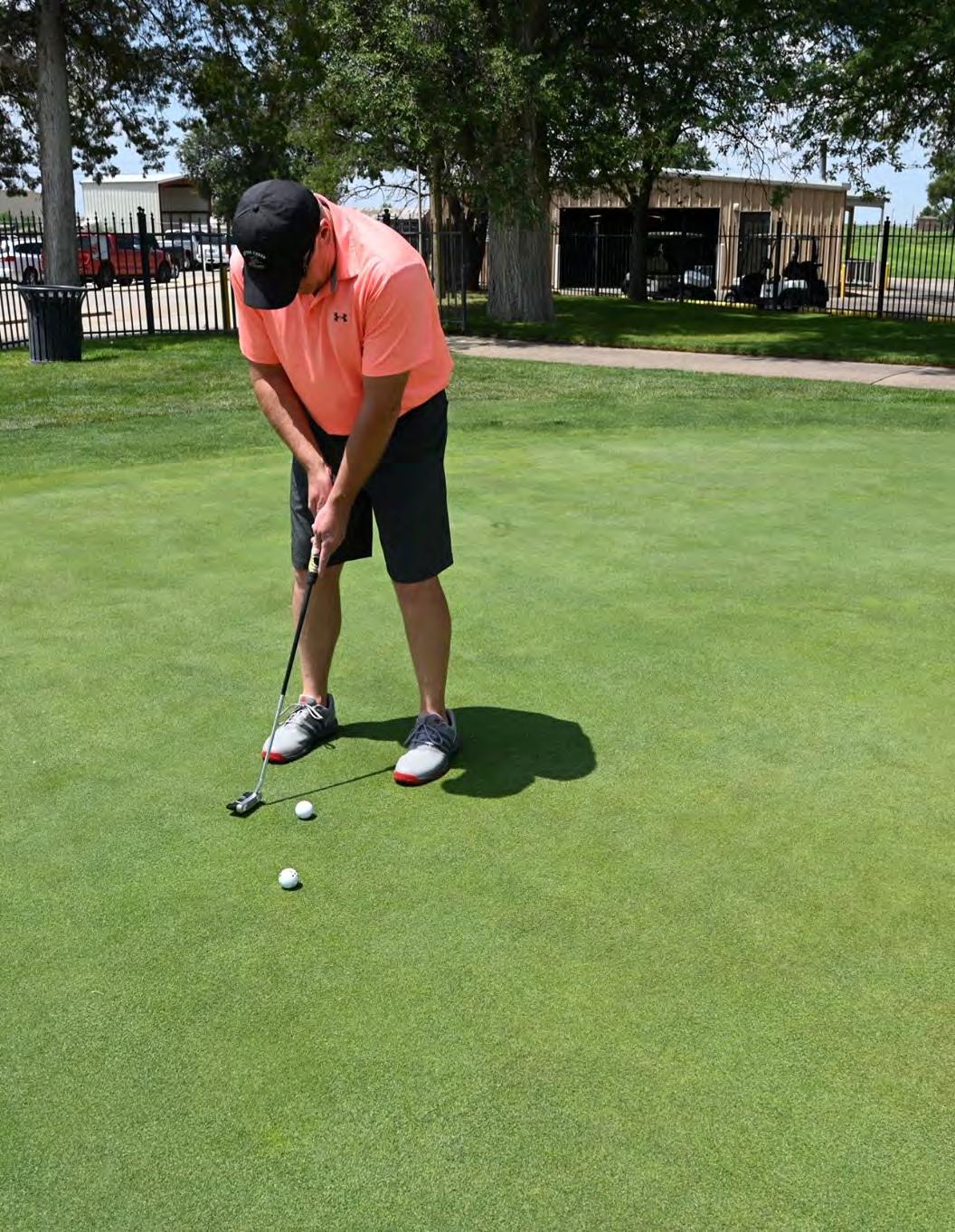
Through expected revisions to the Amarillo Zoning Ordinance (currently under final review), new residential subdivisions may be required to provide, through dedication or alternative means, neighborhood parks and community parks sufficient to meet the proportionate demand created by the subdivision and resulting development. Appendix E defines these requirements. It also identifies development guidelines that can be assigned costs and used to calculate and set fees in-lieu of land development.
If adopted as planned, the required mitigation must be sufficient to maintain the current level of service for Neighborhood Parks and Community Parks, including improvements for developed amenities and facilities. Based on the City’s current classification, neighborhood and community parks account for 43.4% of the City’s park acreage, providing a level of service of 5 acres per 1,000 residents (Table E-1). This total level of service is consistent with the City’s adopted standards for these park types, even though the acreage is distributed differently by park type.
Table E-1: Current Level of Service for Existing Neighborhood and Community Parks
***This includes the city’s acreage at City-owned school parks and jointly owned school parks. It does not count the School-District sites where the City maintained portion is unknown.
The Master Plan, however, recommends moving towards a re-aligned park system. It proposes a revised classification system that counts the City’s golf courses as regional-serving amenities. It distinguishes two subtypes of community parks and two sub-types for neighborhood parks, including school parks. Under this classification system, neighborhood and community parks account for 18.2% of the City’s park acreage, providing a level of service of 2.2 acres per 1,000 residents (Table E-1). This includes 1 acre per 1,000 residents for neighborhood parks, and 1. 2 acres per 1,000 residents for school parks.
Neither calculation reflects the fact that a portion of the City’s regional parks have been anticipated in the past to meet local needs.
* The existing level of service (LOS) is based on a 2020 population of 206,385.
**Total existing acreage in the City’s inventory is 2,401.2.
• Developers shall provide a minimum of 2.2 acres of developed park land per 1,000 residents for neighborhood and community parks.
• The City has discretion in how it divides this acreage between sub-types of parks. However:
o Small Neighborhood Parks in new developments should be approximately 2-3 acres in size.
o Large Neighborhood Parks should be approximately 5-7 acres in size.
o Multi-purpose Community Parks should be approximately 15-20 acres in size.
o Special Use Community Parks may vary in size based on its intended use.
• The City may collect any portion of this acreage in the form of fees in-lieu of park land. (See Manner of Compliance).
• Small Neighborhood Parks should be located not further than one (1) mile from any single family lot. The City shall strive to provide small neighborhood parks within one-half (1/2) mile from multi-family units on the proposed subdivision plat, as measured along public road or pedestrian ways.
• Large Neighborhood Parks should be located not further than two (2) miles from any lot on the proposed subdivision plat, as measured along public road or pedestrian ways.
• Community Parks (either multi-purpose or special use) should be located not further than four (4) miles from any lot on the proposed subdivision plat, as measured along public roads.
Small Neighborhood Parks must include the following amenities:
• Site infrastructure (grading, landscaping, irrigation, trees, utilities, open space improvements, sidewalks)
• Children’s play area for ages 2-12 (e.g., traditional play equipment, thematic or natural play elements, additional swings, climbers, diggers, etc.)
• Open turf play area
• 1 active recreation, fitness or healthy living amenity (e.g., a tricycle path, community garden, practice-quality youth sports field, or sports courts such as basketball, tennis, pickleball, futsal, badminton, or sepak takraw)
• Seating (benches, seatwalls, etc.)
• Social gathering space (e.g., 4 individual or grouped tables with at least half shaded; shelter, gazebo)
• Other low-maintenance amenity to support site character (e.g., art, tree grove, or natural area)
• Site identification and regulatory signage
• Comfort amenities (e.g., trash receptacles, bike racks, dog waste stations, fencing, etc., sufficient for size of site)
• On-street parking

Large Neighborhood Parks must include the following amenities:
• Site infrastructure (grading, landscaping, irrigation, trees, utilities, open space improvements, sidewalks)
• Thematic play structures (intended for ages 2-5 and 5-12)
• Open turf play area
• 2-3 sports courts (varied types)
• 1-2 full size rectangular and/or diamond ballfield (overlay is acceptable)
• Small, unique recreation feature (e.g., fitness equipment stations, skate spot, outdoor ping pong, climbing feature, community garden)
• Medium picnic shelter (4-6 tables)
• Access paths
• Site identification and regulatory signage
• Permanent or portable restrooms (TBD in negotiation with city, depending on site uses)
• Comfort amenities (e.g., trash receptacles, benches, bike racks, barbecues, dog waste stations, fencing, etc., sufficient for size of site)
• On- and off-street parking
• Integrated art

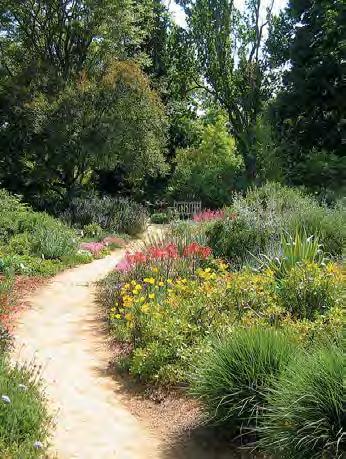
Multi-Purpose Community Parks must include the following amenities:
• Site infrastructure (grading, landscaping, irrigation, trees, lighting, utilities, open space improvements, sidewalks)
• Large thematic playground for ages 2-5 and 5-12 with inclusive play elements and shade
• Open turf play area
• 4-6 sports courts (lighted; four different; others may be paired)
• 2 full size rectangular fields (lighted; may be striped for multiple sports)
• 1 full size diamond ballfield (lighted; may include overlay)
• Large picnic shelter (12 tables, barbecue, food prep area, sink); additional 6-10 tables
• 2-4 additional recreation elements (e.g., splashpad, skatepark, disc golf course, outdoor fitness area, bike pump track, zip line, climbing spire)
• Dog park (separate area for large dogs and small dogs)
• Access paths and loop trail (walking/biking)
• Site identification and regulatory signage at each entry
• Comfort amenities (e.g., trash receptacles, benches, bike racks, barbecues, dog waste stations, fencing, etc., sufficient for size of site)
• Permanent restrooms and drinking fountains
• Off-street parking
• Art (may be integrated or standalone feature)
• Optional: a specialized facility (e.g., pool, nature center) may be negotiated in lieu of other sports and recreation facilities
Special Use Community Parks must include the following amenities:
• To be determined depending on site use. Amenities and facilities should be of the same value as those in multi-use community parks.
The preferred manner of complying with these dedication requirements is through the provision of:
• Improved Small Neighborhood Park within a proposed subdivision. The site will be dedicated to the City for ongoing maintenance following completion of park improvements.
• Improved Large Neighborhood Parks within two miles of proposed subdivision or the equivalent of in-lieu fees for City use in meeting nearby park needs. The site will be dedicated to the City for ongoing maintenance following completion of park improvements.
• Fees-in-lieu (monetary contributions) for Community Park land and amenity improvements, made by an applicant pursuant to a generally-applicable fee schedule.
• The City has discretion in how it divides the land requirement of 2.2 acres per 1,000 residents between sub-types of parks. For the calculation of fees in-lieu of developed park land, 1.2 acres per 1,000 is anticipated to reflect the value of community park development; 0.6 acres per 1,000 residents is anticipated to reflect the value of large neighborhood park development; and 0.4 acres per 1,000 is anticipated to reflect the value of small neighborhood park development. This is consistent with existing service levels.
At the applicant’s request, the City may approve compliance through other alternatives as noted in the City’s Dedication Ordinance. For example, improved acreage for Neighborhood Parks may remain in private ownership, by the property owner’s grant of an easement ensuring ongoing maintenance and continued public access to the land for the park purposes.

Parks and Recreation Master Plan
Our Parks + Our Community’s Future
APPENDICES | SEPTEMBER 2021






